A Place Called School: Prospects for the Future
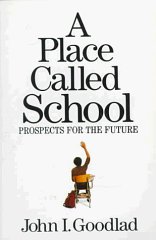 |
A Place Called School: Prospects for the Future
Author:
Goodlad, John I.
ISBN: 0-07-023627-5
LCCN:
Dewey:
Number:
|
Category: Schools
User Rating: 4.0 Stars
Pages:
416
Paperback McGraw-Hill Companies
Book Description This is an account of the largest on-the-scene study of U.S.
schools ever undertaken. Called 'A Study of Schooling' and carried on over 4
years, trained investigators went into more than 1,000 classrooms in 38
elementary and secondary schools in seven different sections of the United
States. These schools were located in urban, rural, and suburban areas. The
investigators talked to teachers, students, administrators, school board
officials, parents, and other members of the community. The result is this
landmark report, written by one of the country's most astute and experienced
educators. His message is one of cautious optimism, despite the extensive
problems uncovered, and he provides a realistic agenda for improvement. This
report will be a rich and stimulating resource for all those concerned with the
education of our youth. From the Back Cover
A landmark study from one of the nation's top educators
The Piaget Primer: Thinking, Learning, Teaching
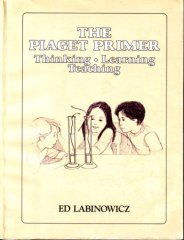 |
The Piaget Primer: Thinking, Learning, Teaching
Author:
Labinowicz, Ed
ISBN: 0-201-04090-5
LCCN:
80100370
Dewey: 370.15/2
Number:
|
Category: Philosophy of
education
User Rating: 5.0 Stars
Pages: 310
Paperback Dale Seymour Publications
From the Publisher 'Do children have anything to teach teachers? Jean Piaget
believes that they do. As a beginning teacher, I focused on elaborate
preparation of explanations and demonstrations on content. To piaget and his
co-workers I owe a special debt for their ingeneous methods of exploring
children's thinking and their theory of intellectual development. A study of
Piaget's work, together with direct observations of children, has been
instrumental in my transition to another stage of development as a teacher.' -Ed
Labinowicz Synopsis 'Do children have anything to teach teachers? Jean Piaget
believes that they do. As a beginning teacher, I focused on elaborate
preparation of explanations and demonstrations on content. To piaget and his
co-workers I owe a special debt for their ingeneous methods of exploring
children's thinking and their theory of intellectual development. A study of
Piaget's work, together with direct observations of children, has been
instrumental in my transition to another stage of development as a teacher.' -Ed
Labinowicz
Performance Standards V 3 - High School English Lish Language Arts,
Mathematics, Science, Applied Learning
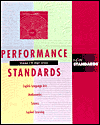 |
Performance Standards V 3 - High School English Lish Language Arts,
Mathematics, Science, Applied Learning
Author: Standards,
New
ISBN: 1-889630-53-5
LCCN:
97127549
Dewey:
Number:
|
Category:
Education
User Rating: 4.0 Stars
Pages: 178
Paperback Jossey-Bass Inc.,U.S.
Includes bibliographical references. v. 1. Elementary school -- v. 2. Middle
school -- v. 3. High school.
Performance Standards
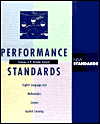 |
Performance Standards
Author: Standards, New New
Standards Organization Sta
ISBN: 1-889630-52-7
LCCN:
97127549
Dewey:
Number:
|
Category: Secondary
schools
User Rating: 4.0 Stars
Pages: 176
Paperback Jossey-Bass Inc.,U.S.
Includes bibliographical references. v. 1. Elementary school -- v. 2. Middle
school -- v. 3. High school.
Performance Standards
|
Performance Standards
Author: Standards, New New
Standards Organization Sta
ISBN: 1-889630-51-9
LCCN:
97127549
Dewey:
Number:
|
Category: Secondary
schools
User Rating: 4.0 Stars
Pages: 250
Paperback Jossey Bass Wiley
Includes bibliographical references. v. 1. Elementary school -- v. 2. Middle
school -- v. 3. High school.
Peer Talk in the Classroom: Learning from Research
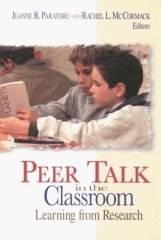 |
Peer Talk in the Classroom: Learning from
Research
Author: Paratore, Jeanne R. (Editor) McCormack,
Rachel L. (Editor) McCormick, Rachael L. McCormack, Rachel L.
ISBN: 0-87207-181-2
LCCN: 97027908
Dewey:
372.6 21
Number:
|
Category: Children
User Rating: 4.5
Stars
Pages: 256
Paperback International Reading Association
Book Description This book will help teachers and researchers uncover the
connections between what is known about language and literacy acquisition and
how teachers can create conditions for peer talk in a variety of settings. "Peer
Talk in the Classroom" sets itself apart from most texts because it describes
the research underlying the instructional practice and explains how the practice
was planned, implemented, and evaluated in a classroom setting. From the Back
Cover Teachers often initiate and control classroom activity. However, research
suggests that teachers would like to relinquish some of this control to
students, and many have accomplished this difficult task with notable success.
"Peer Talk in the Classroom: Learning From Research" is a collection of these
successes. This book is unique because it describes the research underlying the
instructional practice and explains how the practice was planned, implemented,
and evaluated in a classroom setting. This volume, which includes contributions
from both classroom teachers and university professors, will help teachers and
researchers uncover the connections between what is known about language and
literacy acquisition and how teachers can create conditions for peer talk in a
variety of settings. The book first focuses on students in classrooms where
peer-led discourse contributes to learning, explores the conflicts and
complexities that students confront as they engage in peer-led discussions, and
then shifts the focus to teachers and their role in supporting students'
opportunities to learn. "Peer Talk in the Classroom" will be a valuable resource
for all teachers and researchers looking for ways to increase student-initiated
interaction and to encourage oral discourse to support literacy learning.
The Pathfinder Project: Exploring the Power of One, Teacher's
Manual
|
The Pathfinder Project: Exploring the Power of One, Teacher's
Manual
Author: Marzano, Robert J. Paynter, Diane E. Doty,
Jane K.
ISBN: 0-9743142-0-X
LCCN:
Dewey:
Number:
|
Category:
Education & Teaching : Curricula, Education & Teaching : Study
Skills, Education & Teaching : Teaching
User Rating: 5.0
Stars
Pages: 346
Paperback Pathfinder Education, Inc.
Book Description "The Pathfinder Project: Exploring the Power of One,
Teacher's Manual," is a motivational educational curriculum designed to inspire
and uplift the students who undertake the project. Using inspirational
quotations and real-life stories as a foundation, The Pathfinder Project
encourages students to discover an important passion or dream, and take steps
toward realizing it. Decision-making skills, problem-solving skills, reading,
comprehension, journaling, and research are all components of learning along the
way. The Pathfinder Project is designed primarily for students in grades K-12,
but can be effectively employed in other settins such as correctional
facilities. Refer also to companion publication, "The Pathfinder Project:
Exploring the Power of One, Student Notebook," ISBN 0-9743142-1-8. About the
Author Robert J. Marzano, Ph.D. is recognized as an expert in the field of
education, having developed educational curricula for more than 30 years. The
Pathfinder Project is co-authored by colleagues Diane E. Paynter and Jane K.
Doty.
The Pathfinder Project: Exploring the Power of One, Student
Notebook
|
The Pathfinder Project: Exploring the Power of One, Student
Notebook
Author: Marzano, Robert J. Paynter, Diane E. Doty,
Jane K.
ISBN: 0-9743142-1-8
LCCN:
Dewey:
Number:
|
Category:
Education & Teaching : Curricula, Education & Teaching : Study
Skills, Education & Teaching : Teaching
User Rating: 5.0
Stars
Pages: 108
Paperback Pathfinder Education, Inc.
Book Description "The Pathfinder Project: Exploring the Power of One,
Teacher's Manual," is a motivational educational curriculum designed to inspire
and uplift the students who undertake the project. Using inspirational
quotations and real-life stories as a foundation, The Pathfinder Project
encourages students to discover an important passion or dream, and take steps
toward realizing it. Decision-making skills, problem-solving skills, reading,
comprehension, journaling, and research are all components of learning along the
way. The Pathfinder Project is designed primarily for students in grades K-12,
but can be effectively employed in other settins such as correctional
facilities. Refer also to companion publication, "The Pathfinder Project:
Exploring the Power of One, Teacher's Manual," ISBN 0-9743142-0-X.
A Passion for Teaching
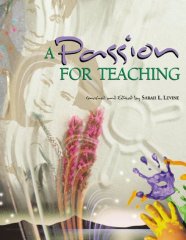 |
A Passion for Teaching
Author: Levine, Sarah L.
(Editor) McVay, Scott (Editor) Frost, Kit (Photographer)
ISBN:
0-87120-354-5
LCCN: 99006340
Dewey: 371.1
21
Number:
|
Category:
General
User Rating: 4.5 Stars
Pages: 209
Paperback Assn for Supervision&Curriculum
Book Description Teachers and educators at all levels and from every
discipline, along with everyone else who cares about teaching and learning, will
be moved by the impassioned words and the images expressed by teachers in these
pages. - In a poem about the first day of school, a 21-year veteran teacher of
3rd and 4th graders says he is still "so in awe of this moment / and these
children." -In an essay about teaching students with special needs, an
experienced 8th-grade teacher calls her students her "guardian angels." -A
secondary school music director calls music education a "lifetime sport," and
explains her philosophy: "What could be better than giving a 6th grader
something to be . . . proud of?" -A veteran arts educator created a brochure,
illustrated by her primary students, to persuade their state governor to
reinstate arts education funding. It worked. This book celebrates teachers and
teaching. Through stories, poems, plays and artwork, 42 experienced teachers
express their thoughts about students, other teachers and mentors, and the power
of teaching and learning. After years in the field, these teachers are still
excited, intrigued, and--yes--in love with teaching. They speak eloquently for
the many teachers everywhere who, despite the difficulties, wouldn't trade their
job for any other in the world.
Parent's Homework Dictionary [CD-ROM]
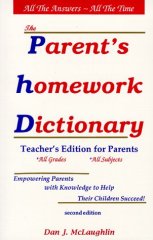 |
Parent's Homework Dictionary [CD-ROM]
Author:
McLaughlin, Dan McLaughlin, Dan J.
ISBN:
1-892565-10-2
LCCN:
Dewey:
Number:
|
Category: Family &
Relationships
User Rating: 5.0 Stars
Pages: 238
Paperback Damand Promotions
From the Publisher Reference book for parents to help their children with
homework. Synopsis Reference book for parents to help their children with
homework.
Outsmarting IQ: The Emerging Science of Learnable
Intelligence
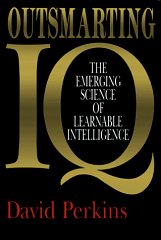 |
Outsmarting IQ: The Emerging Science of Learnable
Intelligence
Author: Perkins, David
ISBN:
0-02-925212-1
LCCN: 94045954
Dewey: 153.9
20
Number:
|
Category:
Educational Psychology
User Rating: 4.0 Stars
Pages:
390
Hardcover Free Press
Review Israel Scheffler Harvard University A brilliant and also a hopeful
book about learnable -- and even teachable -- intelligence. Everyone concerned
with finding a path through the IQ wars -- and that means parents and
policymakers as well as teachers -- ought to read this book by a master
educator. Book Description Since the turn of the century, the idea that
intellectual capacity is fixed has been generally accepted. But increasingly,
psychologists, educators, and others have come to challenge this premise.
Outsmarting IQ reveals how earlier discoveries about IQ, together with recent
research, show that intelligence is not genetically fixed. Intelligence can be
taught. David Perkins, renowned for his research on thinking, learning, and
education, identifies three distinct kinds of intelligence: the fixed
neurological intelligence linked to IQ tests; the specialized knowledge and
experience that individuals acquire over time; and reflective intelligence, the
ability to become aware of one's mental habits and transcend limited patterns of
thinking. Although all of these forms of intelligence function simultaneously,
it is reflective intelligence, Perkins shows, that affords the best opportunity
to amplify human intellect. This is the kind of intelligence that helps us to
make wise personal decisions, solve challenging technical problems, find
creative ideas, and learn complex topics in mathematics, the sciences,
management, and other areas. It is the kind of intelligence most needed in an
increasingly competitive and complicated world. Using his own pathbreaking
research at Harvard and a rich array of other sources, Perkins paints a
compelling picture of the skills and attitudes underlying learnable
intelligence. He identifies typical pitfalls in multiple perspectives, and
neglecting evidence. He reveals the underlying mechanisms of intelligent
behavior. And he explores new frontiers in the development of intelligence in
education, business, and other settings. This book will be of interest to people
who have a personal or professional stake in increasing their intellectual
skills, to those who look toward better education and a more thoughtful society,
and not least to those who follow today's heated debates about the nature of
intelligence.
Outrageous Pursuits: Man, Many Outrageous Activities to Enhance a Positive
Learning Environment
|
Outrageous Pursuits: Man, Many Outrageous Activities to Enhance a
Positive Learning Environment
Author: John Dyer
ISBN: 0-9686632-0-9
LCCN:
Dewey:
Number:
|
Category:
User Rating: Pages: 0
HeadSmart, Inc
The One Minute Teacher: How to Teach Others to Teach
Themselves
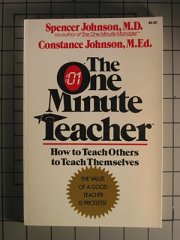 |
The One Minute Teacher: How to Teach Others to Teach
Themselves
Author: Johnson, Spencer Johnson, Spencer
ISBN: 0-688-06139-7
LCCN: 86012553
Dewey:
371.3/028/14 19
Number:
|
Category: Teaching
User Rating: 4.0
Stars
Pages: 112
Paperback William Morrow & Company
Product Description This invaluable book shows how teachers, despite the many
difficultiesthey face in today's school systems, can make an important
contributionto their students' lives and educations. Johnson and Johnson
describehow the use of Goal Setting, Praising, and Recovery
reinforcesself-esteem and creates a new kind of learning process that will
becomelifelong. The One Minute Teacher reveals simple, positive ways to Discover
and instill the love of learning Foster success and achievement Feel more
confident and happy Bring out the best in ourselves and others Practical, wise,
and useful in dozens of everyday situations, The OneMinute Teacher is essential
reading for anyone who teaches and anyonewho learns. More than eleven million
copies of Dr. Johnson's books are in use intwenty-four languages. --This text
refers to the Paperback edition. About the Author Ken Blanchard, chairman of The
Ken Blanchard Companies, is the co-author of The One Minute Manager and eleven
other bestselling books. His books have combined sales of more than 12 million
copies in more than 25 languages. He lives in San Diego, California. --This text
refers to the Paperback edition.
On the Death of Childhood and the Destruction of Public Schools: The Folly
of Today's Education Policies and Practices
 |
On the Death of Childhood and the Destruction of Public Schools:
The Folly of Today's Education Policies and Practices
Author:
Bracey, Gerald W.
ISBN: 0-325-00602-4
LCCN:
2003011650
Dewey: 371.01/0973 21
Number:
|
Category: Educational
administration
User Rating: 5.0 Stars
Pages: 208
Paperback Heinemann
Product Description "contrarian" "professional outsider" "a sore loser"
"another member of the Flat Earth Society" "a national treasure" "a modern Don
Quixote" "a skeptic's joy!" No matter what he's called, Gerald Bracey IS public
schools' best defender. And in this book, he uses his considerable writing and
research skills on their behalf. With authority, sensitivity, and a good sense
of humor, he dismantles the negative PR our public education system has endured
and does it with hardcore data, not phony "science." Bracey delivers the
statistics and skillful analysis needed to win the numbers game that plays out
daily in the popular press. Drawing on data from a variety of reputable sources,
he proves that public schools are doing much better than critics claim, some
indicators even showing record highs. He takes on the testing movement in
numerous chapters, offers data that provide different perspectives than usually
seen, and reviews the history of public schools, showing how they have included
more and more students while raising achievement levels, too. He questions the
so-called "failing schools," discusses the phenomenon of "summer loss," provides
international comparisons, and presents data to argue that investing in
universal quality preschool pays off in the long run. He even attempts to enter
the mind of the father of American public education, Horace Mann, to see what he
might think about the "nuttiness of today's policies." Bracey believes that our
only hope to save the public school system is for teachers, teacher educators,
and administrators to help speed up the needed perspective transformation. And
they can begin to do it by reading this book and resuming their rightful
position in educating students. About the Author Since 1984 Gerald W. Bracey has
written a monthly column for Phi Delta Kappan making research accessible to
teaching practitioners. In 2003 the column received the Interpretive Scholarship
Award from the American Educational Research Association. Bracey spends about
half his time as an independent researcher and writer and splits the rest
between George Mason University and the High/Scope Educational Research
Foundation. He has a Ph.D. in developmental psychology from Stanford University
and has held positions in private firms, local school districts, universities,
and state departments of education.
On Equal Terms: How to Make the Most of Learning Contracts in Grades
49
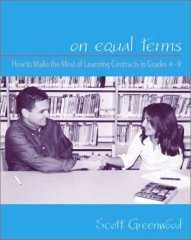 |
On Equal Terms: How to Make the Most of Learning Contracts in
Grades 49
Author: Greenwood, Scott C.
ISBN:
0-325-00493-5
LCCN: 2002151786
Dewey: 371.139
21
Number:
|
Category:
Educational administration
User Rating: 3.0 Stars
Pages:
144
Paperback Heinemann
Product Description With thoughtful teacher guidance, children can be trusted
to make good choices. So believes Scott Greenwood and in this book he tells why
he believes the teacher-student contract is a good thing. A teaching veteran, he
has used learning contracts successfully with his own middle school students.
Beginning with his first year of teaching, he entered into a contract in which
four students "taught" a novel. They led discussions, assigned chapters, chose
important vocabulary, wrote the final test, and were responsible for assessment.
Most important, they were engaged. In this unique handbook for middle-level
teachers, Greenwood provides the practical wherewithal to implement learning
contracts, along with the inspiration and theory to convince us of their value.
He takes us into his classroom and explains contracts inside and out: how to get
started how to be smart about organizing and managing how to maximize benefits
through a flexible approach how to respond to students needing extra support.
Greenwood's warmth and lively style, his "teacher-down-the-hall" wisdom and
no-nonsense advice make it clear why his learning contracts have been so
successfuland why they can work for us, too. Get students active and engaged in
their learning. Give them a measure of choice and control. Actually gain more
power by gradually relinquishing it. Just sign learning contractsthen watch as a
new kind of teaching and learning begins. About the Author As an elementary
reading specialist, a middle-level teacher of reading and language arts, a
secondary English teacher, and self-professed word junkie, Dr. Scott C.
Greenwood has taught a variety of literacy subjects to a diverse audience over
the years. He is an assistant professor of literacy at West Chester University
On Common Ground: The Power of Professional Learning
Communities
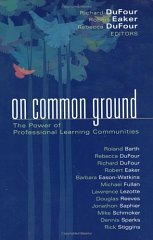 |
On Common Ground: The Power of Professional Learning
Communities
Author: Dufour, Richard (Editor) Eaker, Robert
(Editor) DuFour, Rebecca (Editor) Eaker, Robert Dufour, Rebecca
ISBN: 1-932127-42-9
LCCN:
Dewey:
Number:
|
Category:
Administration - General
User Rating: 3.0 Stars
Pages:
254
Hardcover Solution Tree
Mike Schmoker, February, 2005 "The stakes are hig, but success could enable
us to reach levels of quality, equity, and achievement," Product Description On
Common Ground provides a valuable tool for educators who are doing the hard work
of improving their schools. This resource offers teachers and administrators a
coherent conceptual framework and specific, practical strategies for moving
forward with their improvement efforts. Any listing of North America s leading
authorities on school improvement would include the authors in this book. These
authors agree on many of the best strategies for raising student achievement and
support the premise that students would be better served if educators: Β·
Embrace learning rather than teaching as their school s mission Β· Work
collaboratively to help all students learn Β· Use formative assessments and a
focus on results to foster continuous improvement Β· Assume individual
responsibility to take steps to create such schools Although they stand on this
common ground, clear differences emerge regarding their perspectives on the most
effective strategy for making professional learning communities the norm in
North America. The differences, however, focus on the means rather than the end.
These educational leaders have found common ground in expressing their belief in
both the desirability and the power of professional learning communities.
On Becoming a School Leader: A Person-Centered
Challenge
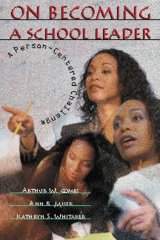 |
On Becoming a School Leader: A Person-Centered
Challenge
Author: Combs, Arthur W. Miser, Ann B. Whitaker,
Kathryn S.
ISBN: 0-87120-336-7
LCCN:
98058054
Dewey: 371.2 21
Number:
|
Category: Administration
- General
User Rating: 4.0 Stars
Pages: 231
Paperback Association for Supervision & Curriculum Deve
Book Description The work of educational leaders depends on relationships
with people--faculty and staff members, students, other administrators, parents,
and community members. This book presents a new way of viewing leadership: how
to become person-centered leaders. Rather than relying on outdated ways of
managing schools, principals and other leaders must take up the challenge of
paying attention to the people issues of the school. Through many examples, the
authors show how school leaders must - consciously seek the appropriate type of
data to respond to; - increase their capacity for empathy; - develop healthy
personal self-concepts; and - learn how to develop healthy self-concepts in
others, both students and teachers. School leaders also should be committed to a
broad purpose for schooling, should be informed about how their beliefs and
behavior influence the organization of the school, and should be able to
participate in interactions with authenticity. They also must be able to help
create authenticity in their school organizations. In these ways, school leaders
will create schools that are learning organizations for everyone. Universities
that prepare future school leaders should spend more time developing leaders who
are person centered in their approach to leading schools. This new way of
thinking will require leader preparation programs to change their priorities for
curriculum, academic activities, and field experiences.
The Nurturing Classroom: Developing Thinking Skills, Self Esteem
Responsibility
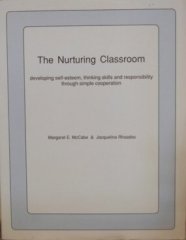 |
The Nurturing Classroom: Developing Thinking Skills, Self Esteem
Responsibility
Author: McCabe, Margaret E. Rhoades,
Jacqueline
ISBN: 0-933935-09-9
LCCN:
88081501
Dewey: 371.1/02 20
Number:
|
Category: Classroom
Management
User Rating: 5.0 Stars
Pages: 339
Paperback Ita Pubns
Bibliography: p. 327-332. Includes index.
Now, Discover Your Strengths
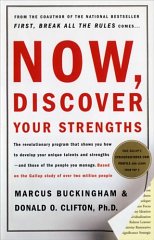 |
Now, Discover Your Strengths
Author: Buckingham,
Marcus Clifton, Donald O. Clifton, Donald O.
ISBN:
0-7432-0114-0
LCCN: 00053572
Dewey: 658.4/09
22
Number:
|
Category:
Advice on careers & achieving success
User Rating: 4.0
Stars
Pages: 272
Hardcover Free Press
Amazon.com's Best of 2001 Effectively managing personnel--as well as one's
own behavior--is an extraordinarily complex task that, not surprisingly, has
been the subject of countless books touting what each claims is the true path to
success. That said, Marcus Buckingham and Donald O. Clifton's Now, Discover Your
Strengths does indeed propose a unique approach: focusing on enhancing people's
strengths rather than eliminating their weaknesses. Following up on the
coauthors' popular previous book, First, Break All the Rules, it fully describes
34 positive personality themes the two have formulated (such as Achiever,
Developer, Learner, and Maximizer) and explains how to build a "strengths-based
organization" by capitalizing on the fact that such traits are already present
among those within it. Most original and potentially most revealing, however, is
a Web-based interactive component that allows readers to complete a
questionnaire developed by the Gallup Organization and instantly discover their
own top-five inborn talents. This device provides a personalized window into the
authors' management philosophy which, coupled with subsequent advice, places
their suggestions into the kind of practical context that's missing from most
similar tomes. "You can't lead a strengths revolution if you don't know how to
find, name and develop your own," write Buckingham and Clifton. Their book
encourages such introspection while providing knowledgeable guidance for
applying its lessons. --Howard Rothman From Library Journal The premise of this
new management study, a follow-up to Buckingham's First, Break All the Rules (S.
& S., 1999), is that the most effective method for motivating people is to
build on their strengths rather than correcting their weaknesses. The authors,
researchers at the Gallup Organization, have analyzed results of interviews
conducted by Gallup of over 1.7 million employees from 101 companies and
representing 63 countries. When asked, only 20 percent of these employees stated
that they were using their strengths everyday. So that they can take a test
revealing their strengths, readers are given access to the StrengthsFinder web
site and a special ID number; once they learn their profile, they can read the
analysis in the book. A description of each type is included, together with case
studies, and managers are shown how to handle various types. This book offers a
unique perspective on successful management strategy and developing employees'
strengths. Recommended especially for public libraries, which should also
consider Buckingham's First, Break All the Rules; students of business
administration may also wish to consult this book.DLucy Heckman, St. John's
Univ. Lib., Jamaica, NY Copyright 2001 Reed Business Information, Inc.
Nongradedness
 |
Nongradedness
Author: H., Anderson Robert Pavan,
Barbara N.
ISBN: 0-87762-980-3
LCCN:
92062813
Dewey: 371.2/54 20
Number:
|
Category: Teaching skills
& techniques
User Rating: 5.0 Stars
Pages: 260
Paperback ScarecrowEducation
Product Description This best-selling guide to creating and maintaining
nongraded schools offers innovative policies, actions and procedures as well as
strong theoretical support in the theory, research, planning, practices, and
management of nongraded education.
The Nongraded Elementary School
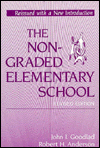 |
The Nongraded Elementary School
Author: Goodlad, John
I. Anderson, Robert H.
ISBN: 0-8077-2845-4
LCCN:
86030055
Dewey: 372.12/54 19
Number:
|
Category: Examinations
& assessment
User Rating: 5.0 Stars
Pages: 296
Paperback Teachers College Pr
Bibliography: p. 227-244. Includes index.
The New Basics: Education and the Future of Work in the Telematic
Age
 |
The New Basics: Education and the Future of Work in the Telematic
Age
Author: Thornburg, David D.
ISBN:
0-87120-656-0
LCCN: 2001008540
Dewey: 371.3
21
Number:
|
Category:
Administration - General
User Rating: 4.5 Stars
Pages:
119
Paperback Association for Supervision & Curriculum Deve
From Library Journal Thornburg, an emerging-technologies futurist, takes a
critical look at education in the United States and how children are taught in a
system designed to prepare them for an industrial-era economy rather than our
present "knowledge-value era." Drawing on his experience and knowledge to
examine trends and make informed assumptions about what the future workplace
will be, he asserts that students must be prepared for the new era, in which
product value is based more on intellectual content than material and where
workers are not interchangeable components on a production line but instead
contribute to production through their creativity and knowledge. Workers will
continue the trend of operating like consultants and will need to upgrade their
knowledge and skills through lifelong learning to support their nomadic
lifestyle. The final chapter offers practical strategies for garnering community
support for curriculum change and effecting change within schools. Parents,
administrators, teachers, policymakers, and anyone interested in education will
find this book engaging and useful. Recommended for school, public, and academic
libraries. Mark Alan Williams, Web Lib. & Document Storage Svcs., Hines VA
Hosp., Chicago Copyright 2002 Reed Business Information, Inc. Book Description
The increasing globalization of work--coupled with rapid advancements in
communications technology--is making age-old teaching methods irrelevant. To
thrive in the plugged-in future workplace, students today need to learn a whole
new set of fundamental skills. According to David Thornburg, we are on the cusp
of a completely new era. The conventions of interoffice hierarchies, deskbound
workers, and long-term employment contracts will quickly give way to a
"telematic" model of work, in which workers are free to hop from client to
client and country to country at the speed of a DSL connection. Today's
curriculum is predicated on yesterday's realities, and must be reexamined to
better reflect the digital age. This book explores The foundations of the future
economy, The characteristics needed to succeed in the emerging world, and The
changes we need to make in education to ensure that all students leave school
prepared to face the challenges of a redefined world. The New Basics: Education
and the Future of Work in the Telematic Age provides an in-depth discussion of
the skills necessary for professional success in the coming years, along with
strategies on how best to teach them in the classroom. Filled to capacity with
visionary observations, practical suggestions for innovative instruction, and
engaging discussions of the historical precedents for remodeled curriculum, this
book is essential for those seeking to address the pressing issues of the new
millennium.
Multiple Intelligences: The Theory In Practice, A
Reader
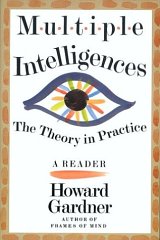 |
Multiple Intelligences: The Theory In Practice, A
Reader
Author: Gardner, Howard
ISBN:
0-465-01822-X
LCCN:
Dewey:
Number:
|
Category: Educational
Psychology
User Rating: 4.0 Stars
Pages: 320
Paperback Basic Books
From Publishers Weekly A follow-up to Gardner's Frames of Mind (which is
being reissued simultaneously), this collection of mostly academic essays should
appeal mainly to education observers concerned with Gardner's innovative theory
of multiple intelligences. The theory that there are seven types of
intelligence, (linguistic, spatial, musical and so on) is recapped in an
accessible talk Gardner gave at Harvard, a more formal paper on the subject, and
a technical essay defining such concepts as "giftedness" and "creativity" in the
context of his theory. The book's second part includes Gardner's intriguing
projection of a school that applies his theories, as well as four very dry
analyses of projects that put Gardner's theories into practice. More interesting
are Gardner's criticism of formal testing directed at a unitary conception of
intelligence, his proposal that college admissions officers examine student
projects for evidence of several intelligences and the suggestion that various
topics in school can be approached in different ways that track the multiple
intelligences. Reader's Subscription, Library of Science and Natural Science
Book Club alternates. Copyright 1993 Reed Business Information, Inc. --This text
refers to an out of print or unavailable edition of this title. From Library
Journal The theory of multiple intelligences (MI) was first publicized by
Gardner in Frames of Mind ( LJ 10/1/83). The arguments he presented against the
prevailing one-dimensional view of intelligence caught the attention of
educators who found the application of a universal IQ test troublesome. Here,
Gardner attempts to bridge the gap between state-of-the-art advances in
cognitive studies and neurosciences and to demonstrate their practical
applications in education. He does an admirable job of explaining the
revolutionizing effect the complex theory of seven intelligences has had on
schooling, also acknowledging that Theodore Sizer's Horace's School ( LJ 1/92)
presents a practical proposal closely paralleling his MI theory in its emphasis
on individual performance abilities. This is a highly readable and interesting
proposal from an innovative and ground-breaking researcher. Excellent references
round out the study. For most education collections. - Arla Lindgren, St. John's
Univ., New York Copyright 1993 Reed Business Information, Inc. --This text
refers to an out of print or unavailable edition of this title.
The Multiple Intelligences of Reading and Writing: Making the Words Come
Alive
 |
The Multiple Intelligences of Reading and Writing: Making the Words
Come Alive
Author: Armstrong, Thomas
ISBN:
0-87120-718-4
LCCN: 2002154699
Dewey: 372.6
21
Number:
|
Category:
Language & Linguistics
User Rating: 5.0 Stars
Pages:
160
Paperback Association for Supervision & Curriculum Deve
Book Description We normally think of reading and writing as skills that are
a part of linguistic intelligence. In The Multiple Intelligences of Reading and
Writing: Making the Words Come Alive, Thomas Armstrong shows how involving the
other seven intelligences-logical-mathematical, spatial, bodily-kinesthetic,
musical, interpersonal, intrapersonal, and naturalistic-will help students
acquire reading and writing skills, especially those students who are not
particularly strong in linguistic intelligence. The Multiple Intelligences of
Reading and Writing appeals to all educators who work with reading and writing
skills, from the preschool teacher leading the class in phonemic awareness
activities to the post-graduate professor helping students examine kinesthetic
imagery in Shakespeare's plays. The book combines Howard Gardner's MI theory and
recent brain research on reading and writing with historical, anthropological,
biographical, and psychological perspectives on literacy. Armstrong pulls the
research together to show you how to engage students by infusing the study of
words with imagery, logic, oral language, physical activity, emotion, music,
social involvement, and nature experiences. Armstrong provides hundreds of
ideas, strategies, tips, and resources for teaching everything from grammar and
spelling to word decoding and reading comprehension. His strategic approach
synthesizes the best reading and writing methods for application in preK-12
classrooms, literacy programs, speech and language pathology groups, one-to-one
tutoring sessions, and all other settings where words are the focus of learning.
Armstrong shows you how to empower your students with literacy skills for life.
Download Description We normally think of reading and writing as skills that are
a part of linguistic intelligence. In The Multiple Intelligences of Reading and
Writing: Making the Words Come Alive, Thomas Armstrong shows how involving the
other seven intelligences-logical-mathematical, spatial, bodily-kinesthetic,
musical, interpersonal, intrapersonal, and naturalistic-will help students
acquire reading and writing skills, especially those students who are not
particularly strong in linguistic intelligence. The Multiple Intelligences of
Reading and Writing appeals to all educators who work with reading and writing
skills, from the preschool teacher leading the class in phonemic awareness
activities to the post-graduate professor helping students examine kinesthetic
imagery in Shakespeare's plays. The book combines Howard Gardner's MI theory and
recent brain research on reading and writing with historical, anthropological,
biographical, and psychological perspectives on literacy. Armstrong pulls the
research together to show you how to engage students by infusing the study of
words with imagery, logic, oral language, physical activity, emotion, music,
social involvement, and nature experiences. Armstrong provides hundreds of
ideas, strategies, tips, and resources for teaching everything from grammar and
spelling to word decoding and reading comprehension. His strategic approach
synthesizes the best reading and writing methods for application in preK-12
classrooms, literacy programs, speech and language pathology groups, one-to-one
tutoring sessions, and all other settings where words are the focus of learning.
Armstrong shows you how to empower your students with literacy skills for life.
Multiple Intelligences in the Classroom
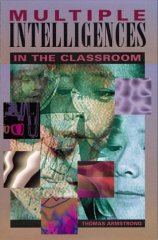 |
Multiple Intelligences in the Classroom
Author:
Armstrong, Thomas Curricul, Association for Supervision and
ISBN: 0-87120-230-1
LCCN: 94014325
Dewey:
370.15/23 20
Number:
|
Category: Educational Psychology
User Rating: 4.5
Stars
Pages: 185
Paperback Association for Supervision & Curriculum Deve
Book Description "To respect the many differences between people"--this is
what Howard Gardner says is the purpose of learning about multiple intelligences
(MI). Now, in the 2nd edition of "Multiple Intelligences in the Classroom,"
Thomas Armstrong has updated his best-selling practical guide for educators, to
incorporate new research from Gardner and others. Gardner's original studies
suggested that the mind comprises seven intelligences--linguistic,
logical-mathematical, spatial, bodily-kinesthetic, musical, interpersonal, and
intrapersonal. This new edition includes information on the eighth intelligence
(the naturalist), a chapter on a possible ninth intelligence (the existential),
and updated information and resources throughout the text to help educators at
all levels apply MI theory to curriculum development, lesson planning,
assessment, special education, cognitive skills, educational technology, career
development, educational policy, and more. The book includes dozens of practical
tips, strategies, and examples from real schools and districts--as well as solid
outcomes of MI, including improved test scores and discipline. Armstrong
provides tools, resources, and ideas that educators can immediately use to help
students of all ages achieve their fullest potential in life. Thomas Armstrong,
an educator and psychologist from Sonoma County, California, has more than 27
years of teaching experience, from the primary through the doctoral level. He is
the author of two other ASCD books, "Awakening Genius in the Classroom" and
"ADD/ADHD Alternatives in the Classroom." --This text refers to the Paperback
edition. Download Description "To respect the many differences between
people"--this is what Howard Gardner says is the purpose of learning about
multiple intelligences (MI). Now, in the 2nd edition of Multiple Intelligences
in the Classroom, Thomas Armstrong has updated his best-selling practical guide
for educators, to incorporate new research from Gardner and others. Gardner's
original studies suggested that the human mind is composed of seven
intelligences--linguistic, logical-mathematical, spatial, bodily-kinesthetic,
musical, interpersonal, and intrapersonal. This new edition includes information
on the eighth intelligence (the naturalist), a chapter on a possible ninth
intelligence (the existential), and updated information and resources throughout
the text to help educators at all levels apply MI theory to curriculum
development, lesson planning, assessment, special education, cognitive skills,
educational technology, career development, educational policy, and more. The
book includes dozens of practical tips, strategies, and examples from real
schools and districts. Armstrong provides tools, resources, and ideas that
educators can immediately use to help students of all ages achieve their fullest
potential in life. Thomas Armstrong, an educator and psychologist from Sonoma
County, California, has more than 27 years of teaching experience, from the
primary through the doctoral level. He is the author of two other ASCD books,
Awakening Genius in the Classroom and ADD/ADHD Alternatives in the Classroom.
Multiple Intelligences and Student Achievement: Success Stories from Six
Schools
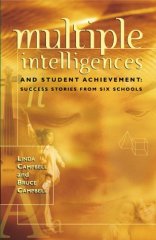 |
Multiple Intelligences and Student Achievement: Success Stories
from Six Schools
Author: Campbell, Linda Campbell, Bruce
Campbell, Bruce
ISBN: 0-87120-360-X
LCCN:
99006910
Dewey: 370.15/2 21
Number:
|
Category:
Education
User Rating: 5.0 Stars
Pages: 108
Paperback Association for Supervision & Curriculum Deve
Book Description Finally, a book about multiple intelligences (MI) theory
that answers the questions that all educational innovations must ultimately
address: "What are the results on student achievement?" "How were those results
achieved?" This book describes six schools that have used MI theory for five or
more years. Through case studies of two elementary, two middle-level, and two
high schools, Linda and Bruce Campbell illustrate why markedly different schools
large and small, rich and poor, inner-city and suburban looked to MI when they
wanted to boost student learning. In schools with long-term MI programs,
achievement gains are impressive; in fact, the disparity between white and
minority students is reduced or eliminated. Students at all three levels
outperform their district, county, and national peers in basic skills. Such
gains are possible even though teachers do not teach to standardized and state
assessment tests. Instead, they believe that all students have strengths, and,
as a result, students come to believe in themselves as well. Moreover, teachers
have discovered that instruction through multiple intelligences is so positive
and engaging that students--all students can't help but learn. This book
provides educators who are new to MI theory with solid achievement data and
curricular formats to support, inform, and inspire their work. Those who have
already worked with MI theory will find encouragement to continue and
suggestions for refining their efforts.
Multiage Portraits: Teaching and Learning in Mixed-Age
Classrooms
 |
Multiage Portraits: Teaching and Learning in Mixed-Age
Classrooms
Author: Bingham, Anne Dorta, Peggy McClaskey,
Molly Okeefe Rathbone, Charles (Editor)
ISBN:
0-9627389-7-2
LCCN: 93073913
Dewey: 371.2/54
20
Number:
|
Category:
Administration - General
User Rating: 5.0 Stars
Pages:
185
Paperback Not Avail
Includes bibliographical references (p. 184-185).
Multiage Classrooms: The Ungrading of America's Schools : Multiageresource
Book
|
Multiage Classrooms: The Ungrading of America's Schools :
Multiageresource Book
Author: Sumner, Deborah (Editor)
ISBN: 0-9627389-6-4
LCCN: 93191076
Dewey:
371.2/54 20
Number:
|
Category: Handbooks, manuals, etc
User Rating: 5.0
Stars
Pages: 14
Paperback Staff Development for Educators
Cover title. Includes index.
The Multi-age Classroom
|
The Multi-age Classroom
Author: Bev Maeda
ISBN:
LCCN:
Dewey:
Number:
|
Category: User
Rating: Pages: 0
Creative Teaching Press
The Multi-age Classroom
|
The Multi-age Classroom
Author: Bev Maeda
ISBN:
LCCN:
Dewey:
Number:
|
Category: User
Rating: Pages: 0
Spiral-bound Creative Teaching Press
Motivating Students and Teachers in an Era of Standards
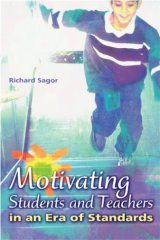 |
Motivating Students and Teachers in an Era of
Standards
Author: Sagor, Richard
ISBN:
0-87120-801-6
LCCN: 2003015999
Dewey: 370.15/4
22
Number:
|
Category:
Educational Psychology
User Rating: 4.5 Stars
Pages:
152
Paperback Association for Supervision & Curriculum Deve
Book Description Are you dragging yourself into school each morning? Are your
students complaining about schoolwork and classes? Does the task of meeting
mandated standards seem overwhelming? If you aren't excited about school, or
your students don't seem eager to learn, consider whether you're missing one or
more of these essential motivational factors: competence, belonging, usefulness,
potency, optimism. In this book, Richard Sagor describes how these qualities
contribute to every person's well-being and what you can do to develop them in
yourself and your students-regardless of their previous school experiences or
socioeconomic background. Step-by-step instructions offer ways to make teaching
and learning more emotionally and intellectually satisfying for everyone. The
result is an environment in which staff and students alike are ready and willing
to do the hard work necessary for success. Motivating Students and Teachers in
an Era of Standards is a practical guide for teachers, principals, and other
instructional leaders who want to take positive steps to help everyone in the
school be more successful, more motivated, and more satisfied with their work.
Sagor is director of the Institute for the Study of Inquiry in Education. He is
the author of How to Conduct Collaborative Action Research and Guiding School
Improvement with Action Research.
The Morning Meeting Book
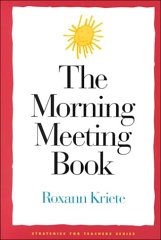 |
The Morning Meeting Book
Author: Kriete, Roxann
ISBN: 1-892989-00-X
LCCN: 98068612
Dewey:
Number:
|
Category:
Elementary
User Rating: 5.0 Stars
Pages: 176
Paperback Northeast Fndtn for Children
New Teacher Magazine, Spring 2001 "Top-Notch Book" --This text refers to the
Paperback edition. Product Description Morning Meeting is a powerful teaching
tool for building community, increasing student investment, and improving
academic and social skills. This comprehensive guidebook has helped thousands of
teachers across the country use Morning Meeting to launch their school days. The
expanded edition offers: Step-by-step guidelines for implementing Morning
Meeting in any K-8 classroom Clear explanations of purposes 45 greetings, 66
group activities, and many samples of morning message charts Frequently asked
questions and answers?? A chapter on implementing Morning Meeting in middle
schools Ideas for adapting Morning Meeting for use with second language learners
--This text refers to the Paperback edition.
More Strategies for Educating Everybody's Children
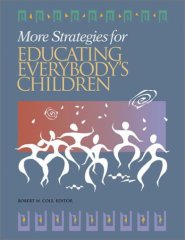 |
More Strategies for Educating Everybody's
Children
Author: Panel, Ascd Improving Student Achievement
Research (Corporate Author) Cole, Robert W. (Editor)
ISBN:
0-87120-501-7
LCCN: 00012067
Dewey: 371.3
21
Number:
|
Category:
Administration - General
User Rating: 5.0 Stars
Pages:
151
Paperback Association for Supervision & Curriculum Deve
Book Description More Strategies for Educating Everybody's Children offers
educators just that -- strategies to use in reaching and teaching diverse
learners. The strategies are based on research and practice; they have been
tested and proven to improve achievement. More Strategies for Educating
Everybody's Children is a companion to Educating Everybody's Children: Diverse
Strategies for Diverse Learners. Each volume provides practical strategies
teachers can immediately use to enhance student performance at all levels. The
books are founded on the belief that all children can learn and that it is our
responsibility to teach them. As our schools grow more diverse, educators must
employ new methods to stimulate, motivate, and inspire students to succeed. The
teaching techniques and strategies described in this book can improve the
quality of instruction for and performance of everybody's children. Experts in
working with minority, homeless, and immigrant students focus on meeting needs
that are unique to those students; those strategies also benefit the other
students. In addition, subject experts offer their knowledge by sharing their
techniques for teaching science, geography, civics, and history at every grade
level and for all types of learners. Each chapter presents multiple strategies;
examples of each strategy in the classroom; and the extensive research that led
to the development of each strategy. Both volumes of Educating Everybody's
Children describe the best practices and most effective instructional methods
available. Putting these practices into action can help students become
contributing members of their communities.
The Moral Imperative of School Leadership
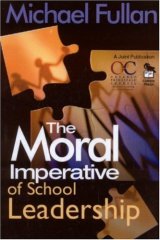 |
The Moral Imperative of School Leadership
Author:
Fullan, Michael
ISBN: 0-7619-3873-7
LCCN:
2003000010
Dewey: 371.2/012 21
Number:
|
Category: Organization
& management of education
User Rating: 3.0 Stars
Pages:
112
Paperback Corwin Press
Review "Fullan challenges all who work in education to rethink the critical
role of the principal as school leader in the current era of accountability.
With clarity and insight, he offers a series of strategies to reshape the
culture and context of leadership in schools to create learning communities
where both students and teachers can excel." (Paul D. Houston, Executive
Director 20050601) "Once again, the writing of Michael Fullan is a tour de force
for those who toil in the vineyards of the school principalship. In this latest
book, Fullan brings into clear focus the critical role of school leaders to
"change the content" within schools�stressing the need to elevate the moral
purpose of schooling in an era of accountability for academic achievement.
Fullan makes the critical point�and sets an insightful direction�as to the
equally important case for public schools to promote the personal and social
development of students. Therein lies Fullan�s challenge to school principals.
The Moral Imperative of School Leadership is a must read for those who want to
make a difference!" (Gerald N. Tirozzi, Executive Director ) "Fullan shows how
moral leadership can reinvent the principalship and bring about large-scale
school improvement. This is a masterfully crafted and accessible book by North
America's foremost expert on change." (Thomas J. Sergiovanni, Lillian Radford
Professor of Education ) "This is a must read for any school leader interested
in making a difference. Fullan goes to the core of what it takes to transform
our schools and, not surprisingly, principals are at the center of the
transformation." (Vincent Ferrandino, Executive Director ) "Without moral
purpose, nothing of value is achieved. We learn how it is deployed effectively,
and Fullan makes the difficult but important case that truly moral school
leadership recognizes its obligations to the wider community and other schools,
an argument that those of us pushing for collegiates will welcome." (Times
Educational Supplement, May 2003 ) "As one has come to expect from this eminent
writer, this is a highly readable, well structured, and accessible text that is
above all positive. Indeed I have no doubt that many will find the work
inspirational." (Mark Brundrett ) "As one has come to expect from this eminent
writer this is a highly readable, well structured, and acceeible text that is
above all postitive. Indeed...many will find the work inspirational." (School
Leadership and Management, November 2003 ) "Excellent book, not only for
principals, but for all educators who believe that the 'moral imperative is in
the hands of school leaders.'" (Education News, Spring 2004 ) "The Moral
Imperative of School Leadership is a practical handbook for educators focusing
on the pivotal role played by principals as agents of systematic change�Fullan
appeals to something all educators have: the desire to do the right thing and
the wish to make a difference." (Education Review, January 2005 ) "The Moral
Imperative of School Leadership is an important read for school leaders and
system administrators, not so much because it provides a prescription for the
future of public education, but more because it elevates the moral imperative of
public schooling, and enshrines the view that effective school leadership must
be driven from a deep moral purpose. " (Journal of Educational Administration )
Review "As one has come to expect from this eminent writer this is a highly
readable, well structured, and acceeible text that is above all postitive.
Indeed...many will find the work inspirational." --This text refers to the
Hardcover edition.
The Mind's New Science: A History of the Cognitive
Revolution
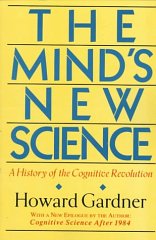 |
The Mind's New Science: A History of the Cognitive
Revolution
Author: Gardner, Howard
ISBN:
0-465-04635-5
LCCN:
Dewey:
Number:
|
Category: Cognition &
cognitive psychology
User Rating: 3.0 Stars
Pages: 448
Paperback Basic Books
From Library Journal This is an ambitious attempt to define and summarize
``cognitive science,'' a new field of scientific inquiry and knowledge. The
author, a leading authority and researcher in this area, writes in a clear,
accessible manner; yet, his book conveys the tremendous scope and complexity of
this burgeoning field. He convincingly links such seemingly disparate areas as
linguistics, computer science, cognitive psychology, structural anthropology,
and neuroscience, and attempts to integrate both their historical development
and underlying approaches to cognition. Recommended for scholars as an
introductory text and for informed laypersons who want a thorough and
fascinating grounding in the study of the mind and how it works. Paul Hymowitz,
Psychiatry Dept., Cornell Univ. Medical Ctr., New York Copyright 1985 Reed
Business Information, Inc. --This text refers to an out of print or unavailable
edition of this title. Product Description The first full-scale history of
cognitive science, this work addresses a central issue: What is the nature of
knowledge?
A Mind at a Time
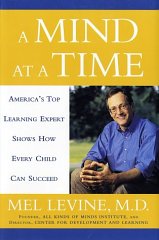 |
A Mind at a Time
Author: Levine, Mel Levine, Melvin
D. Levine, Mel
ISBN: 0-7432-0222-8
LCCN:
2001057670
Dewey: 370.15/23 21
Number:
|
Category: Child
Psychology
User Rating: 4.5 Stars
Pages: 352
Hardcover Simon & Schuster
Amazon.com Recognizing each child's intellectual, emotional, and physical
strengths--and teaching directly to these strengths--is key to sculpting "a mind
at a time," according to Dr. Mel Levine. While this flashing yellow light will
not surprise many skilled educators, limited resources often prevent them from
shifting their instructional gears. But to teachers and parents whose children
face daily humiliation at school, the author bellows, "Try harder!" A professor
of pediatrics at the University of North Carolina Medical School, Levine
eloquently substantiates his claim that developmental growth deserves the same
monitoring as a child's physical growth. Tales of creative, clumsy, impulsive,
nerdy, intuitive, loud-mouthed, and painfully shy kids help Levine define eight
specific mind systems (attention, memory, language, spatial ordering, sequential
ordering, motor, higher thinking, and social thinking). Levine also incorporates
scientific research to show readers how the eight neurodevelopmental systems
evolve, interact, and contribute to a child's success in school. Detailed steps
describe how mental processes (like problem solving) work for capable kids, and
how they can be finessed to serve those who struggle. Clear, practical
suggestions for fostering self-monitoring skills and building self-esteem add
the most important elements to this essential--yet challenging--program for
"raisin' brain." --Liane Thomas From Publishers Weekly Children have different
ways of learning, argues Levine, a professor of pediatrics at the University of
North Carolina Medical School and director of its Clinical Center for the Study
of Development and Learning, so why do schools behave as though a
one-size-fits-all education will work for everyone? Like Howard Gardner's Frames
of Mind: The Theory of Multiple Intelligences (1983), Levine's book argues that
our educational shortsightedness results in a loss of human potential on a grand
scale, as kids who don't fit the mold are misclassified, stigmatized and then
fail. If educators could assess differences more intelligently and redesign
educational models to account for these differences, they would radically
improve people's prospects for success in and out of school. Based on his work
with children who have learning or behavioral problems, Levine has isolated
eight areas of learning (the memory system, the language system, the spatial
ordering system, the motor system, etc.). He provides chapters describing how
each type of learning works and advises parents and teachers on how to help kids
struggling in these areas. Levine emphasizes that all minds have some areas of
giftedness and pleads for educators to "make a firm social and political
commitment to neurodevelopmental pluralism." Such a plea may seem daunting, but
Levine's compassionate, accessible text, framed around actual case studies,
makes it seem do-able. This is a must-read for parents and educators who want to
understand and improve the school lives of children. Copyright 2002 Cahners
Business Information, Inc.
Methods That Matter: Six Structures for Best Practice
Classrooms
 |
Methods That Matter: Six Structures for Best Practice
Classrooms
Author: Daniels, Harvey Bizar, Marilyn Bizar,
Marilyn
ISBN: 1-57110-082-2
LCCN:
97047516
Dewey: 371.102 21
Number:
|
Category: Teaching
Methods & Materials - General
User Rating: 5.0 Stars
Pages:
260
Paperback Stenhouse Publishers
Education Book Review This book is not just for beginners, teachers who have
made some progress in transforming their teaching will find useful information
and a helpful organization that may clarify their thinking and facilitate
further progress. From the Back Cover Today's teachers are inundated with
advice. Caught between the congenial but abstract ideals of progressive
education and the thousands of micro-recommendations pouring out of school
reform groups, how are we to teach our classes tomorrow? Cutting through this
overload, Harvey Daniels and Marilyn Bizar identify six basic teaching
structures that make classrooms more active, experiential, collaborative,
democratic, and cognitive, while simultaneously meeting the emerging standards
of "Best Practice" across subject areas and through the grades. Methods that
Matter offers concrete descriptions of practical and proven ways of organizing
time, space, materials, students, and activities that embody new standards while
creating genuinely student-centered classrooms. Illustrated by stories from two
dozen teachers at a wide variety of grade levels, the book clearly describes six
fundamental, recurrent activities: - Integrative units - extending thematic,
interdisciplinary inquiries co-planned with students, drawing on knowledge and
skills from across the curriculum. - Small group activities - structuring
collaborative pairs, groups, and teams that decentralize the classroom and
individualize the curriculum. - Representing-to-learn - engaging ideas through
writing and art; exploring genres and media of expression as ways of
investigating, remembering, and applying information. - Classroom workshop -
applying the studio-apprenticeship method with teacher modeling and coaching,
student choice, responsibility, and exhibition. - Authentic experiences -
curriculum-centered ways of bringing life into school and students into the
community for research and service. - Reflective assessment - nurturing student
reflection, goal-setting, and self-assessment; widening the evaluative roles and
repertoires of teachers and parents. Methods that Matter will help you organize
and manage your classroom so learning and teaching can truly achieve Best
Practice levels.
MEGASKILLS
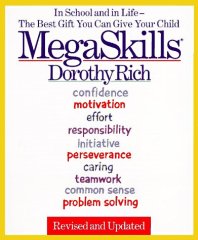 |
MEGASKILLS
Author: Rich, Dorothy Bradley, Bill
Geiger, Keith Geiger, Janet Bush, Barbara
ISBN:
0-395-63753-8
LCCN: 92014759
Dewey: 649/.1
20
Number:
|
Category:
Study Skills
User Rating: 5.0 Stars
Pages: 363
Paperback Houghton Mifflin
From the Publisher This new edition of the bestselling MegaSkills book
reflects the advances in Dr. Dorothy Rich's program since the original
publication. Included is feedback from parents, children, teachers, and
employers who have used the workshop programs. New sections emphasize new themes
in education for the '90s such as "readiness to learn, " approved ways to back
up the three R's at home, and more. 19 photos. Synopsis This new edition of the
bestselling MegaSkills book reflects the advances in Dr. Dorothy Rich's program
since the original publication. Included is feedback from parents, children,
teachers, and employers who have used the workshop programs. New sections
emphasize new themes in education for the '90s such as "readiness to learn, "
approved ways to back up the three R's at home, and more. 19 photos.
Meaningful Differences in the Everyday Experience of Young American
Children
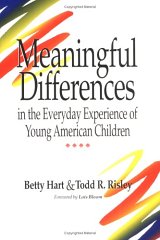 |
Meaningful Differences in the Everyday Experience of Young American
Children
Author: Hart, Betty Risley, Todd R.
ISBN: 1-55766-197-9
LCCN: 95003939
Dewey:
401/.93 20
Number:
|
Category: Sociology Of Children
User Rating: 4.5
Stars
Pages: 304
Hardcover Paul H Brookes Pub Co
Midwest Book Review This establishes a definite, studied link between early
childhood experiences and later intellectual development, providing a strong
study which focuses on American childhood experiences and which analyzes the
strong differences to be found between children at the same age levels. An
excellent, thought-provoking study. Senator Thomas Daschle ...alerts us to how
much each person's future intellectual ability hinges upon his or her experience
in the first year of life.
Mapping the Big Picture: Integrating Curriculum & Assessment
K-12
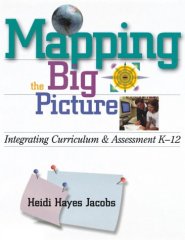 |
Mapping the Big Picture: Integrating Curriculum & Assessment
K-12
Author: Jacobs, Heidi Hayes
ISBN:
0-87120-286-7
LCCN: 97016708
Dewey: 375/.001
21
Number:
|
Category:
Curricula
User Rating: 5.0 Stars
Pages: 110
Paperback Association for Supervision & Curriculum Deve
Book Description Teachers have always used the school calendar to plan
instruction. Now, using a standard computer word-processing program, they can
collect real-time information about what is actually taught to create
"curriculum maps." These maps provide a clear picture of what is happening in
their classes at specific points during the school year. The benefits of this
kind of mapping are obvious for integrating curriculum: when curriculum maps are
developed for every grade level, educators see not only the details of each map,
but also the "big picture" for that school or district. They can see where
subjects already come together--and where they don't, but probably should. In
Mapping the Big Picture, Heidi Hayes Jacobs describes a seven-step process for
creating and working with curriculum maps, from data collection to ongoing
curriculum review. She discusses the importance of asking "essential questions"
and of designing assessments that reflect what teachers know about the students
in their care. She also offers a viable alternative to the "curriculum
committees" that are part of almost every school district in the United States.
The book concludes with more than 20 sample curriculum maps from real schools,
all of which were developed using the process described in this book.
Managing Your Classroom!: An Instant Idea Book
|
Managing Your Classroom!: An Instant Idea Book
Author:
Gruber, Barbara
ISBN: 0-86734-048-7
LCCN:
Dewey:
Number:
|
Category: Teaching Methods & Materials - General
User
Rating: Pages: 64
Paperback Frank Schaffer Publications
Managing Your Classroom With Heart: A Guide for Nurturing Adolescent
Learners
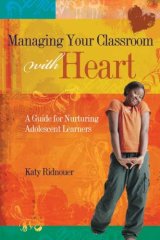 |
Managing Your Classroom With Heart: A Guide for Nurturing
Adolescent Learners
Author: Ridnouer, Katy
ISBN:
1-4166-0462-6
LCCN: 2006025718
Dewey: 371.102/4
22
Number:
|
Category:
Philosophy & Social Aspects
User Rating: 5.0
Stars
Pages: 178
Paperback Association for Supervision & Curriculum Deve
Book Description Teaching is as much about students as it is about
curriculum, and no one understands this better than middle and high school
teachers. But even the most dedicated teacher can sometimes feel defeated by the
challenge of reaching distracted, disconnected, and defiant adolescents. Drawing
on her own experience as a high school teacher, Katy Ridnouer shares an approach
to classroom management that will help you spend less time "dealing with" your
adolescent learners and more time inspiring them to be their best selves in
school and beyond. Managing with heart means accepting teenage students as they
are and recognizing what they need: a connection with the curriculum; a sense of
order; and most essentially, a sense that someone cares. In this book, you'll
find practical strategies for * Balancing care and discipline * Interacting with
students and their parents * Establishing classroom routines that keep students
on task * Communicating expectations and ensuring accountability * Handling
common challenges, from classroom noise and personality conflicts to
inappropriate clothing and disrespectful language * Building trust and helping
students feel emotionally and intellectually safe. Vivid, real-life examples and
questions for reflection make this a perfect choice for faculty reading groups
and any middle or high school teacher looking to create a positive learning
community, enhance students' confidence and interpersonal skills, and rediscover
the reward of being a teacher.
Making Standards Work: How to Implement Standards-Based Assessments in the
Classroom, School, and District
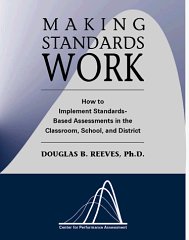 |
Making Standards Work: How to Implement Standards-Based Assessments
in the Classroom, School, and District
Author: Douglas, B.
Reeves
ISBN: 0-9644955-2-X
LCCN:
2004555116
Dewey: 379.1/58 21
Number:
|
Category:
Finance
User Rating: 4.0 Stars
Pages: 226
Mass Market Paperback Advanced Learning Center
Book Description States and districts are adopting new standards. Now what?
The promise of the standards movement will accomplish nothing if it does not
lead to changes in the classroom, school, and district. How do you transform
these standards into reality? This book is a full-length manual that tells you
how to implement standards-with a comprehensive step-by-step approach, extensive
appendices, checklists, glossary, bibliography, and sample assignments and
assessments. This book is the result of Dr. Reeves' work in small rural school
districts, complex urban school districts, multifaceted school systems with more
than ten million students, and hundreds of workshops and speaking engagements
nationally. About the Author Dr. Douglas B. Reeves is the Director of the Center
for Performance AssessmentSM. He consults with school systems and universities
throughout the world on issues relating to assessment, accountability,
technology, and leadership. An innovator in the field of assessment and
accountability systems, he is the author of six books and numerous articles. Dr.
Reeves is in great demand as a speaker to educational, government, and business
groups and has addressed audiences throughout the United States as well as in
Asia, Africa, and Europe. As the "Test Doctor" of the Internet, he responds to
questions from teachers, educational leaders, and students throughout the world
as they seek information on the best practices in educational assessment,
accountability, and leadership. This book is the result of Dr. Reeves' work with
literally hundreds of schools and thousands of teachers and administrators.
Their questions and insistent demands to make performance assessment practical,
relevant, and meaningful to the real world of today's students and educators
form the foundation of this volume.
Making Schools Work : A Revolutionary Plan to Get Your Children the
Education They Need
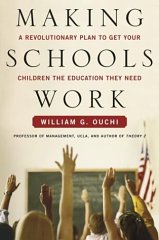 |
Making Schools Work : A Revolutionary Plan to Get Your Children the
Education They Need
Author: Ouchi, William G. Segal, Lydia
G.
ISBN: 0-7432-4630-6
LCCN:
2003050585
Dewey: 371.2/00973 21
Number:
|
Category: Education And
The State
User Rating: 4.0 Stars
Pages: 304
Hardcover Simon & Schuster
From Publishers Weekly Since the 1983 publication of A Nation at Risk,
readers have been deluged with proposals for school reform. This work by UCLA
management school "corporate renewal" professor Ouchi takes its place among
them. Ouchi bases his theory on sound principles derived from his research into
a variety of successful schools. Educational management systems should be
entrepreneurial rather than bureaucratic, he says. Give principals real control
over their budgets, empower parents as genuine participants in school decisions,
and student achievement will soar, even in communities beset by poverty and high
immigration rates, two usual indicators of school failure. Any useful management
book must reduce complex issues to bullets, and this one is no exception:
Ouchi's arguments, encapsulated in his "Seven Keys to Success," claim to
"revolutionize" schools and lead to vastly improved student academic
achievement. "Revolutionary" may be too strong a word here, and in fact, some of
the pedagogical practices Ouchi highlights are dubiously retrograde (e.g., third
graders "reciting the days of the week, the months of the year, and the number
of days in a week, month, and year"). However, Ouchi doesn't prescribe any of
these rituals; he merely advocates for the empowerment of school communities to
choose what's best for their particular students. Of interest to school leaders
and policy makers, the book also has a section devoted to what parents and
community members can do to improve not just their school but their school
district, where fundamental change is essential. Copyright 2003 Reed Business
Information, Inc. From Booklist Ouchi, a professor of management, studied 223
schools in nine school systems to develop a theory on how to manage schools
successfully. He focuses on public and Catholic schools in the three largest
school districts (New York, Los Angeles, and Chicago) and compares them with
three successful school districts (Edmonton, Canada; Seattle; and Houston).
Ouchi boils down the successful elements to seven factors: entrepreneurial
principals, budgetary control, accountability for performance and budget,
delegating authority, focus on student achievement, community of learners, and
real choice for families. Ouchi devotes an entire chapter to each key to
success, drawing on his observations at the successful schools and comparisons
with the nation's largest school systems. He concludes with a guide for parents
to evaluate their children's school and practical recommendations on how parents
and educators can adopt the key elements of success to their own schools and
districts. This detailed and compelling look at effective school management will
appeal to parents and educators alike. Vanessa Bush Copyright © American Library
Association. All rights reserved
Making Connections: Teaching and the Human Brain
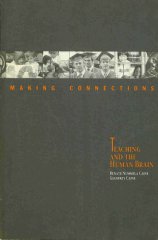 |
Making Connections: Teaching and the Human Brain
Author:
of, Learning Psychology Caine, Geoffrey
ISBN:
0-87120-179-8
LCCN: 91007631
Dewey: 370.15/23
20
Number:
|
Category:
Educational Psychology
User Rating: 4.0 Stars
Pages:
193
Unbound Association for Supervision & Curriculum Development
Includes bibliographical references (p. 181-192).
Loving Discipline A to Z
|
Loving Discipline A to Z
Author: Wright, Esther
ISBN: 0-9642947-1-0
LCCN:
Dewey:
Number:
|
Category:
Parenting - General
User Rating: 5.0 Stars
Pages: 80
Paperback Teaching from the Heart
Listen Up, Teacher! You are Making a Difference!
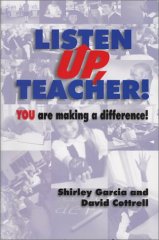 |
Listen Up, Teacher! You are Making a Difference!
Author:
Garcia, Shirley Cottrell, David
ISBN:
0-9719424-1-2
LCCN:
Dewey:
Number:
|
Category: Education &
Teaching : Teaching
User Rating: 4.0 Stars
Pages: 56
Paperback Cornerstone Leadership
Book Description Listen Up, Teacher is an inspirational book that reinforces
the importance of the classroom teacher. Written from the perspective of a
student who cares, the book explains ten important traits about teachers and the
impact they have on student's lives. About the Author Shirley Garcia is an
educator who has made a difference instudent's lives, both as a teacher and
administrator. She was a classroom teacher for over eight years before moving
into school administration. Listen Up, Teacher is her first book. David Cottrell
is president and CEO of CornerStone Leadership Institute. He is an
internationally known speaker and leadership consultant. Mr. Cottrell is the
author of ten books.
Linking Teacher Evaluation And Student Learning
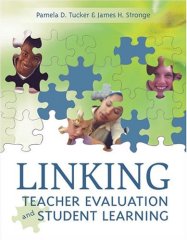 |
Linking Teacher Evaluation And Student Learning
Author:
Tucker, Pamela D. Stronge, James H. Stronge, James H.
ISBN:
1-4166-0032-9
LCCN: 2004026340
Dewey: 371.14/4
22
Number:
|
Category:
Evaluation
User Rating: 5.0 Stars
Pages: 175
Paperback Association for Supervision & Curriculum Deve
Book Description In Linking Teacher Evaluation and Student Learning,
researchers Pamela D. Tucker and James H. Stronge show that including measures
of student achievement in teacher evaluations can help schools focus their
efforts to meet higher standards. You'll see how four school systems have built
such measures into their evaluation programs in these distinct ways: *
Documenting how desired learning outcomes translated into actual student
learning * Tracking progress on key content standards * Setting annual
quantifiable goals for students' academic progress * Analyzing changes in
students' achievement test scores The authors explore the strengths of each
approach, offer insights from teachers and administrators, and describe
practical ways to incorporate similar measures of student learning into your own
evaluation program. Detailed appendixes provide hands-on tools and resources to
help you adapt these approaches to your school's particular needs. For any
school that is working to meet higher standards, linking teacher evaluation to
measures of student learning is a powerful way to refocus professional
development and improve student achievement. Download Description In Linking
Teacher Evaluation and Student Learning, researchers Pamela D. Tucker and James
H. Stronge show that including measures of student achievement in teacher
evaluations can help schools focus their efforts to meet higher standards.
You'll see how four school systems have built such measures into their
evaluation programs in these distinct ways: * Documenting how desired learning
outcomes translated into actual student learning * Tracking progress on key
content standards * Setting annual quantifiable goals for students' academic
progress * Analyzing changes in students' achievement test scores The authors
explore the strengths of each approach, offer insights from teachers and
administrators, and describe practical ways to incorporate similar measures of
student learning into your own evaluation program. Detailed appendixes provide
hands-on tools and resources to help you adapt these approaches to your school's
particular needs. For any school that is working to meet higher standards,
linking teacher evaluation to measures of student learning is a powerful way to
refocus professional development and improve student achievement.
Lessons in Loyalty: How Southwest Airlines Does It - An Insider's
View
 |
Lessons in Loyalty: How Southwest Airlines Does It - An Insider's
View
Author: West, Lorraine Grubbs
ISBN:
0-9762528-5-6
LCCN:
Dewey:
Number:
|
Category:
General
User Rating: 4.5 Stars
Pages: 130
Paperback CornerStone Leadership Institute
Review A must read, a practical guide to building your own winning team.
--Noel M. Tichy, Professor, University of Michigan Ross School of Business
Required reading for any organization striving to create the right culture.
--John Crisci, VP HR, VistaCare ...practical lessons for building a culture that
fosters productivity, innovation and organizational success. --Libby Sartain,
SVP Yahoo! Inc. Review Required reading for any organization striving to create
the right culture. --John Crisci, VP HR, VistaCare
Lessons for Inclusion
|
Lessons for Inclusion
Author: Terri Vandercook et al
ISBN:
LCCN:
Dewey:
Number:
|
Category: User
Rating: Pages: 0
Institute on Community Integration
Learning Together and Alone
|
Learning Together and Alone
Author: Johnson, David W.
Johnson, Roger P.
ISBN: 0-13-527871-6
LCCN:
86009501
Dewey: 371.1/02 19
Number:
|
Category: Nonfiction :
Education : Special Education
User Rating: 5.0 Stars
Pages:
224
Hardcover Prentice Hall
Product Description The authors integrate cooperative learning with
competitive and individualistic learning by providing guidelines for managing
critical issues such as teaching social skills, assessing competencies and
involvement, and resolving conflict among group members. Each type of
learning is clearly defined; the advantages and disadvantages of each are
covered; and the research is analyzed to illuminate the conditions under which
each should be used. Pre-service and in-service teachers with an interest in
cooperative learning and teaching methods. --This text refers to the Paperback
edition. From the Back Cover Key Benefits: Gives readers a broad, integrated
overview of cooperative learning. Key Topics: It details the uses for
cooperative learning, integrates cooperative learning with competitive and
individualistic learning and provides practical guidance for managing the
critical issues in using cooperative learning. Market: Upper level undergraduate
and graduate courses in Cooperative Learning, including a "Structures of
Learning" course in Educational Psychology. This text can also be a supplement
in a Social Psychology of Education course and any Educational Methods courses.
--This text refers to an out of print or unavailable edition of this title.
Learning to Teach...not just for beginners
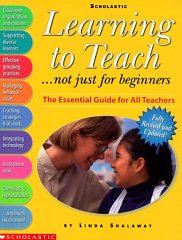 |
Learning to Teach...not just for beginners
Author:
Shalaway, Linda Beech, Linda (Editor)
ISBN:
0-590-25105-8
LCCN: 98207467
Dewey:
Number:
|
Category: Juvenile
Nonfiction
User Rating: 4.5 Stars
Pages: 304
Paperback Scholastic
Book Description The Essential Guide for All Teachers Fully revised and
updated, this invaluable guide to teaching and learning continues to be the ONE
resource every teacher needs. Bringing theory and practice together into an
accessible form, this virtual encyclopedia combines research-based findings with
practical information contributed by hundreds of educators working in many
settings from coast to coast. Included are reproducible forms, certificates,
checklists, questionnaires, resource lists, and much more. About the Author
Linda Shalaway has written extensively about teaching and research on teaching.
As an experiences education writers, she brings research results to teachers in
a practical, usable form. She also taps the "wisdon of practice" by collecting
and writing about experienced teachers' ideas and insights. "My work has always
revolved around the question of what constitutes good teaching," says Shalaway.
"It's a question whose answer we as teachers, parents, policy makers, and
researchers must continually strive to refine." Ms. Shalaway has worked with
teachers and researchers all over the country. She's been an editor of an
educational research and development magazine, contributing editor and columnist
for Instructor magazine, a consultant and freelance writer for numerous
educational publications, and a writing instructor. Ms. Shalaway, currently a
junior high and high school teacher, resides in West Virginia with her husband,
Scott, and daughters, Nora and Emma.
Learning on Display: Student-created Museums That Build
Understanding
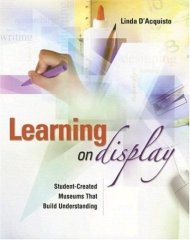 |
Learning on Display: Student-created Museums That Build
Understanding
Author: D'acquisto, Linda
ISBN:
1-4166-0285-2
LCCN: 2005035017
Dewey: 371.39
22
Number:
|
Category:
Experimental Methods
User Rating: 3.0 Stars
Pages:
191
Paperback Association for Supervision & Curriculum Deve
Book Description The story of the civil rights movement. The characteristics
of Japanese art and culture. The importance of innovation. The history of your
community. No matter the subject area or the grade level, a school museum
project can improve learning and teaching. Unlike science fairs or art shows,
which highlight the work of individuals, school museums are collaborative,
multifaceted projects that build understanding. As students engage in meaningful
work and deepen their knowledge of a specific topic, teachers gain insight into
best instructional practices. Through photographs and classroom examples, former
curriculum director, teacher, and museum educator Linda D'Acquisto shows how
school museums inspire students' curiosity and creativity; encourage
responsibility and teamwork; and strengthen writing, communication, research,
and problem-solving skills. You will learn the process for developing your own
exhibition, including strategies for *incorporating academic content standards
*assessing learning and understanding *guiding research, writing, and design
*promoting partnerships among students, colleagues, parents, and the community
*using the completed museum as a teaching tool With its step-by-step approach
and practical resources, Learning on Display will help you transform your
curriculum into motivating museum projects that make class work rigorous,
memorable, and fun. Linda D'Acquisto assists teachers and schools in planning
student-designed museum exhibitions through her consulting firm, Kid Curators.
Learning Manual for How the Brain Learns
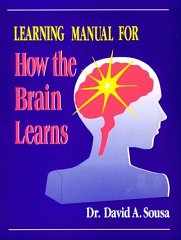 |
Learning Manual for How the Brain Learns
Author:
Sousa, David A.
ISBN: 0-8039-6753-5
LCCN:
Dewey:
Number:
|
Category: General
User Rating: 5.0 Stars
Pages:
88
Paperback Corwin Press
Learning Gap: Why Our Schools Are Failing and What We Can Learn from
Japanese and Chinese Education
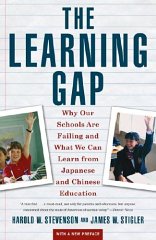 |
Learning Gap: Why Our Schools Are Failing and What We Can Learn
from Japanese and Chinese Education
Author: Stevenson,
Harold Stigler, James W.
ISBN: 0-671-88076-4
LCCN:
Dewey:
Number:
|
Category: Philosophy of education
User Rating: 4.5
Stars
Pages: 240
Paperback Simon & Schuster
From Library Journal Stevenson (psychology, Univ. of Michigan) and Stigler
(psychology, Univ. of California, Los Angeles) offer a comparison between
American (Chicago, Minneapolis) and Asian (Taiwan, China, Japan) elementary
schools. Quantifiable variables include instruction time, test data, length of
school year, curriculum studied, and instruction strategies. Another factor the
authors consider is attitude (e.g., parental attitudes toward schooling,
children toward learning, society toward educators, etc.). The writing style is
informal, and sufficient statistical data is presented to support the findings.
Some challenges are offered: "The American educational system as it currently
exists is producing an educationally advantaged minority and a disadvantaged
majority." The authors conclude that "Americans are proud of their
individualism; Asians are proud of their group orientation." For large public
and academic libraries. - Lois F. Roets, Drake Univ., Des Moines Copyright 1992
Reed Business Information, Inc. --This text refers to an out of print or
unavailable edition of this title.
Learning Environment
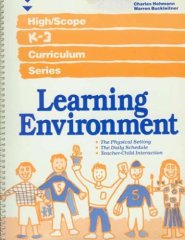 |
Learning Environment
Author: Hohmann, Charles
Buckleitner, Warren
ISBN: 0-929816-39-0
LCCN:
92019100
Dewey:
Number:
|
Category:
Elementary
User Rating: 4.0 Stars
Pages: 156
Paperback High/Scope Press
Learning and Teaching: Research Based Methods
|
Learning and Teaching: Research Based Methods
Author:
Kauchak, Don Eggen, Paul D.
ISBN:
0-205-11892-5
LCCN: 88026310
Dewey: 371.1/02
19
Number:
|
Category:
Organization & management of education
User Rating: 5.0
Stars
Pages: 450
Paperback Allyn & Bacon
From the Back Cover Research has highlighted the central role that teachers
play in determining the quality of learning in classrooms. Teachers exert a
powerful influence on both student achievement and motivation, and these
influences are more convincingly documented in the research literature that they
were a decade ago. Knowledge of the research will make teachers more effective
professionals inside and outside the classroom. Expert authors have over 40
years of combined experience teaching and researching. The goal of this book is
to translate the results of research into methods that teachers at any level
could use to increase their learning. It brings together two areas of
educational literature: 1) research on how teaching influences learning and 2)
teaching methodology that stresses desirable teaching procedures. This book is
aimed at teachers of any level - elementary, junior high, middle school, and
high school. It also is appropriate for school libraries and district personnel
responsible for teacher, professional, or staff development. --This text refers
to an out of print or unavailable edition of this title.
Learning & Memory: The Brain in Action
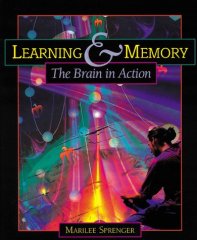 |
Learning & Memory: The Brain in Action
Author:
Sprenger, Marilee
ISBN: 0-87120-350-2
LCCN:
99006551
Dewey: 370.15/23 21
Number:
|
Category: Educational
Psychology
User Rating: 4.5 Stars
Pages: 113
Paperback Association for Supervision & Curriculum Deve
Includes bibliographical references (p. 106-107) and index.
The Key Elements of Classroom Management: Managing Time and Space, Student
Behavior, and Instructional Strategies
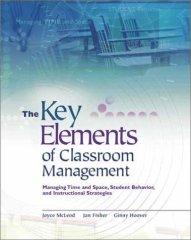 |
The Key Elements of Classroom Management: Managing Time and Space,
Student Behavior, and Instructional Strategies
Author:
McLeod, Joyce Fisher, Jan Hoover, Ginny
ISBN:
0-87120-787-7
LCCN: 2003012528
Dewey: 371.102/4
21
Number:
|
Category:
Teaching Methods & Materials - General
User Rating: 5.0
Stars
Pages: 195
Paperback Association for Supervision & Curriculum Deve
Book Description All teachers know that a well-managed classroom is the
cornerstone of a strong instructional program, but many are uncertain where they
should focus their energies. In The Key Elements of Classroom Management, three
veteran teachers show how teachers can make real improvements in their classroom
by concentrating on basic skills in three critical areas: ? Managing Time and
Space. Joyce McLeod shares techniques to help K-12 teachers arrange the
classroom, organize schedules, pace the year's curriculum, and manage
administrative tasks. ? Managing Student Behavior. Jan Fisher focuses on
preventing conflicts and disruptions by teaching students responsibility,
self-management, and problem-solving and decision-making skills. ? Managing
Instructional Strategies. Ginny Hoover describes various research-based
instructional methods, identifying the advantages and disadvantages of each. The
authors combine insights gleaned from extensive experience with step-by-step
discussions of practical strategies. Any teacher who has struggled with the
day-to-day challenges of the classroom will find an abundance of proven
techniques for creating an orderly, caring, and efficient environment that
supports successful teaching and learning. Download Description All teachers
know that a well-managed classroom is the cornerstone of a strong instructional
program, but many are uncertain where they should focus their energies. In The
Key Elements of Classroom Management, three veteran teachers show how teachers
can make real improvements in their classroom by concentrating on basic skills
in three critical areas: . Managing Time and Space. Joyce McLeod shares
techniques to help K-12 teachers arrange the classroom, organize schedules, pace
the year's curriculum, and manage administrative tasks. . Managing Student
Behavior. Jan Fisher focuses on preventing conflicts and disruptions by teaching
students responsibility, self-management, and problem-solving and
decision-making skills. . Managing Instructional Strategies. Ginny Hoover
describes various research-based instructional methods, identifying the
advantages and disadvantages of each. The authors combine insights gleaned from
extensive experience with step-by-step discussions of practical strategies. Any
teacher who has struggled with the day-to-day challenges of the classroom will
find an abundance of proven techniques for creating an orderly, caring, and
efficient environment that supports successful teaching and learning.
Iti: The Model
|
Iti: The Model
Author: Kovalik, Susan J.
ISBN: 1-878631-10-1
LCCN:
Dewey:
Number:
|
Category:
Education & Teaching : Educational Psychology, Education & Teaching
: Elementary, Medical, Nursing & Home Care : Neuroscience
User Rating:
4.5 Stars
Pages: 336
Paperback Discovery Pr
Interdisciplinary Curriculum: Design and Implementation
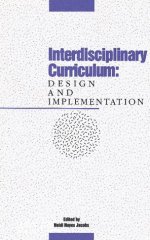 |
Interdisciplinary Curriculum: Design and
Implementation
Author: Jacobs, Heidi Hayes (Editor)
ISBN: 0-87120-165-8
LCCN: 89038019
Dewey:
375/.001 20
Number:
|
Category: Curricula
User Rating: 1.5
Stars
Pages: 97
Paperback Association for Supervision & Curriculum Deve
Book Description In order to absorb information, students must first be
assured that what they are taught is relevant to life outside the classroom. One
way to do this, suggests Heidi Hayes Jacobs in this book, is to teach subjects
at school in the same way we encounter them outside of school-- inextricably
entwined to each other. To that end, Interdisciplinary Curriculum: Design and
Implementation provides advice for teachers on how best to present material in a
manner that connects subject areas to each other.
Insult to Intelligence: The Bureaucratic Invasion of Our
Classrooms
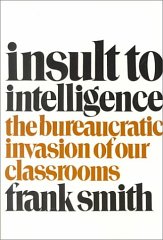 |
Insult to Intelligence: The Bureaucratic Invasion of Our
Classrooms
Author: Smith, Frank
ISBN:
0-435-08478-X
LCCN: 88008082
Dewey: 371.1/02
19
Number:
|
Category:
Teaching Methods & Materials - General
User Rating: 5.0
Stars
Pages: 304
Paperback Heinemann
Product Description Common sense tells us that drilling, testing, and grading
have nothing to do with how babies, children, and adults really learn. And
research backs this up. Students who had been asked to write regularly without
being taught to punctuate, for instance, ended a term not only writing but
punctuating much better than students in a neighboring class who had been
regularly drilled, tested, and graded solely on punctuation. This must be the
most tedious, least rewarding, and least effective teaching that students have
to endure. But false theory, political pressures, business opportunism, and
harried administrators have persuaded us to accept this bureaucratic travesty of
teaching as the real think. Insult to Intelligence focuses particularly on
children learning to read and write, the area in which Smith has made his
reputation. But his six-point manifesto on learning and teaching is applicable
at every level of education, and in the context of America's ongoing struggle to
upgrade the teaching profession and to raise national standards of literacy, his
book is nothing less than a call to arms. About the Author Frank Smith has
always been fascinated by language. He worked as a journalist in many countries
before beginning formal academic studies in Australia. This led to a Ph.D. at
Harvard University and further world travel researching, lecturing, and writing
on thinking and learning. He has been a professor at the Ontario Institute for
Studies in Education; the University of Toronto; the University of Victoria,
British Columbia; and the University of Witwatersrand, South Africa. He has
published many articles and books.
Instructional Practices That Maximize Student Achievement: For Teachers, by
Teachers
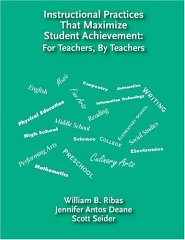 |
Instructional Practices That Maximize Student Achievement: For
Teachers, by Teachers
Author: Ribas, William B. Deane, Jenny
ISBN: 0-9715089-3-3
LCCN: 2005283336
Dewey:
371.102 22
Number:
|
Category: Teaching Methods & Materials - General
User
Rating: 4.5 Stars
Pages: 415
Paperback Ribas Associates and Publications Inc.
Review This book would serve as an excellent resource for study groups
researching "best practices" for their school. Whatever the focus of your
professional development, if you need to review the most up-to-date research
literature, find successful classroom strategies and develop a plan for
implementation, "Instructional Practices That Maximize Student Achievement" is
where you start. With today's culture of standards and accountability, educators
need proven tools to bring every student to high levels of achievement. This
book puts those tools right into teachers' hands -- a cost-effective resource
for every classroom. --Gail D. Rosengard, Assistant Superintendent for
Curriculum and Instruction, Lawrence Public Schools, Lawrence, MA A must read
for all educators . . . . Finally, there is a resource for teachers (by
teachers) that provides a comprehensive, practical approach to maximizing
student achievement. This book invites educators to examine current practice and
prioritize planning, instruction and assessment to increase student engagement
and attainment. Best practice thinking in the areas of differentiated
instruction, brain research, assessment and motivation are condensed into this
one teacher-friendly manual. Time is very valuable and in short supply.
Educators are looking for ways to work smarter in accomplishing instructional
goals. Reading this book is time well spent. I plan to share it with every
educator in my district! --Kristen Stringfellow, Assistant Superintendent of
Schools, Scituate School Department, Scituate, RI "Instructional Practices That
Maximize Student Achievement: For Teachers By Teachers" is an excellent
compilation of proven strategies and techniques specially designed for teachers
of all grade levels to improve the achievement of students of all abilities.
Chapters contain theory as well as current research, practical teaching
strategies and lesson models. Included are the contributions of over 20
teachers. They share their practical ways to increase students' academic
achievement through differentiated teaching strategies, questioning methods,
assessment of student learning, classroom management, and other means. Integrate
these proven instructional practices into your curriculum to achieve maximum
student achievement today! --Carol Rosengarten, High School Special Education
Teacher, Westwood Public Schools, Westwood, MA Review A must read for all
educators . . . . Finally, there is a resource for teachers (by teachers) that
provides a comprehensive, practical approach to maximizing student achievement.
This book invites educators to examine current practice and prioritize planning,
instruction and assessment to increase student engagement and attainment. Best
practice thinking in the areas of differentiated instruction, brain research,
assessment and motivation are condensed into this one teacher-friendly manual.
Time is very valuable and in short supply. Educators are looking for ways to
work smarter in accomplishing instructional goals. Reading this book is time
well spent. I plan to share it with every educator in my district! --Kristen
Stringfellow, Assistant Superintendent of Schools, Scituate School Department,
Scituate, RI
Inspiring Active Learning: A Handbook for Teachers
 |
Inspiring Active Learning: A Handbook for
Teachers
Author: Harmin, Merrill
ISBN:
0-87120-228-X
LCCN: 93049379
Dewey: 371.102
20
Number:
|
Category:
Learning Styles
User Rating: 5.0 Stars
Pages: 198
Paperback Association for Supervision & Curriculum Deve
From the Publisher Inspiring Active Learning is a can-do book. It shows
teachers how to turn students on to learning and how to get them working
diligently, willingly, and intelligently each day. Written by a teacher
committed to inspiring excellence, this book is a valuable addition to any
teacher's professional library. Synopsis Inspiring Active Learning is a can-do
book. It shows teachers how to turn students on to learning and how to get them
working diligently, willingly, and intelligently each day. Written by a teacher
committed to inspiring excellence, this book is a valuable addition to any
teacher's professional library.
In There With The Kids: Crafting Lessons That Connect With
Students
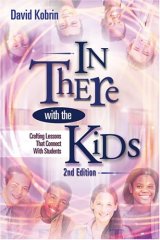 |
In There With The Kids: Crafting Lessons That Connect With
Students
Author: Kobrin, David
ISBN:
1-4166-0020-5
LCCN: 2004019483
Dewey: 371.102
22
Number:
|
Category:
Teaching Methods & Materials - General
User Rating: 5.0
Stars
Pages: 264
Paperback Association for Supervision & Curriculum Deve
Book Description The best teachers, says David Kobrin, think about who their
students are and how they learn. In this age of standardized tests and
"teacher-proof" lesson plans, they recognize that teaching is a rich and complex
activity that demands professional skill, sound judgment, and quick thinking. In
There with the Kids presents the parallel working lives of two teachers,
elementary teacher Hilary Coles and high school teacher Mel Stinko. We see these
teachers (composites drawn from the authors' experience and observations in
schools) as they plan lessons, interact with students, reflect on what happens
in the classroom, and try always to do better. Through them we are prompted to
think carefully about why some lessons work and others don't. Kobrin brings us
into the classroom, where we hear the voices of individual students and see how
their concerns influence what happens each day. He provides detailed
reconstructions of student debates and includes the handouts, exams, and
assessment instructions used for selected lessons. At the close of each chapter,
he analyzes the characters' actions, the motives behind them, and their effects
on events in the classroom. Lively, practical, and inspiring, In There with the
Kids demonstrates that teachers who are willing to reshape their teaching to
meet their students' unique needs can help those students achieve.
In Search of Understanding: The Case for Constructivist
Classrooms
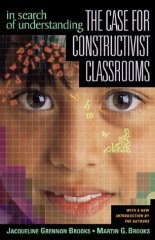 |
In Search of Understanding: The Case for Constructivist
Classrooms
Author: Brooks, Jacqueline Grennon Brooks, Martin
G.
ISBN: 0-87120-358-8
LCCN:
99006468
Dewey: 370.15/2 21
Number:
|
Category:
Education
User Rating: 3.0 Stars
Pages: 136
Paperback Association for Supervision & Curriculum Deve
Book Description The activities that transpire within the classroom either
help or hinder students' learning. Any meaningful discussion of educational
renewal, therefore, must focus explicitly and directly on the classroom, and on
the teaching and learning that occur within it. This book presents a case for
the development of classrooms in which students are encouraged to construct deep
understandings of important concepts. Jacqueline Grennon Brooks and Martin
Brooks present a new set of images for educational settings, images that emerge
from student engagement, interaction, reflection, and construction. They have
considerable experience in creating constructivist educational settings and
conducting research on those settings. Authentic examples are provided
throughout the book, as are suggestions for administrators, teachers, and
policymakers. For the new edition of their popular book, the authors have
written an introduction that places their work in today's educational renewal
setting. Today, they urge, the case for constructivist classrooms is much
stronger and the need more critical.
In Search of Understanding: The Case for Constructivist
Classrooms
 |
In Search of Understanding: The Case for Constructivist
Classrooms
Author: Brooks, Jacqueline Grennon Brooks, Martin
G.
ISBN: 0-87120-211-5
LCCN:
93026745
Dewey: 370.15/2 20
Number:
|
Category: Philosophy of
education
User Rating: 3.0 Stars
Pages: 136
Paperback Association for Supervision & Curriculum Deve
Book Description The activities that transpire within the classroom either
help or hinder students' learning. Any meaningful discussion of educational
renewal, therefore, must focus explicitly and directly on the classroom, and on
the teaching and learning that occur within it. This book presents a case for
the development of classrooms in which students are encouraged to construct deep
understandings of important concepts. Jacqueline Grennon Brooks and Martin
Brooks present a new set of images for educational settings, images that emerge
from student engagement, interaction, reflection, and construction. They have
considerable experience in creating constructivist educational settings and
conducting research on those settings. Authentic examples are provided
throughout the book, as are suggestions for administrators, teachers, and
policymakers. For the new edition of their popular book, the authors have
written an introduction that places their work in today's educational renewal
setting. Today, they urge, the case for constructivist classrooms is much
stronger and the need more critical. --This text refers to the Paperback
edition.
Improving Student Learning One Teacher at a Time
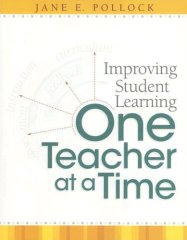 |
Improving Student Learning One Teacher at a Time
Author:
Pollock, Jane E.
ISBN: 1-4166-0520-7
LCCN:
2006036883
Dewey: 371.102 22
Number:
|
Category:
General
User Rating: 4.5 Stars
Pages: 143
Paperback ASCD
From the Publisher The most important factor affecting student learning isn't
standards, textbooks, or testing-it's teachers. And when it comes to improving
learning, research has shown teachers what works. But the real challenge comes
when it's time to do what works and do it well. In this book, Jane E. Pollock
explains how making the right adjustments in four critical areas of
practice-curriculum, instruction, assessment, and feedback-can help any teacher
improve student learning significantly. Here, you'll find out how to: Create a
classroom curriculum document that's truly useful and incorporates robust
concepts, generalizations, and procedures. Plan instruction that's focused on
helping students become master learners who can apply information and skills,
not just do schoolwork. Design varied classroom assessments that yield
evidence of mastery and pinpoint where further instruction is required. Use
criterion-based feedback to improve individual student achievement and refine
instruction. Along with step-by-step procedures, practical guidelines, and
specific models, this book features the voices of individual teachers who share
their experience using the author's "Big Four" approach. Like them, you may find
it's the missing link you need to transform your pedagogy and achieve
unprecedented levels of both student success and professional satisfaction.
Synopsis The most important factor affecting student learning isn't standards,
textbooks, or testing-it's teachers. And when it comes to improving learning,
research has shown teachers what works. But the real challenge comes when it's
time to do what works and do it well. In this book, Jane E. Pollock explains how
making the right adjustments in four critical areas of practice-curriculum,
instruction, assessment, and feedback-can help any teacher improve student
learning significantly. Here, you'll find out how to: Create a classroom
curriculum document that's truly useful and incorporates robust concepts,
generalizations, and procedures. Plan instruction that's focused on helping
students become master learners who can apply information and skills, not just
do schoolwork. Design varied classroom assessments that yield evidence of
mastery and pinpoint where further instruction is required. Use
criterion-based feedback to improve individual student achievement and refine
instruction. Along with step-by-step procedures, practical guidelines, and
specific models, this book features the voices of individual teachers who share
their experience using the author's "Big Four" approach. Like them, you may find
it's the missing link you need to transform your pedagogy and achieve
unprecedented levels of both student success and professional satisfaction.
Improving Classroom Social Climate
|
Improving Classroom Social Climate
Author: Vacha,
Edward F. Orcutt Union School District Staf
ISBN:
0-03-053801-7
LCCN:
Dewey:
Number:
|
Category: Teaching
Methods & Materials - General
User Rating: 5.0 Stars
Pages:
288
Paperback Harcourt Brace College Publishers
The Hurried Child: Growing Up Too Fast Too Soon
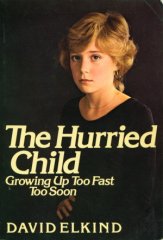 |
The Hurried Child: Growing Up Too Fast Too Soon
Author:
Elkind, David
ISBN: 0-201-03967-2
LCCN:
81014842
Dewey: 305.2/3 19
Number:
|
Category: Children's
Studies
User Rating: 4.0 Stars
Pages: 224
Paperback Da Capo Press
From Library Journal These two books offer excellent perspectives on
children, parents, and culture. Psychologist Apter (The Confident Child) argues
that we've been hanging on to an idea that's all wrong that when children finish
high school or college and land a job, they instantly become autonomous,
responsible adults. This "myth of maturity," insists Apter, is harming our kids.
These "thresholders" (ages 18-24) appear to function as adults (whether in a job
or in school), but in reality they are often in turmoil, depressed, and
overwhelmed by life. Apter claims that though parents have been taught that they
should end support (emotional, financial, and practical) so that their children
can be independent and self-reliant, this is the wrong approach. Each chapter
addresses a theme (job stress, finances, college, emotions) with stories of
thresholders Apter has interviewed followed by her advice to both parents and
thresholders on how to deal with the situation. Myth shatters many common
notions we've held for several decades, e.g., it links eating disorders to
separation anxiety and lays to rest the idea that the l8-24s are confident,
happy, and sexually active beings. Like Elkind, Apter knows that kids grow up
fast (that is, they leave childhood) but that they aren't "grown up" at all.
Elkind's classic The Hurried Child dates from 1981 and was revised in 1988; now
it appears in a third edition. The basic premise remains the same: parents have
pushed their children emotionally and intellectually too far, too fast. Today's
parents think of their kids as Superkids, so competent and so mature that they
need adults very little. Why? Because parents, who are building careers,
blending families, or struggling as single parents, have no time for child
rearing. Having a competent Superkid relieves these parents of guilt, but it
places too much stress on the children themselves. This new edition is fully
revised, with new sections on peer-group parent pressure, i.e., the pressure
parents feel to go along with the Superkid image out of fear that their own
children will lag behind, and on organized sports, the Internet, and software
for infants. Like Apter's title, this powerful book is essential reading. Linda
Beck, Indian Valley P.L., Telford, PA Copyright 2001 Reed Business Information,
Inc. --This text refers to an out of print or unavailable edition of this title.
Chicago Sun-Times, 04/19/06 "[A] landmark book." --This text refers to an out of
print or unavailable edition of this title.
Human Brain and Human Learning
|
Human Brain and Human Learning
Author: Hart, Leslie
A.
ISBN: 0-582-28379-5
LCCN:
82012650
Dewey: 152.1/5 19
Number:
|
Category: Physiological
Psychology
User Rating: 4.0 Stars
Pages: 206
Paperback Longman Publishing Group
Includes bibliographical references and index.
Human Brain and Human Learning
|
Human Brain and Human Learning
Author: Hart, Leslie
A.
ISBN: 0-933125-02-X
LCCN:
Dewey:
Number:
|
Category:
Psychology
User Rating: 4.0 Stars
Pages: 206
Paperback Books for Educators
How We "Do" School: Poems to Encourage Teacher
Reflection
 |
How We "Do" School: Poems to Encourage Teacher
Reflection
Author: Durica, Karen Morrow
ISBN:
0-87207-610-5
LCCN:
Dewey:
Number:
|
Category: Poetry texts
& anthologies
User Rating: 5.0 Stars
Pages: 98
Perfect Paperback International Reading Association
Product Description The 20 thought-provoking poems in this collection are
meant to promote reflective conversation about how educators do school. Each
poem, on its own merit, will say something to the teachers who read it, but that
message may differ depending on knowledge and past experiences. By stimulating
your beliefs and feelings about school, you can begin to examine and reflect on
your own classroom practices in order to grow as a professional. Included with
each poem is a discussion of the impetus for the poem and its connection to
current educational practice, as well as reflection questions, a suggested
activity, and additional resources for further in-depth reading on the topic.
This structure will enable you to move from discussion to concrete changes.
How To Thrive As A Teacher Leader
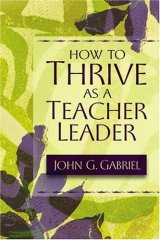 |
How To Thrive As A Teacher Leader
Author: GABRIEL,
JOHN G.
ISBN: 1-4166-0031-0
LCCN:
2004021622
Dewey: 371.1/06 22
Number:
|
Category: Teaching
Methods & Materials - General
User Rating: 5.0 Stars
Pages:
220
Paperback Association for Supervision & Curriculum Deve
Book Description Challenging times demand dynamic leadership. Schools rely on
teachers to assume a variety of leadership roles, both formal and informal,
including department chair, peer coach, faculty representative, and Web page
curator. With little or no leadership training, however, many teachers are
unprepared to take advantage of such opportunities. In How to Thrive as a
Teacher Leader, John G. Gabriel explores the responsibilities and rewards of
teacher leadership, offering practical, positive advice on * identifying
leadership qualities and building a team, * enhancing communication and earning
respect, * overcoming obstacles and implementing change, * energizing colleagues
and strengthening morale, and * improving student and teacher achievement. From
setting goals to mediating conflicts, from mentoring colleagues to motivating
students, Gabriel provides clear strategies--grounded in experience and
illustrated by examples--for becoming an effective teacher leader. A generous
resource section, including sample letters, surveys, and checklists, enables
readers to quickly put these techniques into practice. Whether you aspire to a
leadership position or are in a position to inspire future leaders, this
insightful and informative book will help you lead the way to success. John G.
Gabriel, a former English teacher and department chair, is an administrator at
Park View High School in Loudoun County, Virginia. Download Description
Challenging times demand dynamic leadership. Schools rely on teachers to assume
a variety of leadership roles, both formal and informal, including department
chair, peer coach, faculty representative, and Web page curator. With little or
no leadership training, however, many teachers are unprepared to take advantage
of such opportunities. In How to Thrive as a Teacher Leader, John G. Gabriel
explores the responsibilities and rewards of teacher leadership, offering
practical, positive advice on * identifying leadership qualities and building a
team, * overcoming obstacles and implementing change, * energizing colleagues
and strengthening morale, and * improving student and teacher achievement. From
setting goals to mediating conflicts, from mentoring colleagues to motivating
students, Gabriel provides clear strategies-grounded in experience and
illustrated by examples-for becoming an effective teacher leader. A generous
resource section, including sample letters, surveys, and checklists, enables
readers to quickly put these techniques into practice. Whether you aspire to a
leadership position or are in a position to inspire future leaders, this
insightful and informative book will help you lead the way to success. John G.
Gabriel, a former English teacher and department chair, is an administrator at
Park View High School in Loudoun County, Virginia.
How To Talk So Kids Can Learn
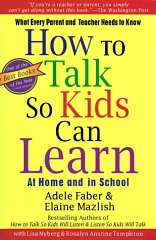 |
How To Talk So Kids Can Learn
Author: Faber, Adele
Mazlish, Elaine Mazlish, Elaine
ISBN:
0-684-82472-8
LCCN:
Dewey:
Number:
|
Category: Child care
& upbringing
User Rating: 4.0 Stars
Pages: 272
Paperback Scribner
From Publishers Weekly A communications primer for parents on encouraging
their child's learning ability. Copyright 1996 Reed Business Information, Inc.
From Library Journal Following up their best-selling Siblings Without Rivalry
(LJ 4/1/87), the authors explain how parents can help make their children more
receptive to learning. Copyright 1995 Reed Business Information, Inc. --This
text refers to an out of print or unavailable edition of this title.
How to Plan and Implement a Peer Coaching Program
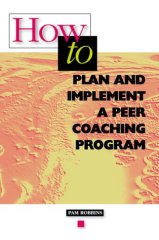 |
How to Plan and Implement a Peer Coaching Program
Author:
Robbins, Pamela Robbins, Pamela
ISBN:
0-87120-184-4
LCCN: 91027082
Dewey: 371.1/48
20
Number:
|
Category:
Administration - General
User Rating: 4.5 Stars
Pages:
69
Paperback Association for Supervision & Curriculum Deve
Includes bibliographical references (p. 66-69).
How to Integrate the Curricula
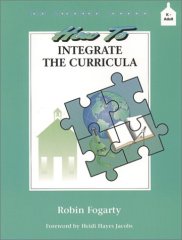 |
How to Integrate the Curricula
Author: Fogarty, Robin
Hayes-Jacobs, Heidi
ISBN: 0-932935-31-1
LCCN:
91060963
Dewey: 375/.00973 20
Number:
|
Category:
Curricula
User Rating: 5.0 Stars
Pages: 128
Paperback Iri/Skylight Training & Publishing,
Book Description Designed to help you see how to diminish the barriers
between different subjects, this book provides a spectrum of inventive
approaches to curricular integration. Ten models are presented, ranging from the
traditional fragmented model to those that connect, sequence, nest, share, web,
thread, integrate, network, and immerse one in curricular integration. It`s an
essential tool to help students see the exciting connections between the things
they learn.
How to Grade for Learning: Linking Grades to Standards
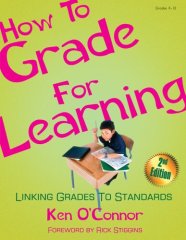 |
How to Grade for Learning: Linking Grades to
Standards
Author: O'Connor, Ken Stiggins, Rick Stiggins,
Rick
ISBN: 1-57517-816-8
LCCN:
2001099350
Dewey: 371.27/2 21
Number:
|
Category: Examinations
& assessment
User Rating: 5.0 Stars
Pages: 296
Paperback Corwin Press
Product Description Formerly a SkyLight publication "In How to Grade for
Learning, Ken O'Connor combines the thoroughness of a scholar with the
pragmatism of a veteran educator as he explains the relationship between content
standards, performance standards, assignments, assessments, and grades." -Jay
McTighe, Author and Consultant Teachers will never look at grading the same way
again. In this revised edition of the bestselling How to Grade for Learning, Ken
O'Connor shows how to link grades and standards. He updates his eight models,
which assist teachers in designing and conducting grading practices that help
students feel more in control of their academic success. This comprehensive
resource: Defines the purpose of each guideline Illustrates the examples
Discusses and analyzes key elements Supplies overviews of various grading
programs and calculation strategies About the Author Ken O'Connor has been an
independent consultant on assessment and evaluation from 1996 to present. He has
been a staff development presenter and facilitator on assessment, grading and
reporting in 33 states and 7 provinces and 5 countries outside North America. He
was a keynote presenter at the EARCOS Teachers Conference in Bangkok in March
2003 and an institute presenter at AISA conferences in Cameroon, Tanzania and
Zimbabwe in October 2005. His teaching career included experience as a geography
teacher and department head at L'Amoreaux C.I. and Maplewood High School in
Scarborough, Ontario, 1976-90, and teaching at four schools in Toronto and
Melbourne, Australia (Grade 7 - 12) starting in 1967. Ken was a Curriculum
Coordinator responsible for Student Assessment and Evaluation for the
Scarborough Board of Education and then the Toronto District School Board from
March 1990 to June 1999. He has also worked as a consultant on Secondary
Assessment at the Ontario Ministry of Education. His major extra-curricular
interest is field hockey, as a player, umpire and coach. As a coach, three of
his players went on to represent Canada in the Olympics. He also umpired at the
1984 Olympic Games and the 1990 World Cup.
How to Differentiate Instruction in Mixed-Ability
Classrooms
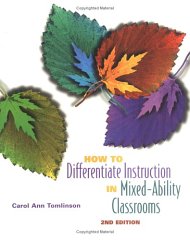 |
How to Differentiate Instruction in Mixed-Ability
Classrooms
Author: Tomlinson, Carol Ann Allan, Susan
Demirsky
ISBN: 0-87120-512-2
LCCN:
2001000344
Dewey: 371.2/52 21
Number:
|
Category: Individualized
Instruction
User Rating: 4.5 Stars
Pages: 117
Paperback Association for Supervision & Curriculum Deve
Book Description In this 2nd edition of a book that has provided inspiration
to countless teachers, Carol Ann Tomlinson offers three new chapters, extended
examples and information in every chapter, and field-tested strategies that
teachers can use in today's increasingly diverse classrooms. Tomlinson shows how
to use students' readiness levels, interests, and learning profiles to address
student diversity. In addition, the author shows teachers how to differentiate,
or structure, lessons at every grade level and content area to provide
"scaffolds"--as well as high-speed elevators--for $ The content of lessons, $
The processes used in learning, and $ The products of learning. Teachers can
draw on the book's practical examples as they begin to differentiate instruction
in their own classrooms. Strategies include curriculum compacting, "sidebar"
investigations, entry points, graphic organizers, contracts, and portfolios. As
Tomlinson says, "Differentiation challenges us to draw on our best knowledge of
teaching and learning. It suggests that there is room for both equity and
excellence in our classrooms.
How the Brain Learns: A Classroom Teacher's Guide
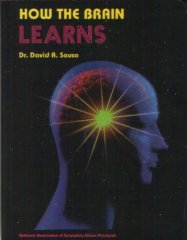 |
How the Brain Learns: A Classroom Teacher's Guide
Author:
Sousa, David A.
ISBN: 0-88210-301-6
LCCN:
Dewey:
Number:
|
Category: Learning Styles
User Rating: 5.0
Stars
Pages: 160
Paperback National Association of Student Councils
Product Description
David Sousa�s practical and powerful bestseller on brain
research and education enters the 21st century with a valuable updated edition,
incorporating the previously published main text, the companion learning manual,
and the latest discoveries in neuroscience and learning. How the Brain Learns
has always focused on the information that can help teachers turn research on
brain function into practical classroom activities and lessons. The second
edition still includes basic brain facts that can help students learn, insights
on how the brain processes information, and tips on maximizing retention using
"down time." And now Sousa takes it further, building on the latest information
available to provide: An updated Information Processing Model that reflects new
terminology regarding the memory system Exciting new research on how the brain
learns motor skills A whole new chapter on the implications of the arts in
learning An expanded list of primary sources for those who wish to review the
core research All the newest information and insights are included. It�s a vital
tool for school leaders, staff developers, teacher educators, and administration
education faculty�as well as any educator who wants to help students learn. See
Facilitator's Guide to How the Special Needs Brain Learns, Second Edition
A Hope in the Unseen: An American Odyssey from the Inner City to the Ivy
League
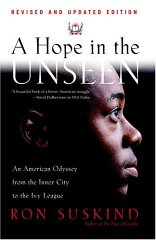 |
A Hope in the Unseen: An American Odyssey from the Inner City to
the Ivy League
Author: Suskind, Ron
ISBN:
0-7679-0126-6
LCCN:
Dewey:
Number:
|
Category: Modern
fiction
User Rating: 4.5 Stars
Pages: 400
Paperback Broadway
Amazon.com Ron Suskind won the Pulitzer Prize for feature writing in 1995 for
his stories on Cedric Jennings, a talented black teenager struggling to succeed
in one of the worst public high schools in Washington, D.C. Suskind has expanded
those features into a full-length nonfiction narrative, following Jennings
beyond his high-school graduation to Brown University, and in the tradition of
Leon Dash's Rosa Lee and Alex Kotlowitz's There Are No Children Here, delivers a
compelling story on the struggles of inner-city life in modern America. While it
appears to have a happy ending (with Jennings earning a B average in his
sophomore year), A Hope in the Unseen is not without a few caveats (at times,
Jennings feels profoundly alienated from his white peers). Trite as it may sound
to say, this book teaches a lesson about the virtue of perseverance, and it's
definitely worth reading. --John J. Miller --This text refers to an out of print
or unavailable edition of this title. From School Library Journal YA-Cedric
Jennings is the illegitimate son of an off-and-on drug dealer/ex-con and a
hardworking, badly paid mother; it is her single-minded vision to have the boy
escape the mean ghetto streets unscathed. Cedric has listened to her and is, as
the book opens, an A student at a run-down, dispirited Washington, DC, high
school, where he treads a thin line between being tagged a nerd and being beaten
by gang leaders. Suskind, a Wall Street Journal reporter, follows the
African-American youth through his last two years of high school and freshman
year at Brown University. Inspirational sermons at a Pentecostal church,
guidance from his mother, a love of black music and singing, and a refuge in the
logic of math combine with the young man's determination and faith in the future
to keep him focused on his goal of a topflight college education. Despite many
low moments and setbacks, Jennings's story is one of triumph within both
cultures, black and white, which together and separately put tremendous
obstacles in his path out of the inner city. It is a privilege and an
inspiration for readers to accompany Cedric on part of his long, difficult
journey to maturity. His journey continues at this moment, since he is now a
senior at Brown this fall. YAs of any background will be introduced to new
worlds here. Judy McAloon, Potomac Library, Prince William County, VA Copyright
1998 Reed Business Information, Inc. --This text refers to an out of print or
unavailable edition of this title.
The Hero's Journey: How Educators Can Transform Schools and Improve
Learning
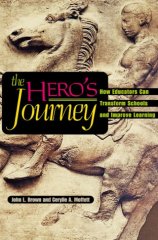 |
The Hero's Journey: How Educators Can Transform Schools and Improve
Learning
Author: Brown, John L. Moffett, Cerylle A. Moffett,
Cerylle A. Moffett, Cerylle A.
ISBN:
0-87120-344-8
LCCN: 99006342
Dewey: 371.2/00973
21
Number:
|
Category:
Administration - General
User Rating: 4.0 Stars
Pages:
195
Paperback Association for Supervision & Curriculum Deve
Book Description This is a book about hope. It affirms the power of personal
and collective responsibility to enact heroic changes in our schools. Through a
shared vision, purpose, and inquiry--and using the collective wisdom of myth,
legend, and metaphor from around the world--we can find the inspiration and
courage to face the challenges inherent in transforming schools into authentic
learning organizations. As the heroes of legend leave the safety of their homes
to face dragons and serpents in their quest for treasure and enlightenment, so
do modern educators face new practices and confront the barriers to change in
education. The authors show how heroic educators can triumph in their
journey--and achieve excellence for students. Like both Arthurian and Jedi
Knights, the Native American hero Black Elk, and Dorothy in The Wizard of Oz,
heroic educators face six stages on their journey: - innocence lost; - chaos and
complexity; - the heroic quest; - gurus and alliances; - trials, tests, and
initiations; and - insight and transformation. Finally, the heroic educator
returns "home" and begins the journey again, with a renewed vision and an
enlarged heart, to create a caring community for learners of all ages.
Guiding School Improvement With Action Research
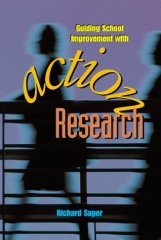 |
Guiding School Improvement With Action Research
Author:
Sagor, Richard
ISBN: 0-87120-375-8
LCCN:
00008206
Dewey: 371.2/07/0973 21
Number:
|
Category: Decision Making
& Problem Solving
User Rating: 4.0 Stars
Pages: 217
Paperback Association for Supervision & Curriculum Deve
Internet Bookwatch Guiding School Improvement With Action Research presents a
seven-step process for improving teaching and learning in classrooms at all
grade levels. Using practical examples, and featuring research tools, and
easy-to-follow "implementation strategies", educator Richard Sagor guides the
readers through the process from start to finish, describing how action research
can enhance a teacher's professional standing and efficacy while succeeding in
settings characterized by an increasingly diverse student population. Guiding
School Improvement With Action Research is highly recommended for students of
education, novice and practicing classroom teachers, school administrators,
school board members, education policy makers, and non-specialist general
readers with an interest in educational practices and standards.
A Guidebook for Cooperative Learning: A Technique for Creating More
Effective Schools
|
A Guidebook for Cooperative Learning: A Technique for Creating More
Effective Schools
Author: Dishon, Dee O'Leary, Pat W.
O'Leary, Pat Wilson (Photographer)
ISBN:
0-918452-58-9
LCCN: 83083183
Dewey: 371.3/95
19
Number:
|
Category:
Experimental Methods
User Rating: 5.0 Stars
Pages: 3
Paperback Learning Publications
Bibliography: p. [133] Includes index.
Great Performances: Creating Classroom-Based Assessment
Tasks
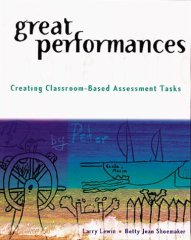 |
Great Performances: Creating Classroom-Based Assessment
Tasks
Author: Lewin, Larry Shoemaker, Betty Jean Shoemaker,
Betty Jean Schoemaker, Betty Jean
ISBN:
0-87120-339-1
LCCN: 98040133
Dewey: 371.3
21
Number:
|
Category:
Teaching Methods & Materials - Classroom Planning
User Rating:
5.0 Stars
Pages: 167
Paperback Assn for Supervision & Curriculum
Book Description "What grade did you give me?"students often ask teachers, as
if teachers randomly assign grades. Too many students do not understand the
concept of connecting grades to an earned academic performance. Improving
students' understanding of what their teachers expect them to do, how well they
should be able to do it, and how they should go about accomplishing it is what
this book is all about. The authors lead readers on their own personal journey,
sharing what they've learned about developing and effectively assessing powerful
performance tasks--ranging from short and specific to lengthy and substantive.
Their focus is on the practical, the doable. You can learn from their successes
as well as their mistakes. The authors discuss a four-step approach for teaching
students how to acquire content knowledge--labeled "Info In"--and examine four
"Info Out" modes through which students can make their content understanding
explicit for evaluation purposes. Great Performances is filled with highly
motivating examples of student projects as well as effective assessment tools
that teachers can adapt for their own classrooms. Teaching to and assessing with
performance tasks result in understanding--the type of understanding students
will need in the world, where they will be expected to produce "Great
Performances."
Great Grouping Strategies
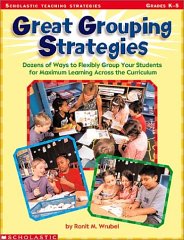 |
Great Grouping Strategies
Author: Wrubel, Ronit M.
ISBN: 0-439-30467-9
LCCN:
Dewey:
Number:
|
Category:
Curricula
User Rating: 5.0 Stars
Pages: 112
Paperback Teaching Resources
Book Description Dozens of Ways to Flexibly Group Your Students for Maximum
Learning Across the Curriculum Grouping for Results! During fourteen years of
teaching, Ronit Wrubel has assembled practical, clever, kid-friendly ideas for
grouping students to enable them to get the most out of their learning. From
describing how the right partnerships can facilitate friendships among shy
children to demonstrating how an effective cooperative learning group really
functions or what to do when a group placement isn't working, this book will
enliven and maximize students' learning. About the Author Ronit Wrubel is a
teacher in New York City.
Graduation by Exhibition: Assessing Genuine Achievement
 |
Graduation by Exhibition: Assessing Genuine
Achievement
Author: Smith, Sidney McDonald, Joseph P.
(Editor) Turner, Dorothy (Contributor) Finney, Marian Barton, Eileen
ISBN: 0-87120-204-2
LCCN: 92046613
Dewey:
373.73 20
Number:
|
Category: Secondary
User Rating: 3.0
Stars
Pages: 64
Paperback Association for Supervision & Curriculum Deve
Includes bibliographical references (p. 61-62).
Grading and Reporting Student Progress in an Age of
Standards
|
Grading and Reporting Student Progress in an Age of
Standards
Author: Trumbull, Elise (Editor) Farr, Beverly P.
(Editor)
ISBN: 1-929024-05-3
LCCN:
Dewey:
Number:
|
Category:
General
User Rating: 3.5 Stars
Pages: 224
Paperback Christopher-Gordon Pub
Good Morning Class I Love You
 |
Good Morning Class I Love You
Author: Wright, Esther
Winch, Bradley L.
ISBN: 0-915190-58-3
LCCN:
88082076
Dewey:
Number:
|
Category: Child care
& upbringing
User Rating: 4.0 Stars
Pages: 35
Paperback Jalmar Press
Book Description This inspiring book contains thought-provoking quotes and
questions about teaching from the heart. Helps love become an integral part of
the learning that goes on in every classroom. Great for new teachers and for
experienced teachers who sometimes become frustrated by the system. Use this
book to begin and end your day. Greet your students every day with, "Good
Morning Class-I Love You." Staff.
Getting to Got It! Helping Struggling Students Learn How to
Learn
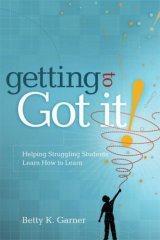 |
Getting to Got It! Helping Struggling Students Learn How to
Learn
Author: Garner, Betty K.
ISBN:
1-4166-0608-4
LCCN: 2007028931
Dewey: 370.15/23
22
Number:
|
Category:
Educational Psychology
User Rating: 4.0 Stars
Pages:
168
Paperback Association for Supervision & Curriculum Development
From the Publisher It's one of the great mysteries of teaching: Why do some
students "get it" and some students don't? In this book, Betty K. Garner focuses
on why students struggle and what teachers can do to help them become
self-directed learners. Difficulty reading, remembering, paying attention, or
following directions are not the reasons students fail but symptoms of the true
problem: underdeveloped cognitive structures?the mental processes necessary to
connect new information with prior knowledge; organize information into patterns
and relationships; formulate rules that make information processing automatic,
fast, and predictable; and abstract generalizable principles that allow them to
transfer and apply learning. Each chapter focuses on a key cognitive structure
and uses real-life accounts to illustrate how learners construct meaning by
using recognition, memorization, conservation of constancy, classification,
spatial orientation, temporal orientation, and metaphorical thinking. The
author's simple techniques stress reflective awareness and visualization. It's
by helping students to be conscious of what their senses are telling them,
encouraging them to visualize the information for processing, and then prompting
them to ask questions and figure out solutions on their own that teachers can
best help students develop the tools they need to Gather, organize, and make
sense of information, Become cognitively engaged and internally motivated to
achieve, and Experience learning as a dynamic process of creating and
changing. Suggestions for using these techniques in daily classroom practice,
advice on lesson planning for cognitive engagement, andguidelines for conducting
reflective research expand this book's practical applications. Use it not only
to help struggling students break through hidden barriers but to empower all
students with tools that will last a lifetime. Synopsis It's one of the great
mysteries of teaching: Why do some students "get it" and some students don't? In
this book, Betty K. Garner focuses on why students struggle and what teachers
can do to help them become self-directed learners. Difficulty reading,
remembering, paying attention, or following directions are not the reasons
students fail but symptoms of the true problem: underdeveloped cognitive
structures?the mental processes necessary to connect new information with prior
knowledge; organize information into patterns and relationships; formulate rules
that make information processing automatic, fast, and predictable; and abstract
generalizable principles that allow them to transfer and apply learning. Each
chapter focuses on a key cognitive structure and uses real-life accounts to
illustrate how learners construct meaning by using recognition, memorization,
conservation of constancy, classification, spatial orientation, temporal
orientation, and metaphorical thinking. The author's simple techniques stress
reflective awareness and visualization. It's by helping students to be conscious
of what their senses are telling them, encouraging them to visualize the
information for processing, and then prompting them to ask questions and figure
out solutions on their own that teachers can best help students develop the
tools they need to Gather, organize, and make sense of information, Become
cognitively engaged and internally motivated to achieve, and Experience
learning as a dynamic process of creating and changing. Suggestions for using
these techniques in daily classroom practice, advice on lesson planning for
cognitive engagement, andguidelines for conducting reflective research expand
this book's practical applications. Use it not only to help struggling students
break through hidden barriers but to empower all students with tools that will
last a lifetime.
Getting Results With Curriculum Mapping
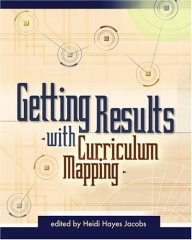 |
Getting Results With Curriculum Mapping
Author:
Jacobs, Heidi Hayes (Editor)
ISBN:
0-87120-999-3
LCCN: 2004016184
Dewey: 375/.001
22
Number:
|
Category:
Curricula
User Rating: 3.0 Stars
Pages: 181
Paperback Association for Supervision & Curriculum Deve
Book Description Curriculum maps are among the simplest yet most effective
tools for improving teaching and learning. Because they require people to draw
explicit connections between content, skills, and assessment measures, these
maps help ensure that all aspects of a lesson are aligned not only with each
other, but also with mandated standards and tests. In Getting Results with
Curriculum Mapping, Heidi Hayes Jacobs and her coauthors offer a wide range of
perspectives on how to get the most out of the curriculum mapping process in
districts and schools. In addition to detailed examples of maps from schools
across the United States, the authors offer concrete advice on such critical
issues as * Preparing educators to implement mapping procedures, * Using
software to create unique mapping databases, * Integrating decision-making
structures and staff development initiatives through mapping, * Helping school
communities adjust to new curriculum review processes, and * Making mapping an
integral part of literacy training. Teachers, administrators, staff developers,
and policymakers alike will find this book an essential guide to curriculum
mapping and a vital resource for spearheading school improvement efforts. Heidi
Hayes Jacobs is the author of Mapping the Big Picture: Integrating Curriculum
and Assessment, K-12 and Interdisciplinary Curriculum: Design and
Implementation. She is based in Rye, New York. Download Description Curriculum
maps are among the simplest yet most effective tools for improving teaching and
learning. Because they require people to draw explicit connections between
content, skills, and assessment measures, these maps help ensure that all
aspects of a lesson are aligned not only with each other, but also with mandated
standards and tests. In Getting Results with Curriculum Mapping, Heidi Hayes
Jacobs and her coauthors offer a wide range of perspectives on how to get the
most out of the curriculum mapping process in districts and schools. In addition
to detailed examples of maps from schools across the United States, the authors
offer concrete advice on such critical issues as . Preparing educators to
implement mapping procedures, . Using software to create unique mapping
databases, . Integrating decision-making structures and staff development
initiatives through mapping, . Helping school communities adjust to new
curriculum review processes, and . Making mapping an integral part of literacy
training. Teachers, administrators, staff developers, and policymakers alike
will find this book an essential guide to curriculum mapping and a vital
resource for spearheading school improvement efforts. Heidi Hayes Jacobs is the
author of Mapping the Big Picture: Integrating Curriculum and Assessment, K-12
and Interdisciplinary Curriculum: Design and Implementation. She is based in
Rye, New York.
Future Edge
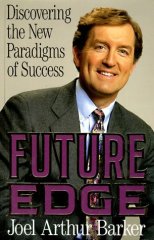 |
Future Edge
Author: Barker, Joel A. BARKER, JOEL A
ISBN: 0-688-10936-5
LCCN: 91027583
Dewey:
658.4/0355 20
Number:
|
Category: Management decision making
User Rating: 5.0
Stars
Pages: 240
Hardcover William Morrow
Includes bibliographical references (p. 219-228) and index. Three keys to the
future -- Watching for the future -- The importance of anticipation -- Defining
a paradigm -- When do new paradigms appear? -- Who changes the paradigm? -- Who
are the paradigm pioneers? -- What is paradigm effect? -- Twenty-two examples
more or less -- The most important paradigm shift of the Twentieth Century --
Going back to zero -- Key characteristics of paradigms -- Managers, leaders, and
paradigms -- Shifts for the 1990s--a Barker's dozen -- And so it goes.
From Standards to Success: A Guide for School Leaders
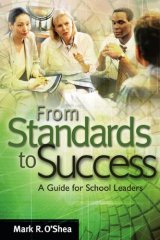 |
From Standards to Success: A Guide for School
Leaders
Author: O'shea, Mark R.
ISBN:
1-4166-0207-0
LCCN: 2005009481
Dewey: 379.1/58
22
Number:
|
Category:
Finance
User Rating: 5.0 Stars
Pages: 162
Paperback Association for Supervision & Curriculum Deve
Book Description In this era of accountability and high-stakes testing,
school leaders must find more sophisticated ways to help all students succeed.
But how can districts make adequate yearly progress without a coherent system
for addressing state standards? In From Standards to Success, education
professor Mark R. O'Shea introduces the Standards Achievement Planning Cycle
(SAPC), a comprehensive protocol for meeting the standards. To illustrate his
multi-layered approach, O'Shea takes readers to a fictional school as it
prepares to install the SAPC. We meet the superintendent, who organizes the
district for curriculum reform; the principal, who supervises standards-based
instruction; and the teachers, who collaboratively plan lessons and evaluate
their students' work. From teacher observation to student assessment, O'Shea
offers innovative strategies to help school leaders * identify and analyze which
standards are most important * select appropriate curriculum materials and
resources * provide instructional planning time for teachers * create a
benchmark-testing program * design effective professional development Checklists
at the end of each chapter highlight best practices, and sample lessons show how
to plan curriculum that enables students to meet state standards. The result is
a thorough and sensible guide to realizing the promise of standards-based
education. Mark R. O'Shea is a professor of education at California State
University-Monterey Bay. He is the founder and executive director of the
Institute for the Achievement of Academic Standards. Download Description In
this era of accountability and high-stakes testing, school leaders must find
more sophisticated ways to help all students succeed. But how can districts make
adequate yearly progress without a coherent system for addressing state
standards? In From Standards to Success, education professor Mark R. O'Shea
introduces the Standards Achievement Planning Cycle (SAPC), a comprehensive
protocol for meeting the standards. To illustrate his multi-layered approach,
O'Shea takes readers to a fictional school as it prepares to install the SAPC.
We meet the superintendent, who organizes the district for curriculum reform;
the principal, who supervises standards-based instruction; and the teachers, who
collaboratively plan lessons and evaluate their students' work. From teacher
observation to student assessment, O'Shea offers innovative strategies to help
school leaders * identify and analyze which standards are most important *
select appropriate curriculum materials and resources * provide instructional
planning time for teachers * create a benchmark-testing program * design
effective professional development Checklists at the end of each chapter
highlight best practices, and sample lessons show how to plan curriculum that
enables students to meet state standards. The result is a thorough and sensible
guide to realizing the promise of standards-based education. Mark R. O'Shea is a
professor of education at California State University-Monterey Bay. He is the
founder and executive director of the Institute for the Achievement of Academic
Standards.
Fred Jones Tools for Teaching
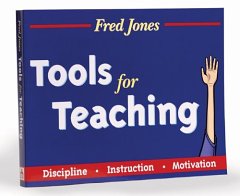 |
Fred Jones Tools for Teaching
Author: Jones, Fredric
H. Jones, Brian (Illustrator)
ISBN:
0-9650263-0-2
LCCN: 2001269322
Dewey: 371.102
21
Number:
|
Category:
Education
User Rating: 4.5 Stars
Pages: 352
Paperback Fredric H. Jones & Associates
Product Description In Tools for Teaching, Dr. Jones describes the skills by
which exceptional teachers make the classroom a place of success and enjoyment
for both themselves and their students. Tools for Teaching integrates the
management of discipline, instruction and motivation into a system that allows
you to reduce the stress of teaching by preventing most management headaches.
Dr. Jones helps you reduce student disruptions, backtalk, helpless handraising
and dawdling while helping you increase responsible behavior, motivation and
independent learning. These skills are made accessable by practical,
down-to-earth language and many examples and illustrations that provide the next
best thing to attending one of Dr. Jones' workshops. From the Author Tools for
Teaching is a training program between two covers. It describes the skills of
classroom management in practical, down-to-earth terms that makes sense to
practicing teachers. It walks you through skill performance so clearly that you
can practice with a colleague by reading out loud from the book. Tools for
Teaching deals with the entire range of management situations that define the
life of a teacher in the classroom - kids who disrupt, kids who sit helplessly
with their hands raised, kids who say, "I'm not doing this." More importantly,
the book focuses on prevention using lessons learned from highly effective
teachers. These "natural' teachers do not work themselves to death. They do not
become burned out. Tools for Teaching brings the skills of our most gifted
colleagues to light so that they can be understood and mastered by all. One of
the most common questions that I am asked after a workshop is, "Where were you
twenty years ago?" Another common question is, "Why don't they teach us this
stuff in college?" The skills described in Tools for Teaching are literally the
tools of the profession - your job description. The language, illustrations and
format make "Tools" easily accessible. And, the heavy paper and sewn binding
ensure that the book with hold up to years of hard use.
Frames Of Mind: The Theory Of Multiple Intelligences
|
Frames Of Mind: The Theory Of Multiple
Intelligences
Author: Gardner, Howard
ISBN:
0-465-02509-9
LCCN:
Dewey:
Number:
|
Category: Educational
Psychology
User Rating: 4.0 Stars
Pages: 464
Paperback Basic Books
About the Author Howard Gardner is the John H. and Elisabeth A. Hobbs
Professor in Cognition and Education at the Harvard Graduate School of
Education. Among numerous honors, Gardner received a MacArthur Prize Fellowship
in 1981. In 1990, he was the first American to receive the University of
Louisville's Grawemeyer Award in education. In 2000, he was awarded a Guggenheim
Fellowship. He lives in Cambridge, Massachusetts.
Fish! A Remarkable Way to Boost Morale and Improve
Results
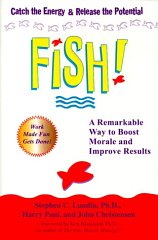 |
Fish! A Remarkable Way to Boost Morale and Improve
Results
Author: Lundin, Stephen C. Paul, Harry Christensen,
John Paul, Harry Christensen, John
ISBN:
0-7868-6602-0
LCCN: 99049306
Dewey: 658.3/14
21
Number:
|
Category:
Office & workplace
User Rating: 3.5 Stars
Pages:
115
Hardcover Hyperion
Amazon.com Here's another management parable that draws its lesson from an
unlikely source--this time it's the fun-loving fishmongers at Seattle's Pike
Place Market. In Fish! the heroine, Mary Jane Ramirez, recently widowed and
mother of two, is asked to engineer a turnaround of her company's troubled
operations department, a group that authors Stephen Lundin, Harry Paul, and John
Christensen describe as a "toxic energy dump." Most reasonable heads would cut
their losses and move on. Why bother with this bunch of losers? But the authors
don't make it so easy for Mary Jane. Instead, she's left to sort out this mess
with the help of head fishmonger Lonnie. Based on a bestselling corporate
education video, Fish! aims to help employees find their way to a fun and happy
workplace. While some may find the story line and prescriptions--such as "Choose
Your Attitude," "Make Their Day," and "Be Present"--downright corny, others will
find a good dose of worthwhile motivational management techniques. If you loved
Who Moved My Cheese? then you'll find much to like here. And don't worry about
Mary Jane and kids. Fish! has a happy ending for everyone. --Harry C. Edwards
From AudioFile Do you work in a "toxic energy dump"? Do you or your employees
seem stuck in the doldrums all the time? Well then, FISH! is for you. Mallory
Kasdan enthusiastically and energetically reads this tale of a manager of a
department in which everyone has lost ambition, energy, and helpfulness. Through
Kasdan's passionate narration, we learn how the Pike Place Fish Market--with
their secrets for success and improved attitude--helps the manager encourage her
staff to be involved and conscientious about what they do. FISH's philosophy
will help people in any business regain their energy and passion for their lives
and work. M.B.K. 2002 Audie Award Finalist © AudioFile 2002, Portland, Maine--
Copyright © AudioFile, Portland, Maine --This text refers to the Audio CD
edition.
A First-Year Teacher's Guidebook for Success: A Step-By-Step Educational
Recipe Book from September to June
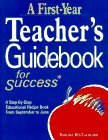 |
A First-Year Teacher's Guidebook for Success: A Step-By-Step
Educational Recipe Book from September to June
Author:
Williamson, Bonnie Thornton, Sandy
ISBN:
0-937899-08-9
LCCN:
Dewey: 371.1 20
Number:
|
Category: Teaching
Methods & Materials - Classroom Planning
User Rating:
Pages: 216
Paperback Dynamic Teaching Company
Includes bibliographical references (p. 214) and index.
The First Six Weeks of School
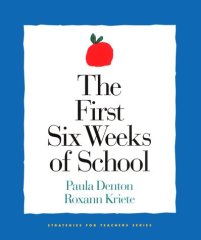 |
The First Six Weeks of School
Author: Denton, Paula
Kriete, Roxann Kriete, Roxann
ISBN:
1-892989-04-2
LCCN: 00100105
Dewey: 372.1102
21
Number:
|
Category:
Elementary
User Rating: 5.0 Stars
Pages: 232
Paperback Northeast Foundation for Children
New Teacher magazine, Spring 2001 "Top-Notch Book" Product Description Learn
how to structure the first six weeks of school to lay the groundwork for a
productive year of learning. Discover how taking the time to build a solid
foundation in the early weeks of school can pay off all year long in increased
student motivation, cooperation, responsibility, and self-control. This
comprehensive guidebook for K-6 teachers features: Daily plans for the first
three weeks and commentary about these plans at three grade levels: primary
(K-2), middle (3-4), and upper (5-6) Detailed guidelines for: -Building
community -Creating rules and teaching routines -Introducing engaging curriculum
-Fostering autonomy -Integrating social and academic learning -Establishing high
expectations for learning and behavior An extensive collection of games,
activities, greetings, songs, read-alouds, and resources especially useful
during the early weeks of school
The First Days of School: How to Be an Effective
Teacher
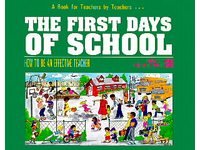 |
The First Days of School: How to Be an Effective
Teacher
Author: Wong, Harry K. Wong, Rosemary Tripi
ISBN: 0-9629360-0-6
LCCN:
Dewey:
Number:
|
Category:
Teaching Methods & Materials - Classroom Planning
User Rating:
4.0 Stars
Pages: 338
Paperback Harry K. Wong Publications
Product Description Over 3 million copies have been sold of the preeminent
book on classroom management and teaching for lesson achievement. The book walks
a teacher, either novice or veteran, through the most effective ways to begin a
school year and continue to become an effective teacher. This is the most basic
book on how to teach. Every teacher and administrator needs to have a copy. The
book is used in thousands of school districts, in over 65 countries, and in over
1000 college classrooms. It works and it s inspiring. Included in this 3rd
edition is a free 38 minute Enhanced CD, Never Cease to Learn. This bonus CD
features Harry Wong with a special introduction by Rosemary Wong. The
motivational message delivered is one all educators must hear and see. --This
text refers to the Paperback edition.
The First Amendment in Schools: A Guide from the First Amendment
Center
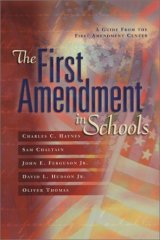 |
The First Amendment in Schools: A Guide from the First Amendment
Center
Author: Haynes, Charles C. Chaltain, Sam Ferguson,
John Hudson Jr., David L. Thomas, Oliver
ISBN:
0-87120-777-X
LCCN: 2003002637
Dewey: 342.73/085
21
Number:
|
Category:
Constitutional
User Rating: 5.0 Stars
Pages: 205
Paperback Association for Supervision & Curriculum Deve
Book Description What are the First Amendment rights? How do you resolve
questions about the rights of students, educators, and parents in a school
setting? The First Amendment to the U.S. Constitution protects the most basic
and cherished rights of society-religion, speech, press, petition, and assembly.
Anyone who wants to know more about those freedoms in the context of schools
will find The First Amendment in Schools a rich resource for study and
application. The book includes * An explanation of the origins of the First
Amendment * A concise, chronological history of 50 legal cases, including many
landmark decisions, involving the First Amendment in public schools * Answers to
frequently asked questions about the practice of the First Amendment in schools,
covering specific issues of religious liberty, free speech, and press as they
affect school prayer, use of school facilities, dress and speech codes, student
press, book selection, and curriculum * General information on First Amendment
expression and practice in schools * Information on more than 60 educational and
advocacy programs and organizations for First Amendment resources * A profile of
First Amendment Schools This book provides a civic and legal framework for
giving all members of the school community-students, parents, teachers,
administrators, and community members-a real voice in shaping the life of the
school.
The Fifth Discipline: The Art & Practice of the Learning
Organization
 |
The Fifth Discipline: The Art & Practice of the Learning
Organization
Author: Senge, Peter M.
ISBN:
0-385-26095-4
LCCN:
Dewey:
Number:
|
Category: Organizational
theory & behaviour
User Rating: 4.5 Stars
Pages: 424
Paperback Doubleday Business
Amazon.com Peter Senge, founder of the Center for Organizational Learning at
MIT's Sloan School of Management, experienced an epiphany while meditating one
morning back in the fall of 1987. That was the day he first saw the
possibilities of a "learning organization" that used "systems thinking" as the
primary tenet of a revolutionary management philosophy. He advanced the concept
into this primer, originally released in 1990, written for those interested in
integrating his philosophy into their corporate culture. The Fifth Discipline
has turned many readers into true believers; it remains the ideal introduction
to Senge's carefully integrated corporate framework, which is structured around
"personal mastery," "mental models," "shared vision," and "team learning." Using
ideas that originate in fields from science to spirituality, Senge explains why
the learning organization matters, provides an unvarnished summary of his
management principals, offers some basic tools for practicing it, and shows what
it's like to operate under this system. The book's concepts remain stimulating
and relevant as ever. --Howard Rothman From Publishers Weekly A director at
MIT's Sloan School, Senge here proposes the "systems thinking" method to help a
corporation to become a "learning organization," one that integrates at all
personnel levels indifferently related company functions (sales, product design,
etc.) to "expand the ability to produce." He describes requisite disciplines, of
which systems-thinking is the fifth. Others include "personal mastery" of one's
capacities and "team learning" through group discussion of individual objectives
and problems. Employees and managers are also encouraged to examine together
their often negative perceptions or "mental models" of company people and
procedures. The text is esoteric and flavored with terms like "recontextualized
rationality," but the book should help inventory-addled retailers whom the
author cites as unaware of their customers' desire for quality. Macmillan Book
Clubs selection. Copyright 1990 Reed Business Information, Inc. --This text
refers to an out of print or unavailable edition of this title.
A Field Guide to Using Visual Tools
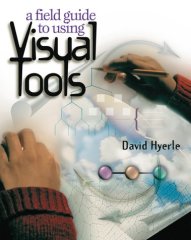 |
A Field Guide to Using Visual Tools
Author: Hyerle,
David
ISBN: 0-87120-367-7
LCCN:
00008213
Dewey: 370.15/2 21
Number:
|
Category: Educational
Psychology
User Rating: 4.5 Stars
Pages: 147
Paperback Association for Supervision&Curriculum Deve
Internet Book Watch - Internet Book Watch A Field Guide To Using Visual Tools
is a superb introduction to the practical applications of visual tools such as
brainstorming webs, task-specific organizers, and thinking-process maps as part
of the education curriculum process. Chapters include: The Mapping Metaphor; The
Networking Brain and Mind; Webs of Creativity; The Organizing Mind;
Thinking-Process Patterns; Thinking Maps for Reading Minds; and Change Patters.
The text is enhanced with appendices on "Thinking Maps Test Scores Summary" and
"Reading Comprehension Using Thinking Maps by Marjann Ball". A bibliography,
Resources For Visual Tools, Index, and "About the Author" round out this
practical, idea generating, highly recommended classroom education development
resource.
Eyes on Track: A Missing Link to Successful Learning
|
Eyes on Track: A Missing Link to Successful
Learning
Author: No Author Stroud, Carol A. Bedes, Vicki
Pike, Dick
ISBN: 0-9662530-2-7
LCCN:
00102601
Dewey: 617.7/008617.7/0083 22
Number:
|
Category:
Medicine
User Rating: 4.0 Stars
Pages: 118
Paperback JF's Publishing
Product Description A hands-on educator's guide to improve students' eye
tracking and vision perception.
Expanding Student Assessment
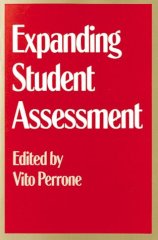 |
Expanding Student Assessment
Author: Perrone, Vito
(Editor) Jervis, Kathe Chittenden, Edward
ISBN:
0-87120-182-8
LCCN: 91018470
Dewey: 371.2/6/0973
20
Number:
|
Category:
Examinations & assessment
User Rating: 3.0 Stars
Pages:
167
Paperback Association for Supervision & Curriculum Deve
Book Description The means of assessment most commonly employed in schools
today are not only an inaccurate gauge of student achievement, but can be
detrimental to student learning. In this collection of essays, education
professionals of all stripes take a stand against standardized testing and in
defense of classroom practice as the most accurate indicator of student
knowledge.
The Evolving Multicultural Classroom
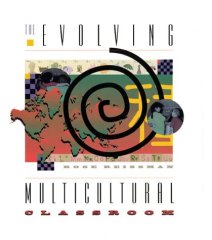 |
The Evolving Multicultural Classroom
Author:
Reissman, Rose
ISBN: 0-87120-233-6
LCCN:
94025103
Dewey: 370.19/6/0973 20
Number:
|
Category: Teaching of
ethnic minorities
User Rating: 5.0 Stars
Pages: 144
Paperback Association for Supervision & Curriculum Deve
Book Description This book is a comprehensive guide to infusing multicultural
education into the classroom. The author, Rose Reissman, relates many of her
experiences as an inner-city, middle school language arts teacher and teacher
educator in an engaging, concrete way. The book shows how teachers can actively
involve their students in projects that promote academic excellence and cultural
understanding, involve multiple intelligences, and benefit the community.
Section I presents activities to introduce teachers, students, and parents to
the concepts of multicultural education. Section II focuses on three areas of
the curriculum--language arts, social studies, and the arts. Reissman relates
how many teaching strategies and student projects (many involving technology)
evolved from an original activity, through student interest and exploration of
topics and themes in newspapers, works of literature, current events, community
resources, and students' backgrounds. Section III provides resources, including
detailed outlines of activities a nd strategies, that encourage teachers to put
together their own program and solicit parent input. An index is included.
Evaluation a Team Effort
|
Evaluation a Team Effort
Author: Picciott
ISBN: 0-590-73091-6
LCCN:
Dewey:
Number:
|
Category:
Developmental - Child
User Rating: 3.5 Stars
Pages:
0
Paperback Scholastic
Enhancing Student Achievement: A Framework for School
Improvement
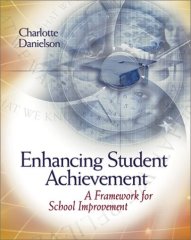 |
Enhancing Student Achievement: A Framework for School
Improvement
Author: Danielson, Charlotte
ISBN:
0-87120-691-9
LCCN: 2002013156
Dewey: 371.2
21
Number:
|
Category:
Administration - General
User Rating: 5.0 Stars
Pages:
141
Paperback Association for Supervision & Curriculum Deve
Book Description Educators devoted to school reform focus all too often on
the isolated components of K-12 education--this is the essential premise of this
powerful new book. If we are truly committed to improving our schools, the
author contends, then we must focus on the interdependence of variables that
affect student learning, both inside and outside the classroom. The book is
divided into three distinct parts. In Part 1, Danielson introduces the Four
Circles Model to define the criteria for successful school improvement:
Everything educators do to help their students learn must be based on what
educators want (school, district, or state goals), believe (values and
principles), and know (educational research). In Part 2, the author provides a
framework for improving schools--including curriculum, team planning, and
policies and practices affecting students--and connects every concept to the
criteria presented in Part 1. She also provides a handy rubric at the end of
each chapter, both as a summary of main points and as a tool for educators to
gauge the needs of their school. Part 3 offers readers guidelines on how best to
implement the framework using action planning. Brimming with perceptive advice
and thought-provoking arguments, this book is both a wake-up call and a roadmap
to success for those determined to provide students with the best education
possible. Download Description Educators devoted to school reform focus all too
often on the isolated components of K-12 education--this is the essential
premise of this powerful new book. If we are truly committed to improving our
schools, the author contends, then we must focus on the interdependence of
variables that affect student learning, both inside and outside the classroom.
The book is divided into three distinct parts. In Part 1, Danielson introduces
the Four Circles Model to define the criteria for successful school improvement:
Everything educators do to help their students learn must be based on what
educators want (school, district, or state goals), believe (values and
principles), and know (educational research). In Part 2, the author provides a
framework for improving schools--including curriculum, team planning, and
policies and practices affecting students--and connects every concept to the
criteria presented in Part 1. She also provides a handy rubric at the end of
each chapter, both as a summary of main points and as a tool for educators to
gauge the needs of their school. Part 3 offers readers guidelines on how best to
implement the framework using action planning. Brimming with perceptive advice
and thought-provoking arguments, this book is both a wake-up call and a roadmap
to success for those determined to provide students with the best education
possible.
Enhancing Professional Practice: A Framework for
Teaching
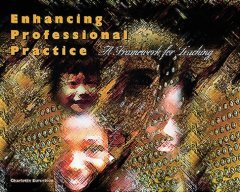 |
Enhancing Professional Practice: A Framework for
Teaching
Author: Danielson, Charlotte Jones, Frances
Faircloth
ISBN: 0-87120-269-7
LCCN:
96025256
Dewey: 371.1/02 20
Number:
|
Category: Teaching
Methods & Materials - Classroom Planning
User Rating: 5.0
Stars
Pages: 140
Paperback Association for Supervision & Curriculum Deve
Book Description The framework for teaching described in this book is based
on the PRAXIS III: Classroom Performance Assessments criteria developed by
Educational Testing Service. This framework identifies those aspects of a
teacher's responsibilities that have been documented through empirical studies
and theoretical research as promoting improved student learning. Those
responsibilities seek to define what teachers should know and be able to do in
the exercise of their profession. In this framework, the complex activity of
teaching is divided into 22 components clustered into four domains of teaching
responsibility: planning and preparation, classroom environment, instruction,
and professional responsibilities. Although the components are distinct, they
are also related to one another: A teacher's planning and preparation affect
instruction, and all these are affected by the reflection on practice that
accompanies a unit and lesson. The framework of professional practice is
designed to meet the needs of novice teachers, who are concerned with day-to-day
survival; experienced teachers, who want to improve their effectiveness and help
their colleagues do so as well; and highly accomplished teachers, who want to
move toward advanced certification and serve as a resource to less-experienced
colleagues.
Enhancing Professional Practice
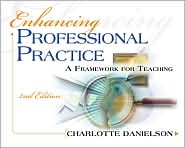 |
Enhancing Professional Practice
Author: Danielson,
Charlotte
ISBN: 1-4166-0517-7
LCCN:
2006030286
Dewey: 371.1/02 22
Number:
|
Category: Parenting &
Education : Education
User Rating: 4.0 Stars
Pages: 200
Paperback Association for Supervision & Curriculum Development
From the Publisher About the Author: Charlotte Danielson is is a program
administrator for Educational Testing Service (ETS) in Princeton, New Jersey.
She has taught at all levels, from kindergarten through college; worked as a
consultant on curriculum planning, performance assessment, and professional
development for numerous schools and school districts in the United States and
overseas; and designed materials and training programs for ASCD, ETS, and the
National Board for Professional Teaching Standards. In addition to authoring
Enhancing Professional Practice: A Framework for Teaching, Danielson developed
an ASCD Professional Inquiry Kit, Teaching for Understanding. Her work has
encouraged assessment in the service of learning by both teachers and students.
Synopsis About the Author: Charlotte Danielson is is a program administrator for
Educational Testing Service (ETS) in Princeton, New Jersey. She has taught at
all levels, from kindergarten through college; worked as a consultant on
curriculum planning, performance assessment, and professional development for
numerous schools and school districts in the United States and overseas; and
designed materials and training programs for ASCD, ETS, and the National Board
for Professional Teaching Standards. In addition to authoring Enhancing
Professional Practice: A Framework for Teaching, Danielson developed an ASCD
Professional Inquiry Kit, Teaching for Understanding. Her work has encouraged
assessment in the service of learning by both teachers and students.
English Teacher's Guide to Performance Tasks & Rubrics: Middle
School
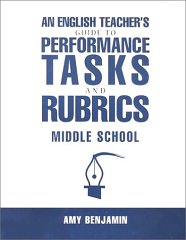 |
English Teacher's Guide to Performance Tasks & Rubrics: Middle
School
Author: Benjamin, Amy
ISBN:
1-883001-98-6
LCCN: 00022349
Dewey: 428/.0071/2
21
Number:
|
Category:
Evaluation
User Rating: 5.0 Stars
Pages: 189
Paperback Eye on Education
From the Publisher This book provides step-by-step procedures, student
hand-outs, and samples of student work. Synopsis This book provides step-by-step
procedures, student hand-outs, and samples of student work.
Emotional Intelligence: Why It Can Matter More Than IQ
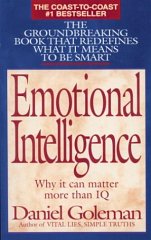 |
Emotional Intelligence: Why It Can Matter More Than
IQ
Author: Goleman, Daniel Goleman Goleman, Daniel
ISBN: 0-553-37506-7
LCCN:
Dewey:
Number:
|
Category:
Sociology, Social Studies
User Rating: 4.0 Stars
Pages:
368
Paperback Bantam
Amazon.com There was a time when IQ was considered the leading determinant of
success. In this fascinating book, based on brain and behavioral research,
Daniel Goleman argues that our IQ-idolizing view of intelligence is far too
narrow. Instead, Goleman makes the case for "emotional intelligence" being the
strongest indicator of human success. He defines emotional intelligence in terms
of self-awareness, altruism, personal motivation, empathy, and the ability to
love and be loved by friends, partners, and family members. People who possess
high emotional intelligence are the people who truly succeed in work as well as
play, building flourishing careers and lasting, meaningful relationships.
Because emotional intelligence isn't fixed at birth, Goleman outlines how adults
as well as parents of young children can sow the seeds. From Publishers Weekly
New York Times science writer Goleman argues that our emotions play a much
greater role in thought, decision making and individual success than is commonly
acknowledged. He defines "emotional intelligence"?a trait not measured by IQ
tests?as a set of skills, including control of one's impulses, self-motivation,
empathy and social competence in interpersonal relationships. Although his
highly accessible survey of research into cognitive and emotional development
may not convince readers that this grab bag of faculties comprise a clearly
recognizable, well-defined aptitude, his report is nevertheless an intriguing
and practical guide to emotional mastery. In marriage, emotional intelligence
means listening well and being able to calm down. In the workplace, it manifests
when bosses give subordinates constructive feedback regarding their performance.
Goleman also looks at pilot programs in schools from New York City to Oakland,
Calif., where kids are taught conflict resolution, impulse control and social
skills. Copyright 1995 Reed Business Information, Inc. --This text refers to an
out of print or unavailable edition of this title.
The Eleven Commandments of Good Teaching: Creating Classrooms Where Teachers
Can Teach
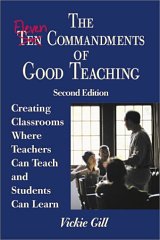 |
The Eleven Commandments of Good Teaching: Creating Classrooms Where
Teachers Can Teach
Author: Gill, Vickie Lent, James R.
ISBN: 0-7619-7810-0
LCCN: 00012371
Dewey:
371.102 21
Number:
|
Category: Teaching skills & techniques
User Rating:
5.0 Stars
Pages: 104
Paperback Corwin Press
Review "Full of tactics and techniques, this straightforward and interesting
book is loaded with good examples drawn from Gill�s own trials and errors."
(James Lent ) Review "Full of tactics and techniques, this straightforward and
interesting book is loaded with good examples drawn from Gill's own trials and
errors."
Effective Teaching Strategies That Accommodate Diverse
Learners
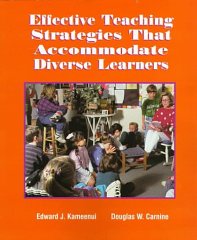 |
Effective Teaching Strategies That Accommodate Diverse
Learners
Author: Carnine, Douglas W. Kameenui, Edward J.
(Editor) Carnine, Douglas (Editor)
ISBN:
0-13-382185-4
LCCN: 97012048
Dewey: 371.102
21
Number:
|
Category:
Teaching of ethnic minorities
User Rating: 5.0 Stars
Pages:
222
Textbook Binding Prentice Hall
Product Description This popular book investigates the teaching, instruction
and curricula required to meet the needs of diverse learners who by virtue of
their experiential, cultural, and socioeconomic backgrounds, challenge
traditional curriculum and instructional programs. It provides a summary of the
characteristics of students with diverse learning and curricular needs as well
as an essential examination of current issues in education. It also introduces
six key principles to direct teachers through the design of instruction and
curriculum to ensure that diverse learners succeed in the classroom.
Characteristics of Students with Diverse Learning and Curricular Needs;
Effective Strategies for Teaching Beginning Reading; Effective Strategies for
Teaching Writing; Effective Strategies for Teaching Mathematics; Effective
Strategies for Teaching Science; Effective Strategies for Teaching Social
Studies; Modulating Instruction for English-language Learners; Contextual Issues
and Their Influence on Curricular Change. For teachers of diverse learners.
--This text refers to an out of print or unavailable edition of this title. From
the Back Cover This book examines the teaching, instruction, and curricula
required to meet the needs of diverse students, who by virtue of their
experiential, cultural, socioeconomic, linguistic, and physiological
backgrounds, challenge traditional curriculum and instructional programs. The
book provides a critical examination of the pedagogical and curricular
requirements in schools over the last five years. Based on these analyses,
recommendations for teaching reading, writing, mathematics, science, social
studies, and also teaching language minority students are given to ensure
diverse learners succeed in the classroom.
Effective listening: Key to your success
|
Effective listening: Key to your success
Author:
Steil, Lyman K Watson, Kittie W. Barker, Larry Lee
ISBN:
0-201-16425-6
LCCN: 82011512
Dewey: 658.4/52
19
Number:
|
Category:
Business Communication - Meetings & Presentations
User Rating:
5.0 Stars
Pages: 155
Hardcover Addison-Wesley
Includes index.
The Educators Guide to Preventing and Solving Discipline
Problems
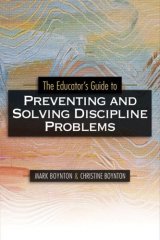 |
The Educators Guide to Preventing and Solving Discipline
Problems
Author: Boynton, Mark Boynton, Christine
ISBN: 1-4166-0237-2
LCCN: 2005024033
Dewey:
371.102/4 22
Number:
|
Category: Behavior Management
User Rating: 5.0
Stars
Pages: 177
Paperback ASCD
Download Description What can you do to keep students from fighting in the
hallways and acting out in class? When they break the rules, what disciplinary
actions can you take to help students behave themselves in the future? You'll
find the answers to these questions and many more in this comprehensive,
research-based guide to developing a schoolwide discipline system. Preventing
discipline problems usually requires less energy than coping with problems after
they occur, and a day without discipline problems is certainly more enjoyable
for teachers and students alike! With this in mind, Mark and Christine Boynton
present a wide variety of prevention strategies that any teacher can use,
including advice about their relative appropriateness in different settings and
circumstances. Of course, even the most successful preventive measures sometimes
can't stop a student from disrupting a lesson or picking on classmates. In those
situations, it is crucial to know which interventions are effective and which
are counterproductive. This book will help you learn the most appropriate
reactions to (and consequences for) student misbehavior, as well as specific
strategies for handling oppositional defiant disorder, attention deficit
hyperactivity disorder, and anger management issues in students. You'll also
find ideas for exploring your school's philosophical beliefs concerning
discipline, promoting positive teacher-student relations, and establishing
clearly defined parameters of acceptable classroom behavior. Whether you're a
K-12 teacher or a school principal, The Educator's Guide to Preventing and
Solving Discipline Problems will change the way you approach discipline in your
school-for the better! Mark and Christine Boynton, both former teachers and
principals, are currently educational consultants specializing in discipline
issues. They live in Gig Harbor, Washington.
Educational Evaluation
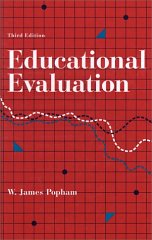 |
Educational Evaluation
Author: Popham, W. James
ISBN: 0-205-14217-6
LCCN: 92013806
Dewey:
379.1/54 20
Number:
|
Category: Funding of education
User Rating: 4.5
Stars
Pages: 372
Hardcover Allyn & Bacon
Booknews New edition of a text comprising 17 detailed chapters on the
theories and models of educational evaluation as well as the various techniques
of gathering data, sampling, measuring the hard-to-measure, analyzing and
evaluating results, and understanding the issues. Annotation c. Book News, Inc.,
Portland, OR (booknews.com)
Education, Technology, and Paradigms of Change for the 21st
Century
|
Education, Technology, and Paradigms of Change for the 21st
Century
Author: Thornburg, David D.
ISBN:
0-942207-09-2
LCCN:
Dewey:
Number:
|
Category:
General
User Rating: 4.5 Stars
Pages: 143
Paperback Starsong Publications
Education on the Edge of Possibility
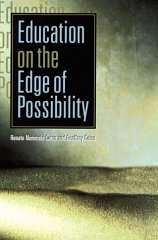 |
Education on the Edge of Possibility
Author: Caine,
Renate Nummela Caine, Geoffrey
ISBN:
0-87120-282-4
LCCN: 97004604
Dewey: 370/.973
21
Number:
|
Category:
History
User Rating: 4.0 Stars
Pages: 279
Paperback Association for Supervision & Curriculum Deve
Book Description What happens when learning theory meets the reality of the
classroom? In this book, you'll find out what happened when Renate and Geoffrey
Caine took their theory of learning, which is based on a wholistic
interpretation of brain research, and strived to bring it to life in two
schools. The Caines' work represents a new way of looking at learning and
change. Forming the foundation are brain/mind learning principles that describe
how the brain, mind, and body work together. The book details the Caines' work
in the schools, reports the results, and introduces surprising conclusions about
how educators will have to think and function to succeed in the 21st century.
The Caines believe that society as a whole is poised on the edge of chaos--and
possibility. Education is being pulled into that turbulence, and educators have
an opportunity to participate in influencing its direction. By incorporating
traditional and brain-based approaches to instruction, the authors offer the
means--education on the edge of possibility.
Education in a New Era
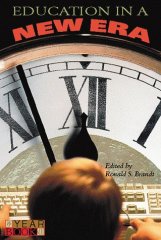 |
Education in a New Era
Author: Brandt, Ronald S.
(Editor)
ISBN: 0-87120-363-4
LCCN:
Dewey:
Number:
|
Category:
Reference
User Rating: 4.5 Stars
Pages: 246
Paperback Association for Supervision & Curriculum Deve
Book Description This book looks back to look ahead. Its purpose is to divine
what may happen--as well as what should happen--in the education of children and
youth, after thoughtfully reviewing what has happened so far. The authors,
chosen for their expertise in the topics they write about, highlight a few 20th
century ideas, events, or developments. Then, after considering the elements of
experience that seem most enduring, they try to envision what educators can
expect in the years ahead. They address the areas of governance, equity,
teaching and teacher development, instruction, curriculum, assessment, the
science of learning, technology, and progressive education. For example, the
21st century will likely see new instructional models that attempt to integrate
three areas of knowledge: experimental research on instruction, what is known
from cognitive psychology about the nature of learning, and what can be gleaned
from the research on brain functioning. Greater depth and less superficial
coverage will probably characterize the millennial curriculum. We can expect to
see network tools and digital devices that are designed specifically for
education through alliances of researchers, practitioners, and commercial
partners. Yearbook Editor Ron Brandt was formerly Executive Editor of
Educational Leadership and other ASCD publications. Now an independent author
and consultant, he writes a monthly column for the American Association of
School Administrators and is currently completing a book on school reform. He is
the author of the ASCD book "Powerful Learning."
Education and Public Health: Natural Partners in Learning for
Life
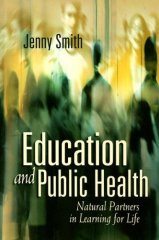 |
Education and Public Health: Natural Partners in Learning for
Life
Author: Smith, Jenny Curricul, Association for
Supervision and
ISBN: 0-87120-826-1
LCCN:
2005276833
Dewey: 613.071 22
Number:
|
Category: Administration
- General
User Rating: 3.5 Stars
Pages: 137
Paperback Association for Supervision & Curriculum Deve
Download Description Discover how to engage students in meaningful learning
and advance the goals of your curriculum through a community-based public health
partnership project. This book takes you to innovative projects in diverse
communities around the United States to explore how schools and public health
agencies work together to improve student achievement, behavior, and health.
Learn the keys to successful projects and the best ways to integrate health
education into the curriculum.
Educating Everybody's Children: Diverse Teaching Strategies for Diverse
Learners
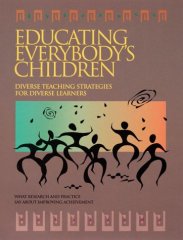 |
Educating Everybody's Children: Diverse Teaching Strategies for
Diverse Learners
Author: Cole, Robert W. Resea, ASCD
Improving Student Achievement Cole, Robert W. (Editor)
ISBN:
0-87120-237-9
LCCN: 95007075
Dewey: 371.3
20
Number:
|
Category:
Teaching Methods & Materials - General
User Rating: 5.0
Stars
Pages: 184
Paperback Association for Supervision & Curriculum Deve
Book Description This book is the culmination of the work of ASCD's Urban
Middle Grades Network, Advisory Panel on Improving Student Achievement, and
Improving Student Achievement Research Panel. The book is grounded in the belief
that differences in student achievement are often the result of differences in
the quality of instruction; if we can improve the quality of instruction, we can
improve the performance of students. "Educating Everybody's Children" offers a
wide-ranging assortment of instructional strategies whose effectiveness has been
gleaned from extensive review of both basic and applied research. One author
discusses strategies that work across the curriculum, while others discuss
strategies specific to reading, writing, mathematics, and oral communication.
Every strategy includes classroom examples and a list of the research studies
that support it. The authors also alert educators to barriers to good
instruction. Designed to promote reflection and discussion among the entire
learning community, this volume also serves as a practical guide to developing a
sound school program that meets the needs of students from diverse cultural,
ethnic, linguistic, and socioeconomic backgrounds. It is a resource that
educators will find themselves turning to again and again.
Edspeak: A Glossary of Education Terms, Phases, Buzzwords,
Jargon
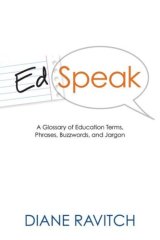 |
Edspeak: A Glossary of Education Terms, Phases, Buzzwords,
Jargon
Author: Ravitch, Diane
ISBN:
1-4166-0575-4
LCCN:
Dewey:
Number:
|
Category:
Reference
User Rating: 4.0 Stars
Pages: 245
Paperback ASCD
From the Publisher Have you ever heard of Suggestopedia? Do you know what a
gallery walk is? How about the difference between a stem and a foil? Maybe you
don't think it's necessary to know these education terms. Diane Ravitch thinks
otherwise. Education, like most professions, has its own unique vocabulary that
is often unfamiliar to outsiders. But unlike those of other professions, Ravitch
contends, the language of education must be clear and intelligible to all.
Because education in large part determines the future of our society, economy,
and culture, it's crucial that education issues be understood by the general
public. And to understand the issues, we need to understand the specialized
language used in the field. In this book, Ravitch demystifies the often-obscure
and ever-changing lingo of the education field. With more than 500 entries,
EdSpeak translates what Ravitch refers to as the "strange tongue" of pedagogese
into plain English, adding historical context and lively commentary along the
way. This glossary will serve as a valuable resource both for veteran educators
who need to stay abreast of newly emerging terminology and for newcomers to the
profession-be they teachers, administrators, parents, students, or just citizens
who care about what happens in the classroom. Synopsis Have you ever heard of
Suggestopedia? Do you know what a gallery walk is? How about the difference
between a stem and a foil? Maybe you don't think it's necessary to know these
education terms. Diane Ravitch thinks otherwise. Education, like most
professions, has its own unique vocabulary that is often unfamiliar to
outsiders. But unlike those of other professions, Ravitch contends, the language
of education must be clear and intelligible to all. Because education in large
part determines the future of our society, economy, and culture, it's crucial
that education issues be understood by the general public. And to understand the
issues, we need to understand the specialized language used in the field. In
this book, Ravitch demystifies the often-obscure and ever-changing lingo of the
education field. With more than 500 entries, EdSpeak translates what Ravitch
refers to as the "strange tongue" of pedagogese into plain English, adding
historical context and lively commentary along the way. This glossary will serve
as a valuable resource both for veteran educators who need to stay abreast of
newly emerging terminology and for newcomers to the profession-be they teachers,
administrators, parents, students, or just citizens who care about what happens
in the classroom.
Doing What Scientists Do: Children Learn to Investigate Their
World
 |
Doing What Scientists Do: Children Learn to Investigate Their
World
Author: Doris, Ellen
ISBN:
0-435-08309-0
LCCN: 90048126
Dewey:
372.3/5044/0973 20
Number:
|
Category: Natural history & pets
User Rating: 4.5
Stars
Pages: 208
Paperback Heinemann
Product Description Teachers and administrators wanting to make elementary
science programs work will find out how in these pages. This book translates the
theory of "discovery science" into a method that teachers can use. It shows: how
to begin and how to keep going how to organize space and materials how to manage
the classroom in a way that encourages focus and interest how to inspire
curiosity and help satisfy it Rich with examples of children's work and
classroom dialogue, this is a practical book, meant to help teachers implement
its ideas. About the Author A graduate of Cornell University, Ellen Doris has
taught science in a variety of settings, including schools, museums, and outdoor
programs. She currently teaches in the Greenfield Center School and conducts
workshops nationally for the Northeast Foundation for Children.
Diversity Consciousness: Opening Our Minds to People, Cultures, and
Opportunities
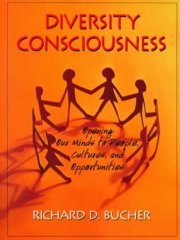 |
Diversity Consciousness: Opening Our Minds to People, Cultures, and
Opportunities
Author: Bucher, Richard D.
ISBN:
0-13-080338-3
LCCN: 99042489
Dewey: 331.13/3
21
Number:
|
Category:
Industrial or vocational training
User Rating: 4.0
Stars
Pages: 233
Paperback Prentice Hall
Book Description Focusing on personal growth and empowerment, this engaging
study helps readers develop the ability to understand, respect, and value
diversity, and demonstrates how opening one's mind to the views of other peoples
and cultures is central to a satisfying and successful life-both personally and
professionally. Offers current, thorough, and deeply insightful discussions on
diversity and workplace issues-what they are, their significance, and their
relevance to the reader; discusses concepts such as teamwork, conflict
management, racism, prejudice, and communication in a clear and concise fashion;
and zeroes in on the relationship between an employee's success in the workplace
and his/her ability to develop flexibility in their thinking so that they can
positively and effectively deal with a variety of diversity issues. Integrates
many real-life experiences and perspectives throughout, encourages
journal-writing, and promotes understanding with many interactive exercises,
including those developed for Internet use. For teacher training education
courses, staff/professional development workshops, professionals in business
management and human relations, or for anyone who wants a self-reflective and
proactive guide to understanding today's issues of diversity. Book Info Provides
a thoughtful, well researched treatise on a wide range of diversity concepts and
issues in everyday life. Presents a number of anecdotal situations to illustrate
key diversity concepts. Softcover. DLC: Diversity in the workplace.
Discovering and Exploring Habits of Mind
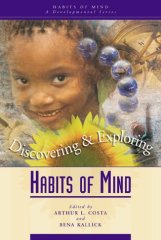 |
Discovering and Exploring Habits of Mind
Author:
Costa, Arthur L. (Editor) Kallick, Bena (Editor)
ISBN:
0-87120-368-5
LCCN: 99050943
Dewey: 155.4/13
21
Number:
|
Category:
Educational Psychology
User Rating: 1.5 Stars
Pages:
108
Paperback Association for Supervision & Curriculum Deve
Book Description In this book, noted educators Arthur L. Costa and Bena
Kallick define and describe 16 types of intelligent behavior that they call
"habits of mind." These habits of mind can aid both students and adults in
school and in everyday life as they encounter problems, dilemmas, and enigmas,
the resolutions of which are not immediately apparent. The habits are rooted in
a modern view of intelligence that casts off traditional abilities-centered
theories. Costa and Kallick maintain that a critical attribute of intelligence
is not only having information but also knowing how to act on it. The habits of
mind that contribute to this intelligence are: - Persisting - Managing
impulsivity - Listening with understanding and empathy - Thinking flexibly -
Thinking about thinking (metacognition) - Striving for accuracy - Questioning
and posing problems - Applying past knowledge to new situations - Thinking and
communicating with clarity and precision - Gathering data through all senses -
Creating, imagining, innovating - Responding with wonderment and awe - Taking
responsible risks - Finding humor - Thinking interdependently - Remaining open
to continuous learning "Discovering and Exploring Habits of Mind" is the first
of a four-book series. Subsequent volumes will explore instructional strategies
for teaching the habits at school and at home; assessment of the habits; and
descriptions from schools, teachers, and administrators about how they have
incorporated the habits of mind into their work. Other contributors to Book 1
are Shari Tishman and Marian Leibowitz. David Perkins's Series Foreword
introduces the four-book series, Habits of Mind: A Developmental Series.
Discipline With Dignity
 |
Discipline With Dignity
Author: Curwin, Richard L.
Mendler, Allen N.
ISBN: 0-87120-154-2
LCCN:
88039922
Dewey: 371.1/024 19
Number:
|
Category: Classroom
Management
User Rating: 5.0 Stars
Pages: 267
Paperback Association for Supervision & Curriculum Deve
Book Description Educators know that we must have safe schools. Teaching and
reinforcing responsible human behavior is the core of "Discipline with Dignity."
How do you achieve discipline and positive behaviors in a classroom or school?
This book offers specific ways to involve students in defining classroom
procedures, rules, and consequences based on values or principles compatible
with learning. Curwin and Mendler identify strategies for working with children
who are physically aggressive and explode without provocation. The basic
strategies include prevention, action, and resolution; the authors expand on
those ideas and share examples and practical applications for educators. Curwin
and Mendler explain the principles and related strategies that are as applicable
to the problems faced in inner-city schools as they are rural and suburban
schools. Current educational initiatives that improve both achievement and
behavior, including cooperative learning, multiple intelligences,
constructivism, inclusion, and brain-based learning, are all compatible with
"Discipline with Dignity" and attest to the continuing relevance of the
strategies involved. More than 10 years after the initial publication of
"Discipline with Dignity," Curwin and Mendler have added a new introduction in
which they reflect on why and how their approach to discipline works in today's
society. Treating students and educators with dignity will never go out of
fashion. --This text refers to the Paperback edition.
Differentiation in Practice: A Resource Guide for Differentiating
Curriculum, Grades 5-9
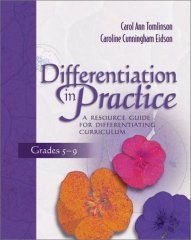 |
Differentiation in Practice: A Resource Guide for Differentiating
Curriculum, Grades 5-9
Author: Tomlinson, Carol Ann Eidson,
Caroline Cunningham Eidson, Caroline Cunningham
ISBN:
0-87120-655-2
LCCN: 2002151115
Dewey: 373.19
21
Number:
|
Category:
Curricula
User Rating: 5.0 Stars
Pages: 247
Paperback Association for Supervision & Curriculum Deve
Book Description This book is the first in a new series from Carol Ann
Tomlinson and Caroline Cunningham Eidson exploring how real teachers incorporate
differentiation principles and strategies throughout an entire instructional
unit. Focusing on the middle grades, but applicable at all levels,
Differentiation in Practice, Grades 5-9 will teach anyone interested in
designing and implementing differentiated curriculum how to do so or how to do
so more effectively. Included are * Annotated lesson plans for differentiated
units in social studies, language arts, science, mathematics, and world/foreign
language. * Samples of differentiated worksheets, product assignments, rubrics,
and homework handouts. * An overview of the essential elements of differentiated
instruction and guidelines for using the book as a learning tool. * An extended
glossary and recommended readings for further exploration of key ideas and
strategies. Each unit highlights underlying standards, delineates learning
goals, and takes you step by step through the instructional process. Unit
developers provide running commentary on their use of flexible grouping and
pacing, tiered assignments and assessments, negotiated criteria, and numerous
other strategies. The models and insight presented will inform your own
differentiation efforts and help you meet the challenge of mixed-ability
classrooms with academically responsive curriculum appropriate for all learners.
Download Description This book is the first in a new series from Carol Ann
Tomlinson and Caroline Cunningham Eidson exploring how real teachers incorporate
differentiation principles and strategies throughout an entire instructional
unit. Focusing on the middle grades, but applicable at all levels,
Differentiation in Practice, Grades 5-9 will teach anyone interested in
designing and implementing differentiated curriculum how to do so or how to do
so more effectively. Included are * Annotated lesson plans for differentiated
units in social studies, language arts, science, mathematics, and world/foreign
language. * Samples of differentiated worksheets, product assignments, rubrics,
and homework handouts. * An overview of the essential elements of differentiated
instruction and guidelines for using the book as a learning tool. * An extended
glossary and recommended readings for further exploration of key ideas and
strategies. Each unit highlights underlying standards, delineates learning
goals, and takes you step by step through the instructional process. Unit
developers provide running commentary on their use of flexible grouping and
pacing, tiered assignments and assessments, negotiated criteria, and numerous
other strategies. The models and insight presented will inform your own
differentiation efforts and help you meet the challenge of mixed-ability
classrooms with academically responsive curriculum appropriate for all learners.
Differentiated Instructional Strategies: One Size Doesn't Fit
All
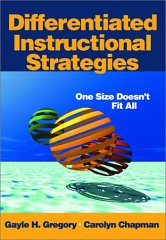 |
Differentiated Instructional Strategies: One Size Doesn't Fit
All
Author: Gregory, Gayle H. Chapman, Carolyn Chapman,
Carolyn
ISBN: 0-7619-4551-2
LCCN:
2001005120
Dewey: 371.39/4 21
Number:
|
Category: Teaching skills
& techniques
User Rating: 4.5 Stars
Pages: 160
Paperback Corwin Press
Review Differentiated Instructional Strategies: One Size Doesn�t Fit All
provides information about strategies that will enable teachers to plan
strategically so they can meet the needs of the wide variety of students in
today�s highly diverse classroom. Presented in an easy-to-use format, practical
techniques and processes are shared that can be used to plan and adjust learning
based on pre-assessment of individual students� knowledge, skills, experience,
preferences, and needs. ("Gifted Child Today," January 2003 January 2003 ) My
principals use Differentiated Instructional Strategies to design appropriate
strategies for evaluating whether the needs of all learners have been met.
(Linda S. Tafel, Professor ) A teacher-friendly guide to differentiating
instruction based on sound theory and best practice. (Joanne Quinn, Director of
Continuing Education ) A practical, persuasive, and useful guide. Differentiated
Instructional Strategies is highly recommended reading for classroom educators
and a seminal contribution to teacher education supplemental reading lists and
academic reference collections. (Midwest Book Review ) [The book] is highly
recommended reading for classroom educators and a seminal contribution to
Teacher Education supplemental reading lists and academic reference collections.
(Wisconsin Bookwatch ) Review "Differentiated Instructional Strategies: One Size
Doesn't Fit All provides information about strategies that will enable teachers
to plan strategically so they can meet the needs of the wide variety of students
in today's highly diverse classroom. Presented in an easy-to-use format,
practical techniques and processes are shared that can be used to plan and
adjust learning based on pre-assessment of individual students' knowledge,
skills, experience, preferences, and needs." --This text refers to the Hardcover
edition.
The Differentiated Classroom: Responding to the Needs of All
Learners
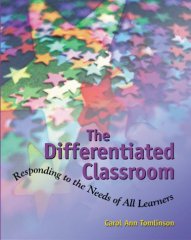 |
The Differentiated Classroom: Responding to the Needs of All
Learners
Author: Tomlinson, Carol Ann
ISBN:
0-87120-342-1
LCCN: 99006162
Dewey: 371.39/4
21
Number:
|
Category:
Education
User Rating: 4.5 Stars
Pages: 132
Paperback Association for Supervision & Curriculum Deve
Book Description It's an age-old challenge: How can teachers divide their
time, resources, and efforts to effectively instruct students of diverse
backgrounds and interests, as well as skill and readiness levels? The
Differentiated Classroom: Responding to the Needs of All Learners offers a
powerful, practical solution. Drawing on nearly three decades of experience,
author Carol Ann Tomlinson describes a way of thinking about teaching and
learning that will change all aspects of how you approach students and your
classroom. She looks to the latest research on learning, education, and change
for the theoretical basis of differentiated instruction and why it's so
important to today's children. Yet she offers much more than theory, filling the
pages with real-life examples of teachers and students using-and benefitting
from-differentiated instruction. At the core of the book, three chapters
describe actual lessons, units, and classrooms with differentiated instruction
in action. Tomlinson looks at elementary and secondary classrooms in nearly all
subject areas to show how real teachers turn the challenge of differentiation
into a reality. Her insightful analysis of how, what, and why teachers
differentiate lays the groundwork for you to bring differentiation to your own
classroom. Tomlinson's commonsense, classroom-tested advice speaks to
experienced and novice teachers as well as educational leaders who want to
foster differentiation in their schools. Using a "think versus sink approach,"
Tomlinson guides all readers through small changes, then even larger ones, until
differentiation becomes a way of life that enriches both teachers and students.
A Different Kind of Classroom: Teaching With Dimensions of
Learning
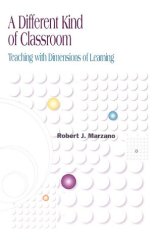 |
A Different Kind of Classroom: Teaching With Dimensions of
Learning
Author: Marzano, Robert J. Marshall, Stephanie P.
ISBN: 0-87120-192-5
LCCN: 92009069
Dewey:
371.1/02 20
Number:
|
Category: Teaching skills & techniques
User Rating:
3.0 Stars
Pages: 191
Paperback Association for Supervision & Curriculum Deve
Book Description In this book, Robert J. Marzano describes the Dimensions of
Learning program, a comprehensive K-12 instructional framework that teachers can
use to improve the way they plan instruction, design curriculum, and assess
student performance. Based on the best of what researchers have found out about
how children learn, Dimensions of Learning provides teachers with the tools for
building a truly learning-centered approach to schooling.
Developing More Curious Minds
 |
Developing More Curious Minds
Author: Barell, John
ISBN: 0-87120-719-2
LCCN: 2002151117
Dewey:
371.39 21
Number:
|
Category: Experimental Methods
User Rating: 4.0
Stars
Pages: 244
Paperback Association for Supervision & Curriculum Deve
Book Description After the September 11 attacks on the World Trade Center and
Pentagon, many people questioned why no one had anticipated the terrorists'
acts, even when events and intelligence seemed to point toward them. John Barell
wonders if the attacks speak to a greater societal problem of complacency. He
believes many students have become too passive in their learning, accepting
information and "facts" as presented in textbooks, classes, and the media.
Drawing on anecdotes from educators and his own life, Barell describes practical
strategies to spur students' ability and willingness to pose and answer their
own questions. Antarctica expeditions, outer space discoveries, dinosaur
fossils, literature, and more help define the importance of developing an
inquisitive mind, using such practices as * Maintaining journals on field trips,
* Using questioning frames and models when reading texts, * Engaging in critical
thinking and problem-based learning, and * Integrating inquiry into curriculum
development and the classroom culture. To become habits of mind, students' daily
curiosities must be nurtured and supported. Barell draws a vivid map to guide
readers to "an intelligent revolution" in which schools can become places where
educators and students imagine and work together to become active citizens in
their society. Download Description After the September 11 attacks on the World
Trade Center and Pentagon, many people questioned why no one had anticipated the
terrorists' acts, even when events and intelligence seemed to point toward them.
John Barell wonders if the attacks speak to a greater societal problem of
complacency. He believes many students have become too passive in their
learning, accepting information and "facts" as presented in textbooks, classes,
and the media. Drawing on anecdotes from educators and his own life, Barell
describes practical strategies to spur students' ability and willingness to pose
and answer their own questions. Antarctica expeditions, outer space discoveries,
dinosaur fossils, literature, and more help define the importance of developing
an inquisitive mind, using such practices as * Maintaining journals on field
trips, * Using questioning frames and models when reading texts, * Engaging in
critical thinking and problem-based learning, and * Integrating inquiry into
curriculum development and the classroom culture. To become habits of mind,
students' daily curiosities must be nurtured and supported. Barell draws a vivid
map to guide readers to "an intelligent revolution" in which schools can become
places where educators and students imagine and work together to become active
citizens in their society.
Developing Minds: A Resource Book for Teaching Thinking
|
Developing Minds: A Resource Book for Teaching
Thinking
Author: Costa, Arthur L. (Editor)
ISBN:
0-87120-131-3
LCCN: 85070037
Dewey: 371.3/07/8
19
Number:
|
Category:
Teaching
User Rating: 4.0 Stars
Pages: 343
Paperback Assn for Supervision & Curriculum
Book Description Why teach thinking skills? What are the best strategies for
teaching thinking in the classroom? What roles can technology play in the
development of such expertise? And how can we assess a student's mastery of
thinking skills? The 3rd edition of Developing Minds: A Resource Book for
Teaching Thinking explores these questions and many more. Editor Arthur L. Costa
has assembled an impressive array of authors and substantial new content
reflecting changes in the education environment since the Revised Edition of
this book appeared in 1991. Developing Minds explores how the teaching of
thinking is evolving as we strive to better understand how the brain learns,
effectively use technology in the classroom, and focus on assessment of student
achievement. This book helps to forge a common vision among the education
community--teachers, administrators, librarians, staff developers, teacher
educators, school board members, and parents--of what characterizes effective
and creative thinkers and problem solvers. The goal of Developing Minds is to
foster a world filled with classrooms, schools, and communities that are more
thoughtful places. --This text refers to the Paperback edition.
Developing Grading and Reporting Systems for Student
Learning
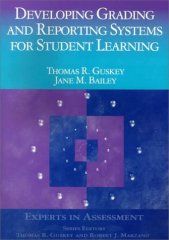 |
Developing Grading and Reporting Systems for Student
Learning
Author: Guskey, Thomas R. Bailey, Jane M.
ISBN: 0-8039-6854-X
LCCN: 00011400
Dewey:
371.27/2 21
Number:
|
Category: Examinations & assessment
User Rating:
3.0 Stars
Pages: 240
Paperback Corwin Press
Product Description Teachers, parents, students, administrators, and
community members all agree that we need better grading and reporting systems.
Often, these systems are inadequate because they are part of a tradition that
can go unexamined and unquestioned for years. Here is the first serious look at
the issue, written to provide all those involved � especially teachers � with a
coherent and thoughtful framework. Guskey and Bailey offer four pillars of
successful grading and reporting systems: Communication is the primary goal of
grading and reporting Grading and reporting are integral parts of the
instructional process Good reporting is based on good evidence Creating change
in grading and reporting requires creating a multi-faceted reporting system
Written to help readers develop a deeper and more reflective understanding of
the various aspects of the subject, Thomas Guskey and Jane Bailey�s work brings
organization and clarity to a murky and disagreement-filled topic. Here is a
practical and essential guide for teachers, administrators or anyone concerned
with understanding and implementing best practices in grading and reporting
systems. About the Author Thomas R. Guskey is Distinguished Service
Professor of Educational Measurement and Evaluation at Georgetown College in
Georgetown, Kentucky. He has been a teacher at all levels, served as an
administrator in Chicago public schools, and has worked in the area of
professional development for more than 20 years. Guskey has written widely and
is a regular presenter at the annual conference of the National Staff
Development Council.
Developing Academic Thinking Skills in Grades 6-12: A Handbook of Multiple
Intelligence Activities
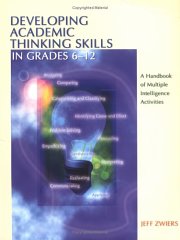 |
Developing Academic Thinking Skills in Grades 6-12: A Handbook of
Multiple Intelligence Activities
Author: Zwiers, Jeff
ISBN: 0-87207-557-5
LCCN: 2004013771
Dewey:
370.15/2 22
Number:
|
Category: Educational Psychology
User Rating: 5.0
Stars
Pages: 260
Paperback International Reading Association
School Library Journal This title will help teachers design activities that
develop the cognitive skills of students. Book Description Many classroom tasks
and texts require additional cognitive skills beyond the reading strategies
usually described in the literature on content area reading. This book will help
you design effective activities and assessments that foster the academic
thinking skills and academic language your students need to understand
challenging content area concepts taught in school. The chapters are organized
into three parts. Part I explains the importance of developing academic thinking
skills and the key role that academic language plays in this development. Part I
also discusses the key components of assessment and instruction as they relate
to the development of academic thinking. Part II contains the activities,
grouped into chapters by 12 thinking skills: * Analyzing * Comparing *
Categorizing and Classifying * Identifying Cause and Effect * Problem Solving *
Persuading * Empathizing * Synthesizing * Interpreting * Evaluating *
Communicating * Applying Each skill-based chapter describes an academic thinking
skill, offers a list of academic language terms related to the skill, and
provides activities that you can use to strengthen students' use of the skill.
All the activities tap into students' multiple intelligences; four
intelligences, in particular, are emphasized-interpersonal, visual, kinesthetic,
and musical-because of their proven effectiveness in how children learn. Part
III provides reproducible blackline masters that complement the activities in
Part II. The appendixes offer additional multiple intelligence activities, a
list of possible questions and controversial topics for use in classroom
discussions and in several of the book's activities, and familiar songs for
designing music-based activities. If you have students who struggle with
abstract concepts, academic language, and complex reading and writing tasks,
this handbook is for you.
Developing a Quality Curriculum
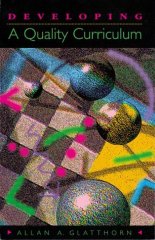 |
Developing a Quality Curriculum
Author: Glatthorn,
Allan A.
ISBN: 0-87120-234-4
LCCN:
94022689
Dewey: 375/.001 21
Number:
|
Category: Quality
(Management)
User Rating: 3.0 Stars
Pages: 136
Paperback Association for Supervision & Curriculum Deve
Book Description In the face of increasing demands for school reform,
educational leaders are looking anew at the core elements of the instructional
program, including, of course, the curriculum. "Developing a Quality Curriculum"
is a guide to both understanding and practicing sound curriculum development.
Allan Glatthorn draws upon research and his experience with more than 100 school
systems to lay out the steps of a quality curriculum development process, from
"Organizing and Planning for Curriculum Work" to "Conducting a Curriculum Audit
to Ensure Quality." He emphasizes that this is a collaborative process involving
district leaders, school administrators, teachers, students, and parents. Shared
leadership and responsibility are essential, and all involved must be committed
to a focus on student learning and an emphasis on quality. With its
comprehensive, step-by-step approach, "Developing a Quality Curriculum" is an
indispensable resource for school systems struggling to balance the
recommendations of state frameworks, classroom teachers, and others without
losing sight of the real objective: improving student learning. From the
Publisher Title of related interest from Waveland Press: Henson, Curriculum
Planning: Integrating Multiculturalism, Constructivism, and Education Reform,
Second Edition (ISBN 1577663306). --This text refers to the Paperback edition.
Developing a Character Education Program: One School District's
Experience
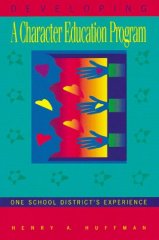 |
Developing a Character Education Program: One School District's
Experience
Author: Huffman, Henry A.
ISBN:
0-87120-236-0
LCCN: 94036454
Dewey:
370.11/4/097419 20
Number:
|
Category: Aims & Objectives
User Rating: 5.0
Stars
Pages: 91
Paperback Association for Supervision & Curriculum Deve
Book Description From the Foreword by Tom Lickona, author of "Educating for
Character": Henry Huffman's "Developing a Character Education Program: One
School District's Experience" is a timely and much-needed contribution. Huffman
offers a comprehensive concept of character, what he calls "a morality of the
head, the heart, and the hand." He describes an all-embracing approach to
character education, one that pays scrupulous attention to the moral impact of
everything a school district does and one that sees school board members,
administrators, faculty, classified staff, parents, and students as all having
key roles in developing a districtwide ethos that supports the core ethical
values at every opportunity. The distinctive value of this cogent, lucid
monograph is that it addresses the nuts-and-bolts questions most on the minds of
school practitioners: How to get character education started? How to get
consensus about the core values? How to get all the relevant constituencies on
board and keep everyone informed? How to keep controversies about matters such
as outcome-based education from sabotaging the character effort? Huffman answers
these questions chiefly by telling the story of his own district's ongoing
character education effort in Mt. Lebanon, Pennsylvania, and by drawing "lessons
learned" from that experience. He speaks with special credibility because he has
been the hands-on leader of his district's effort. This in-the-trenches
experience enables him to report with authority and humility on what worked and
where mistakes of commission and omission were made. I know of no other resource
in the character education literature that provides such a rich picture of a
district's planning and implementation process.
Designing Personalized Learning for Every Student
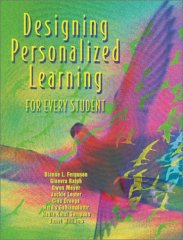 |
Designing Personalized Learning for Every Student
Author:
Ferguson, Dianne L. (Editor) Ralph, Ginevra (Editor) Meyer, Gwen
(Editor) Lester, Jackie (Editor) Droege, Cleo (Editor) Guojonsdottir,
Hafdis (Editor)
ISBN: 0-87120-520-3
LCCN:
2001005809
Dewey: 371.39/4 21
Number:
|
Category: Classroom
Management
User Rating: 5.0 Stars
Pages: 128
Paperback Association for Supervision & Curriculum Deve
Includes bibliographical references and index.
Democratic Schools
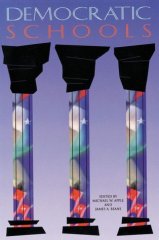 |
Democratic Schools
Author: Apple, Michael W. (Editor)
Beane, James A. (Editor)
ISBN: 0-87120-241-7
LCCN:
95007784
Dewey: 370.11/5 20
Number:
|
Category: Central
government
User Rating: 4.0 Stars
Pages: 106
Paperback Association for Supervision & Curriculum Deve
Book Description In "Democratic Schools," you'll see how educators in four
communities in the United States have committed themselves to preparing students
for the democratic way of life. Editors Michael Apple and James Beane have
gathered here narratives written by those intimately involved in each school
reform effort. These stories of change attest to the power of people working
together to overcome difficulties and achieve common goals in creative ways. At
a time when the viability of public schools is being questioned by many, the
schools in this book--Central Park East Secondary School, the Rindge School of
Technical Arts, Marquette Middle School, and La Escuela Fratney--remind us that
public schools play an important role in laying a firm foundation for our future
as a democratic society. Being themselves living models of democratic principles
in action, these schools help young people comprehend the meaning of active
citizenship and teach them the knowledge and skills they need to sustain and
enrich our democracy.
Deciding What to Teach and Test: Developing, Aligning, and Auditing the
Curriculum
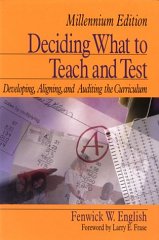 |
Deciding What to Teach and Test: Developing, Aligning, and Auditing
the Curriculum
Author: English, Fenwick W.
ISBN:
0-8039-6019-0
LCCN: 92006583
Dewey: 375/.001
20
Number:
|
Category:
Curriculum planning & development
User Rating: 3.0
Stars
Pages: 128
Paperback Corwin Press
Review "First published in 1992 and now released as the millennium edition,
this book is 'for school administrators and teachers who want fast, accurate,
and easy-to-use answers' to curriculum questions. It would also be an excellent
text for teacher education students just beginning to study curriculum." --This
text refers to the Hardcover edition. Product Description Learn to align the
three version of every curriculum - formal, informal, and hidden - by matching
tests, textbooks, and curriculum into an integrated whole.
The Culture of Education
 |
The Culture of Education
Author: Bruner, Jerome
ISBN: 0-674-17952-8
LCCN: 95046844
Dewey:
370.15 20
Number:
|
Category: Philosophy of education
User Rating: 3.0
Stars
Pages: 240
Hardcover Harvard University Press
From Booklist Thomas Gradgrind--Dickens' fact-worshiping pedagogue--would
applaud contemporary educators teaching students how, computerlike, to process
information. But Bruner holds his applause, for he recognizes that true
education must help students find meaning within a cultural context much larger
than the computer center. Bruner scours the research reports of pioneering
psychologists to explain the significance of that cultural context, yet he
insists that everyone--not just the researcher--shares responsibility for
defining the social and political meanings that educators reinforce. Bruner
identifies the wise educator as the one who helps students piece together
authentic narratives about themselves and their society. Such narratives give
students poise, yet do not hide the ambiguities that must be confronted in a
complex modern world. Teachers looking for tidy formulas for immediate use in
the classroom will close this book disappointed. But among readers serious about
educational philosophy, Bruner's study will earn high praise. Bryce Christensen
From Kirkus Reviews This original consideration of the link between education
and culture lives up to the Bruner standard of insightful, provocative, and
essentially hopeful discourse. Bruner (Actual Mind, Possible Worlds, 1986,
etc.), the doyen of cognitive psychology, has two ends in mind in this volume of
essays: One concerns education in the narrow sense, and possible remedies for
its current plight. The second addresses the larger theme of how we as
individuals come to identify ourselves in a particular culture, a process that
leads Bruner to the interesting conclusion that the future of psychology lies in
a marriage to anthropology. As always, Bruner argues that learning is situated
in a context, which for human beings involves the shared symbols of a community,
its traditions and toolkit, passed on from generation to generation and
constituting the larger culture. Bruner traces the evolution of the study of
mind from schools of psychology and philosophy that have variously emphasized
mind as information processor, mind as instrumental actor, mind as brain evolved
from primate/hominid biology, and mind as a developing organ. How we construe
mind influences pedagogy, from the concept that sees information flowing from
teacher to fill the (passive) brains of the young to the cultural-psychological
perspective Bruner now espouses. In a long first essay he outlines a series of
tenets, ranging from the need to foster self-esteem in children to the
importance of the narrative mode by which children come to recognize themselves
and find a place in the culture. The essays that follow enlarge on these themes
with telling commentary on contemporary society. The last chapter spells out why
Bruner feels that if psychology is to better understand human nature and the
human condition it must master the interplay between biology and culture. No
doubt this will elicit ``yes, but's'' and ``no way'' from assorted academic
fiefdoms, but the general reader may well find this an exhilarating notion well
supported by this wonderfully argued work. -- Copyright ©1996, Kirkus
Associates, LP. All rights reserved.
Creating Your Future: Personal Strategic Planning for
Professionals
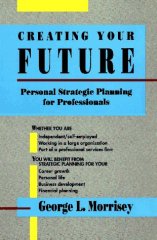 |
Creating Your Future: Personal Strategic Planning for
Professionals
Author: Morrisey, George L.
ISBN:
1-881052-06-0
LCCN: 92019057
Dewey: 650.1
20
Number:
|
Category:
Business strategy
User Rating: 4.5 Stars
Pages: 196
Paperback Berrett-Koehler Publishers
Brian Tracy, author of The Psychology of Success Perhaps the most important
book on personal and professional goal setting and goal achieving ever put into
print. Anyone who follows the simple, practical, step-by-step plan laid out in
these pages will save themselves years of hard work. Judith Briles, author of
Woman to Woman and The Confidence Factor Any professional, or aspiring
professional, needs this book. It's a no-nonsense approach to a strategic career
life plan. Buy it...and don't loan it out!
Creating Learning Experiences: The Role of Instructional Theory and
Research
 |
Creating Learning Experiences: The Role of Instructional Theory and
Research
Author: Joyce, Bruce R. Calhoun, Emily E.
ISBN: 0-87120-272-7
LCCN: 96035606
Dewey:
371.39 20
Number:
|
Category: EducationalResearch
User Rating: 4.5
Stars
Pages: 88
Paperback Association for Supervision&Curriculum Deve
Book Description Teachers make no more important decisions than those that
create learning experiences for students. Those decisions shape the learning
strategies, social interaction, and content that will be brought to the
students. Bruce Joyce and Emily Calhoun discuss the models of teaching that
teachers can draw from as they create learning environments. The authors
organize the models, discuss their uses, examine the research that has tested
the models, and provide scenarios that illustrate how such models can be used in
real classrooms. Some models are designed to accomplish specific objectives,
such as teaching students to form and attain concepts; some have generic
applications that adapt to a range of learning styles and curriculum areas.
School faculties can use the models to reshape a school's curriculum and
instructional program, while the study of a single model can help teachers
become reflective action researchers in their classrooms.
Creating Curriculum: Teachers and Students as a Community of
Learners
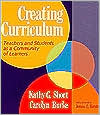 |
Creating Curriculum: Teachers and Students as a Community of
Learners
Author: Burke, Carolyn Short, Kathy Gnagey Short,
Kathy G.
ISBN: 0-435-08590-5
LCCN:
91015145
Dewey: 375/.00973 20
Number:
|
Category: Curriculum
planning & development
User Rating: 3.0 Stars
Pages:
84
Paperback Heinemann
Review �A powerful book which blends theory and practice, and challenges
learners to support each other in defining and making curricular
changes.��Teachers Networking Product Description A powerful
book which blends theory and practice, and challenges learners to support each
other in defining and making curricular changes. - Teachers Networking In
practice curriculum has historically been a hierarchy of skills and sequence
models imposed on teachers and students. This has been frustrating for teachers,
because it directed them to spend time covering specific topics rather than
addressing the more meaningful and overall point of education: learning.
Moreover, it has left the teacher with few decisions about what should happen in
the classroom and it has entirely omitted the students. This book is a true
primer--a work to be read in preparation for further discussion of curriculum.
The aim is to help teachers define some terms and consider the purposes of a
curriculum so that the goal of effective learning is not lost.
Creating an Inclusive School
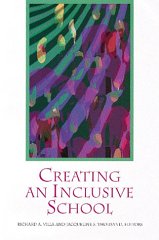 |
Creating an Inclusive School
Author: Villa, Richard
A. (Editor) Thousand, Jacqueline S. (Editor)
ISBN:
0-87120-251-4
LCCN: 95032532
Dewey: 371.9/046
20
Number:
|
Category:
Administration - General
User Rating: 5.0 Stars
Pages:
185
Paperback Association for Supervision & Curriculum Deve
Book Description This book is a comprehensive resource on inclusive
schooling--defined as including children and youth with disabilities in general
education classroom. Experts and practitioners discuss the foundation of
inclusion and describe promising practices in K-12 schools. Contributors show
how schools can provide a "least restricted environment" for students with
disabilities through inclusive schooling, using cooperative learning, teaming,
multi-age grouping, multicultural education, social skills training, and
educational technology applications. "Voices of Inclusion" tell personal stories
about people with disabilities and the educators and parents who work with them.
The book also addresses how to manage change in education and how to adapt
curriculum in an inclusive classroom, answers frequently asked questions, and
lists extensive resources for educators.
Creating An Inclusive School
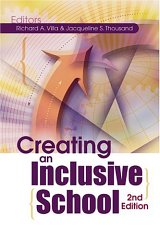 |
Creating An Inclusive School
Author: Villa, Richard
A. (Editor) Thousand, Jacqueline S. (Editor)
ISBN:
1-4166-0049-3
LCCN: 2004023185
Dewey: 371.9/046
22
Number:
|
Category:
Special Education - General
User Rating: 5.0 Stars
Pages:
219
Paperback Association for Supervision & Curriculum Deve
Book Description In this comprehensive resource on inclusive schooling,
administrators, general and special educators, and parents explore how inclusive
education can support a diverse student body at all grade levels. They show how
schools can meet standards and provide a "least restrictive environment" for
students with disabilities by using cooperative learning, teaming, multi-age
grouping, multicultural education, social skills training, and educational
technology applications. And they explain how to facilitate change by using
universal design principles and other curricular, instructional, assessment, and
organizational practices. The authors examine the prevailing myths and the most
frequently asked questions about inclusive education, and they provide an
extensive list of resources. Woven through the book are the personal stories of
people with disabilities and the educators and parents who work with them. As
their voices make clear, inclusion is more than an educational buzzword;
inclusion is a way of life, based on the belief that each individual is valued
and belongs. Richard A. Villa, Ed.D., has worked with thousands of teachers and
administrators to develop and implement instructional support systems for
educating all students within general education settings. Jacqueline S.
Thousand, Ph.D., is a professor in the College of Education at California State
University, San Marcos, where she coordinates the college's special education
credential and masters programs.
The Courage to Teach: Exploring the Inner Landscape of a Teacher's
Life
 |
The Courage to Teach: Exploring the Inner Landscape of a Teacher's
Life
Author: Palmer, Parker J.
ISBN:
0-7879-1058-9
LCCN: 97021161
Dewey: 371.102
21
Number:
|
Category:
Teaching skills & techniques
User Rating: 4.0
Stars
Pages: 224
Hardcover Jossey-Bass
Amazon.com As a spiritually inspirational book for teachers, The Courage to
Teach is one of the best. The premise is concise and unarguable: good teaching
comes from the identity and the integrity of the teacher. Teachers are
encouraged to turn their inquiring minds inward--developing a deeper
understanding of what it means to fulfill the spiritual calling of teaching.
Good teachers share one trait, says author Parker Palmer, they are able to weave
a complex web of connections among themselves, their subjects, and their
students, so that students can learn to weave a world for themselves. The
connections made by good teachers are held not in their methods but in their
hearts--the place where intellect and emotion and spirit and will converge in
the human self. --Gail Hudson From Library Journal Palmer (To Know as We Are
Known, HarperCollins, 1993) is a senior adviser at the Fetzer Institute and has
taught at Beloit College and Georgetown University. He discusses the inner life
of the dedicated teacher and how that life shapes teaching and learning.
According to Palmer, "Teaching, like any truly human activity, emerges from
one's inwardness, for better or worse." In this book, he explores the inner
landscape of the teaching self, and to understand that landscape more fully, he
discusses three important paths that must be taken?intellectual, emotional, and
spiritual. Recommended for all teachers, this book would be a valuable addition
to professional and teacher education collections.?Barbara S. Meagher, Central
Connecticut State Univ., New Britain Copyright 1998 Reed Business Information,
Inc.
Cooperative Learning & Mathematics Grades K-8
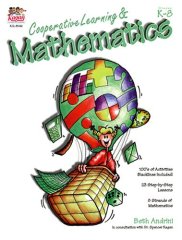 |
Cooperative Learning & Mathematics Grades K-8
Author:
Andrini, Beth Teachers, Resources for
ISBN:
1-879097-04-4
LCCN:
Dewey:
Number:
|
Category:
Mathematics
User Rating: 5.0 Stars
Pages: 100
Paperback Kagan Cooperative Learning
Cooperative Learning Resources for Teachers
|
Cooperative Learning Resources for Teachers
Author:
Spencer Kagen
ISBN:
LCCN:
Dewey:
Number:
|
Category:
User Rating: Pages: 0
Spiral-bound Resources for Teachers
Content Knowledge: A Compendium of Standards and Benchmarks for K-12
Education, 2nd edition
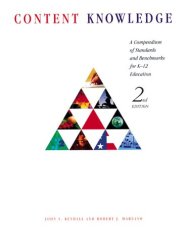 |
Content Knowledge: A Compendium of Standards and Benchmarks for
K-12 Education, 2nd edition
Author: Kendall, John S.
Marzano, Robert J.
ISBN: 0-87120-301-4
LCCN:
97037866
Dewey: 379.1/58 21
Number:
|
Category:
Finance
User Rating: 5.0 Stars
Pages: 651
Paperback McRel
Book Description Are you familiar with the education standards developed by
the National Council of Teachers of Mathematics? The science standards developed
by the National Research Council? The science "literacy goals" proposed by the
American Association for the Advancement of Science? In Content Knowledge you'll
find information on all the major subject areas, organized to allow you and
others in your school or district to quickly and easily explore the variety of
education standards and benchmarks in use today. The authors have consulted 116
national and state-level documents that address standards and benchmarks. By
putting all the standards in a clear, consistent format, they have streamlined
the process of developing standards-based curriculum and instruction in K-12
mathematics, science, history, language arts, the arts, technology, civics,
economics, foreign languages, health, physical education, behavioral studies,
and life skills. In each subject, you'll find clear and succinct summaries of
standards and benchmarks at various grade levels, K-12. Benchmarks are keyed to
three broad categories of knowledge (procedural, declarative, or contextual
knowledge), making it easy to identify targets for learning at every level.
There are more than 250 standards and 3,900 benchmarks in all. Whether used as a
resource for creating new standards or as a reference for validating existing
standards, Content Knowledge is an indispensable resource for every school.
Conscious discipline
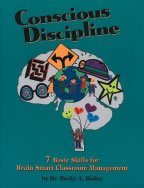 |
Conscious discipline
Author: Bailey, Rebecca Anne
Bailey, Becky A. A.
ISBN: 1-889609-11-0
LCCN:
99066610
Dewey:
Number:
|
Category: Classroom
Management
User Rating: 5.0 Stars
Pages: 256
Unknown Binding Loving Guidance
Product Description Learn a complete classroom management system and
emotional intelligence program based on safety, connection, and problem solving.
Seven basic skills for brain smart classroom management from Dr. Becky Bailey.
Paperback, 236 pages.
Conflict Resolution Activities That Work!
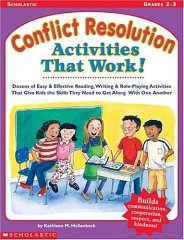 |
Conflict Resolution Activities That Work!
Author:
Hollenbeck, Kathleen M.
ISBN: 0-439-11113-7
LCCN:
Dewey:
Number:
|
Category: Behavior Management
User Rating: 5.0
Stars
Pages: 64
Paperback Scholastic
Book Description Dozens of Easy & Effective Reading, Writing &
Role-Playing Activities That Give Kids the Skills They Need to Get Along With
One Another Builds Kindness & Cooperation! Help kids listen, communicate,
cooperate & respect one another with quick, engaging activities,
reproducibles, a play, a game & more. About the Author Kathleen M.
Hollenbeck has written several picture books for children and numerous
curriculum and resource materials for teachers. She is the author of Exploring
Our World: Neighborhoods and Communities, Fresh & Fun: Thanksgiving, and
Teaching With Favorite Leo Lionni Books (Scholastic Teaching Resources).
Kathleen lives in Coventry, RI with her husband and three children.
Conflict of Interests: The Politics of American
Education
|
Conflict of Interests: The Politics of American
Education
Author: Spring, Joel H.
ISBN:
0-8013-0789-9
LCCN: 92003377
Dewey: 379.73
20
Number:
|
Category:
Administration
User Rating: 3.5 Stars
Pages: 238
Paperback Longman Pub Group
Includes bibliographical references and index.
A Comprehensive Guide to Designing Standards-Based Districts, Schools, and
Classrooms
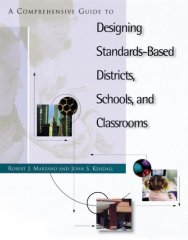 |
A Comprehensive Guide to Designing Standards-Based Districts,
Schools, and Classrooms
Author: Marzano, Robert J. Kendall,
John S.
ISBN: 0-87120-277-8
LCCN:
96036835
Dewey: 379.158/0973 21
Number:
|
Category: Educational
administration
User Rating: 5.0 Stars
Pages: 305
Paperback Association for Supervision & Curriculum Deve
Book Description What are standards? Who sets them? How can educators and
students be held accountable? This guide to standards-based schooling answers
all these questions and more while providing many essential tools for
standards-based education: - examples of performance tasks and rubrics for
assessing students on achievement of standards - suggestions for how to track
student progress in meeting and exceeding standards - sample report cards
showing how to report student progress on achieving standards All advice and
recommendations are drawn from standards-based efforts that have taken place in
hundreds of schools.
Collaborative Analysis of Student Work: Improving Teaching and
Learning
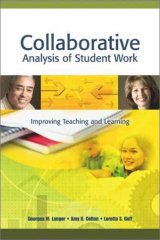 |
Collaborative Analysis of Student Work: Improving Teaching and
Learning
Author: Langer, Georgea M. Colton, Amy B. Goff,
Loretta S.
ISBN: 0-87120-784-2
LCCN:
2003011032
Dewey: 371.26/4 21
Number:
|
Category: Teaching
Methods & Materials - General
User Rating: 3.0 Stars
Pages:
212
Paperback Association for Supervision & Curriculum Deve
Book Description When teachers get together and apply their combined
knowledge and experience to the challenges of teaching and learning, amazing
things can happen. In this book, you'll find out how to set up collaborative
analysis of student work in your school. Developed and refined with more than
100 elementary and secondary teachers, this adaptable system combines the best
of action research, study groups, standards-based learning, student assessment,
teacher reflection, and portfolio assessment. The authors guide you through each
component with concrete, detailed descriptions and authentic examples. You'll
learn * ideas for setting up effective study groups * strategies for documenting
students' progress toward learning standards * methods for reflecting on
professional growth * ways to share the benefits with colleagues and students.
This system of professional inquiry challenges you to examine your beliefs about
what students can do and helps you identify which teaching methods are working
most successfully. You and your colleagues can acquire deeper insight into the
link between your instruction and each student's learning-and enhance your
ability to help every student succeed. Download Description When teachers get
together and apply their combined knowledge and experience to the challenges of
teaching and learning, amazing things can happen. In this book, you'll find out
how to set up collaborative analysis of student work in your school. Developed
and refined with more than 100 elementary and secondary teachers, this adaptable
system combines the best of action research, study groups, standards-based
learning, student assessment, teacher reflection, and portfolio assessment. The
authors guide you through each component with concrete, detailed descriptions
and authentic examples. You'll learn * ideas for setting up effective study
groups * strategies for documenting students' progress toward learning standards
* methods for reflecting on professional growth * ways to share the benefits
with colleagues and students. This system of professional inquiry challenges you
to examine your beliefs about what students can do and helps you identify which
teaching methods are working most successfully. You and your colleagues can
acquire deeper insight into the link between your instruction and each student's
learning-and enhance your ability to help every student succeed.
Collaboration for Diverse Learners: Viewpoints and
Practices
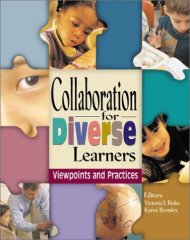 |
Collaboration for Diverse Learners: Viewpoints and
Practices
Author: Risko, Victoria J. (Editor) Bromley, Karen
(Editor) IRA (Editor) Staff, IRA
ISBN:
0-87207-283-5
LCCN: 00011158
Dewey: 372.6
21
Number:
|
Category:
Teaching of specific groups
User Rating: 5.0 Stars
Pages:
440
Paperback Lawrence Erlbaum
Product Description Educators often feel frustrated by their school's lack of
comprehensive programs to address the needs of diverse learners. Many noted
literacy experts believe that school programs for diverse learners will remain
ineffectual until instruction involves teachers, specialists, administrators,
and families in collaborative decision making, mediation, negotiation, and
respect for differences. Collaboration for Diverse Learners brings together
several expert perspectives on achieving effective collaboration to accelerate
the literacy development of diverse learners. You will find in this important
volume many resources to guide your own decision making and development of
successful collaboration programs: in-depth analyses of collaborative efforts,
multiple ways to think about collaboration and its implementation, and examples
of collaborative projects that are successfully in place in schools throughout
the United States. You'll be especially inspired by the first-hand stories of
educators, children, and families who present the possibilities for partnerships
that advance the learning of all students. Published by International Reading
Association
Classroom Strategies For Helping At-Risk Students
 |
Classroom Strategies For Helping At-Risk Students
Author:
Snow, David R. Barley, Zoe A. Lauer, Patricia A.
ISBN:
1-4166-0202-X
LCCN: 2004028823
Dewey: 371.93
22
Number:
|
Category:
Special Education - Socially Handicapped
User Rating: 1.0
Stars
Pages: 114
Paperback Association for Supervision & Curriculum Deve
Book Description Classroom Strategies for Helping At-Risk Students is
essential reading for busy teachers who want to use high-quality research to
guide their practice. It synthesizes the results of 118 studies of students at
risk of failure and identifies six general strategies proven to be positive
interventions. The book describes each strategy, analyzes the research, and
offers implications for deciding how to use the strategies. A discussion guide
helps readers directly connect the research to their own classrooms. Whether
you're a new or experienced teacher, this authoritative book will deepen your
understanding of effective teaching methods and help you work more successfully
with low-performing students. Download Description Classroom Strategies for
Helping At-Risk Students is essential reading for busy teachers who want to use
high-quality research to guide their practice. It synthesizes the results of 118
studies of students at risk of failure and identifies six general strategies
proven to be positive interventions. The book describes each strategy, analyzes
the research, and offers implications for deciding how to use the strategies. A
discussion guide helps readers directly connect the research to their own
classrooms. Whether you're a new or experienced teacher, this authoritative book
will deepen your understanding of effective teaching methods and help you work
more successfully with low-performing students.
Classroom of Choice
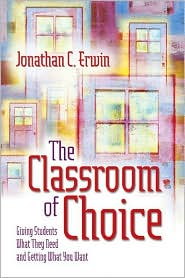 |
Classroom of Choice
Author: Erwin, Jonathan
ISBN: 0-87120-829-6
LCCN: 2004001824
Dewey:
371.102/4 22
Number:
|
Category: Teaching & Teacher Training
User Rating:
1.5 Stars
Pages: 229
Paperback Association for Supervision & Curriculum Development
From the Publisher Teachers everywhere face the daily challenge of engaging
students whose knowledge, skills, needs, and temperaments vary greatly. How does
a teacher establish a learning environment that supports the class as a whole
while meeting the particular needs of individual students? Teacher Jonathan C.
Erwin believes the answer lies in offering real opportunities to students rather
than throwing up the obstacles inherent to traditional discipline and motivation
techniques. At the heart of his approach are the five basic human needs of
William Glasser's Choice Theory: survival and security, love and belonging,
power through cooperation and competency, freedom, and fun. By understanding and
attending to these needs, teachers can customize and manage a classroom
environment where students learn to motivate and monitor themselves. Drawing on
theories and practices from experts in a variety of learning techniques, Erwin
explores each of the five basic needs to create nearly 200 adaptable strategies
for teaching and classroom management at any grade level. Readers will find
dozens of ideas for helping students make positive changes, including *
Improving their work habits, * Connecting curriculum with individual interests,
* Opening lines of communication with teachers and other students, * Boosting
self-worth through accomplishment, and * Supporting their classmates in
cooperative work. Erwin ties everything together in a unit guide that allows
teachers to develop a classroom profile based on the needs of individual
students. The guide can be used with any district planning approach or
curriculum. For teachers seeking a win-win situation in managing their
classrooms, The Classroom of Choice is an excellent aid in creating a learning
environment where students and teachers approach each day with energy and
enthusiasm. Synopsis Teachers everywhere face the daily challenge of engaging
students whose knowledge, skills, needs, and temperaments vary greatly. How does
a teacher establish a learning environment that supports the class as a whole
while meeting the particular needs of individual students? Teacher Jonathan C.
Erwin believes the answer lies in offering real opportunities to students rather
than throwing up the obstacles inherent to traditional discipline and motivation
techniques. At the heart of his approach are the five basic human needs of
William Glasser's Choice Theory: survival and security, love and belonging,
power through cooperation and competency, freedom, and fun. By understanding and
attending to these needs, teachers can customize and manage a classroom
environment where students learn to motivate and monitor themselves. Drawing on
theories and practices from experts in a variety of learning techniques, Erwin
explores each of the five basic needs to create nearly 200 adaptable strategies
for teaching and classroom management at any grade level. Readers will find
dozens of ideas for helping students make positive changes, including *
Improving their work habits, * Connecting curriculum with individual interests,
* Opening lines of communication with teachers and other students, * Boosting
self-worth through accomplishment, and * Supporting their classmates in
cooperative work. Erwin ties everything together in a unit guide that allows
teachers to develop a classroom profile based on the needs of individual
students. The guide can be used with any district planning approach or
curriculum. For teachers seeking a win-win situation in managing their
classrooms, The Classroom of Choice is an excellent aid in creating a learning
environment where students and teachers approach each day with energy and
enthusiasm.
Classroom Management That Works: Research-Based Strategies for Every
Teacher
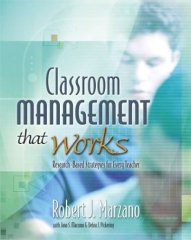 |
Classroom Management That Works: Research-Based Strategies for
Every Teacher
Author: Marzano, Robert J. Marzano, Jana S.
Pickering, Debra J.
ISBN: 0-87120-793-1
LCCN:
2003013237
Dewey: 371.102/4 21
Number:
|
Category: Education /
Teaching
User Rating: 4.0 Stars
Pages: 143
Paperback Association for Supervision & Curriculum Deve
Book Description How does classroom management affect student achievement?
What techniques do teachers find most effective? How important are schoolwide
policies and practices in setting the tone for individual classroom management?
In this follow-up to What Works in Schools, Robert J. Marzano analyzes research
from more than 100 studies on classroom management to discover the answers to
these questions and more. He then applies these findings to a series of "Action
Steps"--specific strategies that educators can use to ? Get the classroom
management effort off to a good start, ? Establish effective rules and
procedures, ? Implement appropriate disciplinary interventions, ? Foster
productive student-teacher relationships, ? Develop a positive "mental set," ?
Help students contribute to a positive learning environment, and ? Activate
schoolwide measures for effective classroom management. Marzano and his
coauthors Jana S. Marzano and Debra Pickering provide real stories of teachers
and students in classroom situations to help illustrate how the action steps can
be used successfully in different situations. In each chapter, they also review
the strengths and weaknesses of programs with proven track records. With student
behavior and effective discipline a growing concern in schools, this
comprehensive analysis is a timely guide to the critical role of classroom
management in student learning and achievement. Download Description How does
classroom management affect student achievement? What techniques do teachers
find most effective? How important are schoolwide policies and practices in
setting the tone for individual classroom management? In this follow-up to What
Works in Schools, Robert J. Marzano analyzes research from more than 100 studies
on classroom management to discover the answers to these questions and more. He
then applies these findings to a series of "Action Steps"--specific strategies
that educators can use to . Get the classroom management effort off to a good
start, . Establish effective rules and procedures, . Implement appropriate
disciplinary interventions, . Foster productive student-teacher relationships, .
Develop a positive "mental set," . Help students contribute to a positive
learning environment, and . Activate schoolwide measures for effective classroom
management. Marzano and his coauthors Jana S. Marzano and Debra Pickering
provide real stories of teachers and students in classroom situations to help
illustrate how the action steps can be used successfully in different
situations. In each chapter, they also review the strengths and weaknesses of
programs with proven track records. With student behavior and effective
discipline a growing concern in schools, this comprehensive analysis is a timely
guide to the critical role of classroom management in student learning and
achievement.
Classroom Management for All Teachers: 11 Effective
Plans
 |
Classroom Management for All Teachers: 11 Effective
Plans
Author: Cipani, Ennio
ISBN:
0-13-520933-1
LCCN: 97027671
Dewey: 371.102/4
21
Number:
|
Category:
Teaching skills & techniques
User Rating: 3.5
Stars
Pages: 168
Paperback Prentice Hall
Book Description This in-depth book bridges the gap between educational
theory and the classroom with eleven practical classroom management plans
designed to be applied to actual teaching situations. Easy to implement, these
plans cover two primary circumstances: student on-task and assignment completion
problems and student disruptive behavior and rule violations. KEY TOPICS:
Written with a minimum of jargon, Classroom Management for All Teachers provides
definitions of behavioral terminology and hypothetical examples that demonstrate
the effects of specific techniques in a classroom setting. Each plan includes a
brief description, baseline measurement tools, step-by-step implementation
procedures, hypothetical applications, a selection of reproducible forms, and
more. An essential resource for every educator, school administrator, and school
psychologist. From the Back Cover This in-depth book bridges the gap between
educational theory and the classroom with eleven practical classroom management
plans designed to be applied to actual teaching situations. Easy to implement,
these plans cover two primary circumstances: student on-task and assignment
completion problems and student disruptive behavior and rule violations. Written
with a minimum of jargon, Classroom Management for All Teachers provides
definitions of behavioral terminology and hypothetical examples that demonstrate
the effects of specific techniques in a classroom setting. Each plan includes a
brief description, baseline measurement tools, step-by-step implementation
procedures, hypothetical applications, a selection of reproducible forms, and
more. An essential resource for every educator, school administrator, and school
psychologist.
Classroom Instruction That Works: Research-Based Strategies for Increasing
Student Achievement
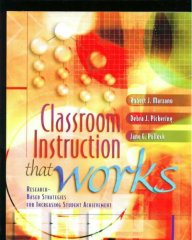 |
Classroom Instruction That Works: Research-Based Strategies for
Increasing Student Achievement
Author: Marzano, Robert J.
Pickering, Debra Pollock, Jane E.
ISBN:
0-87120-504-1
LCCN: 00012007
Dewey: 371.102
21
Number:
|
Category:
Teaching skills & techniques
User Rating: 4.0
Stars
Pages: 178
Paperback Association for Supervision & Curriculum Deve
Book Description What works in education? How do we know? How can teachers
find out? How can educational research find its way into the classroom? How can
we apply it to help our individual students? Questions like these arise in most
schools, and busy educators often don't have time to find the answers. Robert J.
Marzano, Debra J. Pickering, and Jane E. Pollock have examined decades of
research findings to distill the results into nine broad teaching strategies
that have positive effects on student learning: * Identifying similarities and
differences. * Summarizing and note taking. * Reinforcing effort and providing
recognition. * Homework and practice. * Nonlinguistic representations. *
Cooperative learning. * Setting objectives and providing feedback. * Generating
and testing hypotheses. * Questions, cues, and advance organizers. This list is
not new. But what is surprising is finding out what a big difference it makes,
for example, when students learn how to take good notes, work in groups, and use
graphic organizers. The authors provide statistical effect sizes and show how
these translate into percentile gains for students, for each strategy. And each
chapter presents extended classroom examples of teachers and students in action;
models of successful instruction; and many "frames," rubrics, organizers, and
charts to help teachers plan and implement the strategies.
Circles of learning: Cooperation in the classroom
|
Circles of learning: Cooperation in the classroom
Author:
Johnson, David W Johnson, Roger T.
ISBN:
0-939603-01-2
LCCN: 86081701
Dewey: 371.3/95
20
Number:
|
Category:
Cooperativeness in education
User Rating: 5.0 Stars
Pages:
124
Unknown Binding Interaction Book Co
"Revised." Rev. ed. of: Circles of learning / David W. Johnson ... [et al.].
c1984. Includes bibliographical references.
The Children's Machine: Rethinking School In The Age Of The
Computer
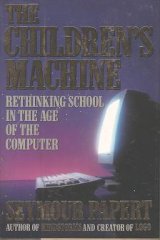 |
The Children's Machine: Rethinking School In The Age Of The
Computer
Author: Papert, Seymour A.
ISBN:
0-465-01830-0
LCCN: 91059012
Dewey: 371.3/34
20
Number:
|
Category:
Applications of Computing
User Rating: 4.0 Stars
Pages:
288
Hardcover Basic Books
From Kirkus Reviews The genially unorthodox author of Mindstorms (1983) again
makes a stimulating case for computers as a primary route to knowledge, revising
and expanding earlier observations in view of disappointing school policies of
the past dozen years. Rejecting most schools as ``sluggish and timid'' in
assuring access to learning, Papert (Mathematics and Education/MIT) divides the
conservative education world into ``Schoolers'' (who acknowledge underlying
problems but focus on short-term urgent ones) and ``Yearners'' (who create their
own small-scale alternatives) as he considers why technology hasn't
revolutionized school learning. Championing computers for offering forms of
learning that can be ``quick, immensely compelling, and rewarding,'' Papert
contends that Logo (the computer language he conceived) is a superior mode of
learning for young children, closer to their informal learning style than
traditional classroom approaches and invaluable as a medium for most areas of
study. But schools have ignored computers' broad capacities, he finds, isolating
these tools from the learning process instead of integrating them into all areas
of instruction. Papert offers a steady supply of examples--from his own
extensive experience as well as from assorted classrooms--providing evidence of
computers as powerful learning allies. He also understands the nature of
learning--the importance of the personal element in any classroom exchange; the
need to adapt a learning-environment design to its social and cultural milieu;
the ``internal censors'' that students bring to required work; and the way that
ordered ideas can emerge from an imprecise, undirected process. Even those who
resist Papert's belief that the foundation of modern schooling is faulty will
agree with his central theme that the ability to learn new skills is the most
critical skill of all- -and that computers have a unique, accelerating role to
play in developing that ability. -- Copyright ©1993, Kirkus Associates, LP. All
rights reserved. Product Description In his classsic book, Mindstorms: Children,
Computers, and powerful Ideas, Seymour Papert set out a vision of how computers
could change school. In The Children's Machine he now looks back over a decade
during which American schools acquired more than three million computers and
assesses progress and resistance to progress.
Chicken Soup for the Teacher's Soul: Stories to Open the Hearts and Rekindle
the Spirit of Educators
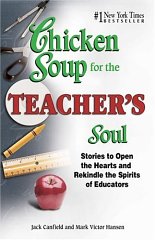 |
Chicken Soup for the Teacher's Soul: Stories to Open the Hearts and
Rekindle the Spirit of Educators
Author: Canfield, Jack
Hansen, Mark Victor Hansen, Mark Victor
ISBN:
1-55874-978-0
LCCN: 2002020893
Dewey: 371.1
21
Number:
|
Category:
Education
User Rating: 4.5 Stars
Pages: 384
Paperback HCI
Amazon.com It's no secret that teachers are underpaid, overworked, and
undervalued, and bestselling authors Jack Canfield and Mark Victor Hansen have
compiled Chicken Soup for the Teacher's Soul as both a tribute and encouragement
to those who make a difference in the lives of their students. It's inspiration
in bite-sized, manageable chunks. Under 11 different topical headings such as "A
Day in the Life" and "Overcoming Obstacles," readers will discover motivating
quotes ("Love first, teach second"), hilarious cartoons, and touching stories
that combine to make this book a testimonial of thanks, sure to revitalize weary
educators. Teachers, coaches, childcare professionals, and educators--from
preschool to college, Sunday school to public school--will find in these pages a
renewed passion for changing lives, and fresh vision to go the extra mile with
every student. The essays are by turns entertaining, motivating, and funny, and
most are deeply touching. Keep the Kleenex handy. --Cindy Crosby Product
Description Most people recall a teacher or two who had a significant impact on
their future. In fact, outside the family unit, teachers have more influence on
our lives than anyone else. Good teachers help students believe in themselves
with a glimpse of what they might become. They go the extra mile to make
learning fun and meaningful, and they inspire students to dream and broaden
their horizons. Teachers have the power to change lives. Written by a wide range
of teachers, counselors, administrators, educational consultants and former
students, the stories in Chicken Soup for the
Teacher's Soul will convince teachers that they're needed now more than
ever. Chicken Soup for the Teacher's
Soul is required reading for every teacher, student and former student.
Readers will learn treasured lessons on the importance of encouragement, the
power of love, the value of taking a risk in the classroom, and the need for
mentors and allies. Teachers will recognize themselves and their students in
these stories of hope and love. They will see their growing challenges as
newfound opportunities to transform lives.
Chicken Soup for the Teacher's Soul
|
Chicken Soup for the Teacher's Soul
Author: No Author
ISBN: 0-439-45806-4
LCCN:
Dewey:
Number:
|
Category:
User Rating: 4.0 Stars
Pages: 385
Hardcover Scholastic
Character Under Attack: & What You Can Do About It
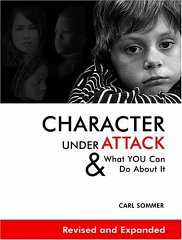 |
Character Under Attack: & What You Can Do About
It
Author: Sommer, Carl
ISBN:
1-57537-352-1
LCCN: 2005008539
Dewey: 370.11/4
22
Number:
|
Category:
Education
User Rating: 2.5 Stars
Pages: 112
Hardcover Advance Publishing
Review ...Hope that others will grasp your philosophy and begin to make
positive changes, one child at a time. --Jeff Fritz, Principal, Jackson
Township Elementary School ...Thank you for your boldness in stepping out in
this area that is so badly needed. Character Definitely Counts!!! --Karen A.
Heard, Librarian Fairacres Elementary ...I love this book and plan to buy more
of his books for our district libraries. --Georgia Witt, District Librarian,
Orange Grove I.S.D. Review ...Thank you for your boldness in stepping out in
this area that is so badly needed. Character Definitely Counts!!! --Karen A.
Heard, Librarian Fairacres Elementary
Change Forces: The Sequel
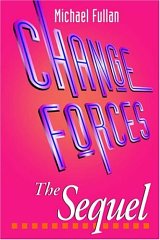 |
Change Forces: The Sequel
Author: Fullan, Michael
Goodson, Ivor F. Hargreaves, Andy Archer, Caroline
ISBN:
0-7507-0755-0
LCCN: 99211205
Dewey:
Number:
|
Category: Organization
& management of education
User Rating: 4.0 Stars
Pages:
90
Paperback Falmer Press
Review Stirs the imagination, engages the mind, uplifting to the human soul.
Energizing. Captivating. Ground-breaking truth. -Alice P. Thomas, Founder,
President and CEO, for Development & Learning (CDL) I'm reading The Sequel,
with delight. It's super--not only because it's stimulating to the mind, but
also because it's good for the soul. I'm feeling reinvigorated. -Annette Tromly,
Executive Director, Walter & Duncan Gordon Charitable Foundation Praise for
Change Forces: This book is excellent. It says all the things I want teachers to
hear and act upon about managing their own learning, about balancing life and
work, and about how schools need to invest in teacher learning and look to how
they become learning organizations. -Management Learning Nobody is more
knowledgeable about school change than Michael Fullan. Through his writing for
practitioners and scholars, he has done a tremendous amount to build a wide
understanding of the technical and cultural dimensions of educational reform.
Change Forces:The Sequel contributes to that legacy by adding contextual and
theoretical flesh. -Journal of Education for Students Placed at Risk --This text
refers to the Hardcover edition. Product Description Fullan's first book on this
subject was an instant and best-selling success. Now, in Change Forces, The
Sequel, he extends and expands the use of chaos theory as a lens through which
to view and comprehend change, and the forces which govern it. Educators have
already widely embraced this approach, and adopted the idea that change is not
so straightforward as we might hope. As Fullan worked on his ideas, relating
them to school systems, higher education and research, the field of change
forces also developed significantly. This volume covers the new aspects of this
science of complexity and helps educators obtain insights for delving deeper
into moral purpose and expanding into fresh dimensions of changing forces in the
environment. --This text refers to the Hardcover edition.
Change Forces: Probing the Depths of Educational Reform
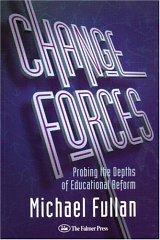 |
Change Forces: Probing the Depths of Educational
Reform
Author: Fullan, Michael Michael, Fullan
ISBN: 1-85000-826-4
LCCN: 93014364
Dewey:
371.2 20
Number:
|
Category: Organization & management of education
User
Rating: 5.0 Stars
Pages: 176
Paperback Routledge
Review This book is excellent. It says all the things I want teachers to hear
and act upon about managing their own learning, about balancing life and work,
and about how schools need to invest in teacher learning and look at how they
become learning organizations. -Management Learning A provacative and
stimulating book. I defy any reader not to be engaged. This is a challenging and
optimistic book. Its readiblity will make it acceptable to a wide range of
audiences. -Educational Management Fullan signals that this book will seriously
address divisive political and normative issues, eschewing the neutral approach
to change that has plagued many otherwise excellent analyses of school reform
the past decades. Changes Forces: The Sequel takes on a herculean task:moving
beyond a neutral analysis of educational change while using business literature
that offers little or no normative or political insight...Nobody is more
knowledgeable about school change than Michael Fullan. Through his writing for
practitioners and scholars, he has done a tremendous amount to build a wide
understanding the technical and cultural dimensions of educational reform.
Change Forces: The Sequel, contributes to that legacy by adding contextual and
theoretical flesh.... -Journal of Education for students placed at risk moving
This book is excellent. It says all the things I want teachers to hear and act
upon about managing their own learning, about balancing life and work, and about
how schools need to invest in teacher learning and look how they become learning
organizations. -Management Learning Review This book is excellent. It says all
the things I want teachers to hear and act upon about managing their own
learning, about balancing life and work, and about how schools need to invest in
teacher learning and look at how they become learning organizations. -Management
Learning A provacative and stimulating book. I defy any reader not to be
engaged. This is a challenging and optimistic book. Its readiblity will make it
acceptable to a wide range of audiences. -Educational Management Fullan signals
that this book will seriously address divisive political and normative issues,
eschewing the neutral approach to change that has plagued many otherwise
excellent analyses of school reform the past decades. Changes Forces: The Sequel
takes on a herculean task:moving beyond a neutral analysis of educational change
while using business literature that offers little or no normative or political
insight...Nobody is more knowledgeable about school change than Michael Fullan.
Through his writing for practitioners and scholars, he has done a tremendous
amount to build a wide understanding the technical and cultural dimensions of
educational reform. Change Forces: The Sequel, contributes to that legacy by
adding contextual and theoretical flesh.... -Journal of Education for students
placed at risk moving This book is excellent. It says all the things I want
teachers to hear and act upon about managing their own learning, about balancing
life and work, and about how schools need to invest in teacher learning and look
how they become learning organizations. -Management Learning
A Celebration of Neurons: An Educator's Guide to the Human
Brain
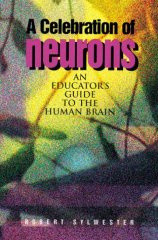 |
A Celebration of Neurons: An Educator's Guide to the Human
Brain
Author: Sylwester, Robert
ISBN:
0-87120-243-3
LCCN: 95004382
Dewey: 612.8/2
20
Number:
|
Category:
Human biology
User Rating: 4.0 Stars
Pages: 167
Paperback Association for Supervision & Curriculum Deve
Book Description Robert Sylwester offers educators an introduction to "the
only mass of matter in the known universe that can contemplate itself," the
human brain. We all know that the brain is where learning takes place, but how
many of us understand the brain's basic workings and use that understanding in
our work with students? How many of us keep up with new developments in brain
research that might have implications for teaching and learning? How many of us
can even identify the basic parts of the brain and when they mature? After
reading this book, you'll be able to identify the basic parts of the brain.
You'll also be able to discuss scientists' theories about how our brain
functions, how it interacts with the outside environment, how it determines
what's important, how it solves problems, how it adapts itself to its
environment, and how it learns, remembers, and forgets. "A Celebration of
Neurons" is more than an introduction to the brain, however; it is also an
urgent call for educators to become actively involved in discovering useful
applications for brain theory and research in the schools. Developments in brain
research have already provided scientific support for educational practices such
as cooperative learning, and new developments will almost certainly influence
other aspects of teaching and learning, from the content of the curriculum to
the layout of the classroom. The question we must ask ourselves now, says
Sylwester, is whether the education profession as a whole can continue to ignore
the significant role that brain research can play in improving teaching and
learning.
The Case for Mixed-Age Grouping in Early Childhood
Education
|
The Case for Mixed-Age Grouping in Early Childhood
Education
Author: Katz, Lillian G. Evangelou, Demetra
ISBN: 0-935989-31-5
LCCN: 90061182
Dewey:
372.12/54 20
Number:
|
Category: Ability grouping in education
User Rating:
5.0 Stars
Pages: 60
Paperback Natl Assn for the Education
Includes bibliographical references (p. 51-54).
California School Rules: A School-Smart Parent's Guide to Advocating for
Your Child
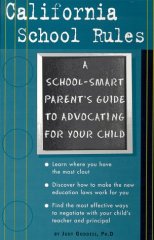 |
California School Rules: A School-Smart Parent's Guide to
Advocating for Your Child
Author: Judy, Ph.D. Goddess
ISBN: 1-887836-10-1
LCCN: 97026487
Dewey:
344.794/07 21
Number:
|
Category: Administrative Law & Regulatory
Practice
User Rating: 5.0 Stars
Pages: 214
Paperback Publishing 20/20
Book Description Parents who are puzzled by the policies governing California
schools now have a self-help law book to guide them. The author wrote the book
to help parents answer the question: "Hey, can they do that to my kid?" It
explores the legal side of problems that parents of school-age children often
encounter: choosing schools, learning English, how to keep good teachers (and
avoid bad ones), creating safer and more disciplined schools, contesting unfair
grades, and more. From the Publisher The question-answer format provides an easy
entry to the otherwise complicated laws that govern schools. The author's
conversational style and the 150 questions she answers will make for an
interesting read. This book has been a joy to publish. Our greatest pleasure has
been hearing from our customers. Parents write us. When the author appears on
radio shows that encourage call-ins, the switchboards light up. Educators have
found the book useful for clarifying legal issues with their staff, and have
used it to help settle disagreements with parents. One school board member from
San Francisco, Jill Wynns, wrote that the book "... is filled with useful
information which well-intentioned administrators often presume to be too
complex or technical for most parents." And a high school student, Nick
Rodriguez, who's an officer with the California Association of Student Councils,
called the book "the perfect tool for self-advocacy ... should be required
reading for every student."
Building Shared Responsibility for Student Learning
 |
Building Shared Responsibility for Student
Learning
Author: Conzemius, Anne O'Neill, Jan O'Neill, Jan
ISBN: 0-87120-597-1
LCCN: 2001006467
Dewey:
371.2/07 21
Number:
|
Category: Education
User Rating: 5.0
Stars
Pages: 146
Paperback Association for Supervision & Curriculum Deve
Book Description Who is responsible for student learning? Walk into an
effective school and ask this question of anyone-a teacher, a student, the
principal, a parent volunteer, a secretary-and you'll get the same answer: "I
am." Shared responsibility is something school communities build from within.
It's what happens when all school people accept that what they do makes a
difference in how all students learn . . . when they have the knowledge they
need to make informed decisions about the best way to promote learning . . . and
when they have the skills and opportunities to translate their ideas into
effective action. Anne Conzemius and Jan O'Neill present a practical framework
for building shared responsibility within schools and school systems. They
identify three critical components: * Focus--The common vision, mission, values,
and expectations that provide clarity and lead to new levels of performance. *
Reflection--The commitment to test assumptions, learn from data, and adjust
practices accordingly. * Collaboration--The process of developing relationships
where all work toward the same objectives and rely on each other to achieve
their goals. Building shared responsibility for student learning is an ongoing
activity--a journey and not a destination. This research-based resource provides
a map in the form of effective structures, systems, processes, and policies. It
explains how to set powerful goals and shares inspiring stories of educators who
have embarked on this journey toward higher professional competency, increased
staff satisfaction, rising test scores, and improved student results. Download
Description Who is responsible for student learning? Walk into an effective
school and ask this question of anyone-a teacher, a student, the principal, a
parent volunteer, a secretary-and you'll get the same answer: "I am." Shared
responsibility is something school communities build from within. It's what
happens when all school people accept that what they do makes a difference in
how all students learn . . . when they have the knowledge they need to make
informed decisions about the best way to promote learning . . . and when they
have the skills and opportunities to translate their ideas into effective
action. Anne Conzemius and Jan O'Neill present a practical framework for
building shared responsibility within schools and school systems. They identify
three critical components: * Focus--The common vision, mission, values, and
expectations that provide clarity and lead to new levels of performance. *
Reflection--The commitment to test assumptions, learn from data, and adjust
practices accordingly. * Collaboration--The process of developing relationships
where all work toward the same objectives and rely on each other to achieve
their goals. Building shared responsibility for student learning is an ongoing
activity--a journey and not a destination. This research-based resource provides
a map in the form of effective structures, systems, processes, and policies. It
explains how to set powerful goals and shares inspiring stories of educators who
have embarked on this journey toward higher professional competency, increased
staff satisfaction, rising test scores, and improved student results.
Building Leadership Capacity in Schools
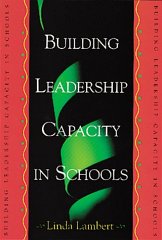 |
Building Leadership Capacity in Schools
Author:
Lambert, Linda Association for Supervision and Curriculum
ISBN: 0-87120-307-3
LCCN: 98040095
Dewey:
371.2/00973 21
Number:
|
Category: Educational Reform
User Rating: 3.5
Stars
Pages: 136
Paperback Association for Supervision & Curriculum Deve
Book Description In this book, Linda Lambert takes a close look at leadership
in schools, which today involves far more than a single leader. The author
defines leadership as the learning processes among participants in a
community--processes that lead toward a shared sense of purpose. Leadership
capacity refers to the breadth of participation in leadership and the depth of
skill that teachers, administrators, parents, students, and community members
bring to the work. The stories of three schools--an elementary school with low
leadership capacity, a middle school with moderate leadership capacity, and a
high school with high leadership capacity--reveal how school people can lead
their communities to improve student learning. The stories show five features of
effective leadership: (1) broad-based, skillful participation in the work of
leadership, (2) inquiry-based use of information to inform decisions and
practice, (3) roles and responsibilities that reflect broad involvement and
collaboration, (4) reflective practice/innovation as a norm, and (5) high
student achievement. This book outlines what schools and districts must do to
build leadership capacity, including how to get started, how to sustain the
momentum, and how to design school districts capable of supporting such work.
Bright Air, Brilliant Fire: On The Matter Of The Mind
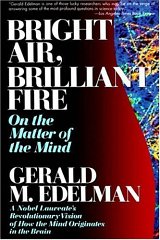 |
Bright Air, Brilliant Fire: On The Matter Of The
Mind
Author: Edelman, Gerald
ISBN:
0-465-00764-3
LCCN:
Dewey:
Number:
|
Category: Physiological
& neuro-psychology
User Rating: 4.5 Stars
Pages: 304
Paperback Basic Books
From Publishers Weekly In this challenging, exhilarating leap by a
disciplined and original mind, Nobel Prize-winner Edelman (medicine, 1972)
throws a neurobiological line between two ships--mind and matter--in the
stormiest of scientific seas. In his defense of the biological component of
mind, Edelman ( The Remembered Pres ent ) disposes of cognitive and behavioral
theories of consciousness. To take up the slack, he extends current developments
in brain neuroscience well into speculation. He is far too modest in stating
that his goal is "to dispel the notion that the mind can be understood in the
absence of biology," for the book is a near-kinetic series of critiques and
proposals to connect physics and psychology. The "Harmonies" section draws on
other disciplines--philosophy, linguistics and psychiatry, among others--to
entwine these tendrils of thought into a "unified theory" of mind. Illustrations
not seen by PW . Natural Science Book Club selection. Copyright 1992 Reed
Business Information, Inc. --This text refers to an out of print or unavailable
edition of this title. From Library Journal Edelman, Nobel laureate and director
of the Neurosciences Institute, is the author of three previous books on the
biology of the brain. His latest book advances the theory that the mind has
arisen through evolutionary morphology. According to Edelman, the mind is not a
kind of computer but a product of the biological forms that have developed
through natural selection. To support his theory, Edelman offers a mini-course
in modern molecular biology and development. By the author's own admission, this
is "strenuous" reading, complete with "strange vocabulary." Nevertheless,
Edelman presents his theory with enthusiasm and a genuine desire to discover the
origins of the mind. Readers well-grounded in physics, biology, and philosophy
will find his ideas extremely challenging. Primarily for academic libraries. -
Laurie Bartolini, Lincoln Lib., Springfield, Ill. Copyright 1992 Reed Business
Information, Inc. --This text refers to an out of print or unavailable edition
of this title.
Brain Matters: Translating Research into Classroom
Practice
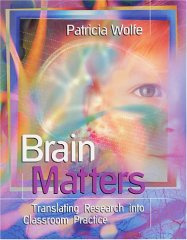 |
Brain Matters: Translating Research into Classroom
Practice
Author: Wolfe, Patricia
ISBN:
0-87120-517-3
LCCN: 2001002013
Dewey: 370.15/23
21
Number:
|
Category:
Educational Psychology
User Rating: 4.5 Stars
Pages:
207
Paperback Association for Supervision & Curriculum Deve
Book Description Everyone agrees that what we do in schools should be based
on what we know about how our brain learns. Until recently, however, we have had
few clues to unlock the secrets of the brain. Now, research from the
neurosciences has greatly improved our understanding of the learning process,
and we have a much more solid foundation on which to base educational decisions.
In this book, Patricia Wolfe makes it clear that before we can effectively match
teaching practice to brain functioning, we must first understand how the brain
functions. In Part I, several chapters act as a mini-textbook on brain anatomy
and physiology. Then, in Part II, Wolfe brings brain functioning into clearer
focus, describing how the brain encodes, manipulates, and stores information.
This information-processing model provides a first look at some implications of
the research for practice--why meaning is essential for attention, how emotion
can enhance or impede learning, and how different types of rehearsal are
necessary for different types of learning. In Part III, Wolfe devotes several
chapters to practical classroom applications and brain-compatible teaching
strategies. This section shows how to use simulations, projects, problem-based
learning, graphic organizers, music, rhyme and rhythm, writing, active
engagement, and mnemonics. Each chapter provides examples using brief scenarios
from actual classroom practice, from the lower elementary grades to high school.
The book also includes a glossary of terms. Download Description Everyone agrees
that what we do in schools should be based on what we know about how our brain
learns. Until recently, however, we have had few clues to unlock the secrets of
the brain. Now, research from the neurosciences has greatly improved our
understanding of the learning process, and we have a much more solid foundation
on which to base educational decisions. In this book, Patricia Wolfe makes it
clear that before we can effectively match teaching practice to brain
functioning, we must first understand how the brain functions. In Part I,
several chapters act as a mini-textbook on brain anatomy and physiology. Then,
in Part II, Wolfe brings brain functioning into clearer focus, describing how
the brain encodes, manipulates, and stores information. This
information-processing model provides a first look at some implications of the
research for practice--why meaning is essential for attention, how emotion can
enhance or impede learning, and how different types of rehearsal are necessary
for different types of learning. In Part III, Wolfe devotes several chapters to
practical classroom applications and brain-compatible teaching strategies. This
section shows how to use simulations, projects, problem-based learning, graphic
organizers, music, rhyme and rhythm, writing, active engagement, and mnemonics.
Each chapter provides examples using brief scenarios from actual classroom
practice, from the lower elementary grades to high school. The book also
includes a glossary of terms.
Blueprints for Thinking in the Cooperative Classroom
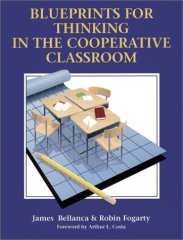 |
Blueprints for Thinking in the Cooperative
Classroom
Author: Bellanca, James Fogarty, Robin
ISBN: 0-932935-30-3
LCCN: 91156364
Dewey:
371.3/078 20
Number:
|
Category: Advice on careers & achieving success
User
Rating: 5.0 Stars
Pages: 362
Paperback Skylight Publishing
Book Description Beginning with the nitty-gritty of forming cooperative
learning groups, this book directs you step-by-step through the phases of
creating a cooperative classroom.
The Big Picture: Education Is Everyone's Business
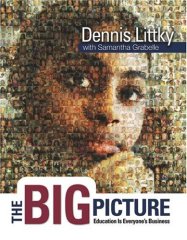 |
The Big Picture: Education Is Everyone's Business
Author:
Littky, Dennis Grabelle, Samantha
ISBN:
0-87120-971-3
LCCN: 2004009161
Dewey: 370/.973
22
Number:
|
Category:
Parent Participation
User Rating: 4.5 Stars
Pages:
230
Paperback Association for Supervision & Curriculum Deve
Book Description What is the purpose of education? What kind of people do we
want our children to grow up to be? How can we design schools so that students
will acquire the skills they'll need to live fulfilled and productive lives?
These are just a few of the questions that renowned educator Dennis Littky
explores in The Big Picture: Education Is Everyone's Business. The schools
Littky has created and led over the past 35 years are models for reformers
everywhere: small, public schools where the curriculum is rich and meaningful,
expectations are high, student progress is measured against real-world
standards, and families and communities are actively engaged in the educational
process. This book is for both big "E" and small "e" educators: * For principals
and district administrators who want to change the way schools are run. * For
teachers who want students to learn passionately. * For college admissions
officers who want diverse applicants with real-world learning experiences. * For
business leaders who want a motivated and talented workforce. * For parents who
want their children to be prepared for college and for life. * For students who
want to take control over their learning . . . and want a school that is
interesting, safe, respectful, and fun. * For anyone who cares about kids. Here,
you'll find a moving account of just what is possible in education, with many of
the examples drawn from the Metropolitan Regional Career and Technical Center
("The Met") in Providence, Rhode Island--a diverse public high school with the
highest rates of attendance and college acceptance in the state and a dropout
rate of less than five percent. The Met exemplifies personalized learning, one
student at a time. The Big Picture is a book to re-energize educators, inspire
teachers in training, and start a new conversation about kids and schools, what
we want for both, and how to make it happen. Download Description What is the
purpose of education? What kind of people do we want our children to grow up to
be? How can we design schools so that students will acquire the skills they'll
need to live fulfilled and productive lives? These are just a few of the
questions that renowned educator Dennis Littky explores in The Big Picture:
Education Is Everyone's Business. The schools Littky has created and led over
the past 35 years are models for reformers everywhere: small, public schools
where the curriculum is rich and meaningful, expectations are high, student
progress is measured against real-world standards, and families and communities
are actively engaged in the educational process. This book is for both big "E"
and small "e" educators: . For principals and district administrators who want
to change the way schools are run. . For teachers who want students to learn
passionately. . For college admissions officers who want diverse applicants with
real-world learning experiences. . For business leaders who want a motivated and
talented workforce. . For parents who want their children to be prepared for
college and for life. . For students who want to take control over their
learning . . . and want a school that is interesting, safe, respectful, and fun.
. For anyone who cares about kids. Here, you'll find a moving account of just
what is possible in education, with many of the examples drawn from the
Metropolitan Regional Career and Technical Center ("The Met") in Providence,
Rhode Island-a diverse public high school with the highest rates of attendance
and college acceptance in the state and a dropout rate of less than five
percent. The Big Picture is a book to reenergize educators, inspire teachers in
training, and start a new conversation about kids and schools, what we want for
both, and how to make it happen.
Beyond Discipline: From Compliance to Community
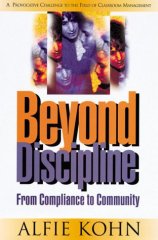 |
Beyond Discipline: From Compliance to Community
Author:
Kohn, Alfie
ISBN: 0-87120-270-0
LCCN:
96025265
Dewey: 371.5 20
Number:
|
Category: Philosophy of
education
User Rating: 3.5 Stars
Pages: 166
Paperback Association for Supervision & Curriculum Deve
Book Description What is most remarkable about the assortment of discipline
programs on the market today is the number of fundamental assumptions they seem
to share. Some may advocate the use of carrots rather than sticks; some may
refer to punishments as "logical consequences." But virtually all take for
granted that the teacher must be in control of the classroom, and that what we
need are strategies to get students to comply with the adult's expectations. In
this path-breaking book, Alfie Kohn calls these premises into question, and with
them the very idea of classroom "management." He questions the assumption that
problems in the classroom are always the fault of students who don't do what
they are told, suggesting that we might instead reconsider what they have been
told to do--or to learn. He shows how a fundamentally cynical view of children
lies beneath the assumption that we must tell them exactly how we expect them to
behave and then offer "positive reinforcement" when they obey. Just as
memorizing someone else's right answers fails to promote students' intellectual
development, so does complying with someone else's expectations for how to act
fail to help students develop socially or morally. Kohn contrasts the idea of
discipline, in which things are done to students to control their behavior, with
an approach in which we work with students to create caring communities where
decisions are made together. Packed with stories from real classrooms around the
country, seasoned with humor and grounded in a vision as practical as it is
optimistic, this book shows how students are most likely to flourish in schools
that have moved toward collaborative problem solving--and beyond discipline.
About the Author Alfie Kohn is the author of many other books about education
and human behavior, including Punished by Rewards, The Schools Our Children
Deserve, and Unconditional Parenting. --This text refers to the Paperback
edition.
Best: Self Esteem Activities for the Elementary Grades
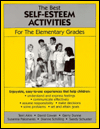 |
Best: Self Esteem Activities for the Elementary
Grades
Author: Akin, Terri (Editor) Schilling, Dianne Dunne,
Gerry Cowen, Dave Schuster, Sandy Cowen, Dave
ISBN:
0-9625486-2-6
LCCN:
Dewey:
Number:
|
Category: Sociology,
Social Studies
User Rating: 5.0 Stars
Pages: 218
Paperback Innerchoice Publishing
Book Description Over 100 of the most effective instructional strategies
available for helping students develop an accurate concept of who they are.
These easy to use activities directly enhance the self-esteem of students by
engaging them in experiences that develop a wide range of life and academic
skills and in the process build confidence and a strong sense of personal and
social responsibility. Written and designed for clarity and ease of
implementation, each activity includes behavioral objectives, step-by-step
instruction, a series of thought provoking discussion questions formulated to
elicit higher-level thinking, and reproducible student worksheets. Also included
are sections outlining recent research and related theory pertaining to the
critical importance of developing and enhancing self esteem. Grades K-8
The Best Schools: How Human Development Research Should Inform Educational
Practice
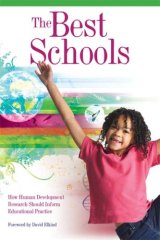 |
The Best Schools: How Human Development Research Should Inform
Educational Practice
Author: Armstrong, Thomas Elkind, David
(Foreword)
ISBN: 1-4166-0457-X
LCCN:
2006024184
Dewey: 370.15/23 22
Number:
|
Category: Educational
Psychology
User Rating: 4.0 Stars
Pages: 182
Paperback Association for Supervision & Curriculum Deve
Book Description Educators, politicians, parents, and even students are
consumed with speaking the language of academic achievement. Yet something is
missing in the current focus on accountability, standardized testing, and
adequate yearly progress. If schools continue to focus the conversation on rigor
and accountability and ignore more human elements of education, many students
may miss out on opportunities to discover the richness of individual exploration
that schools can foster. In The Best Schools, Armstrong urges educators to leave
narrow definitions of learning behind and return to the great thinkers of the
past 100 years-Montessori, Piaget, Freud, Steiner, Erikson, Dewey, Elkind,
Gardner-and to the language of human development and the whole child. The Best
Schools highlights examples of educational programs that are honoring students'
differences, using developmentally appropriate practices, and promoting a humane
approach to education that includes the following elements: *An emphasis on play
for early childhood learning. *Theme- and project-based learning for elementary
school students. 8Active learning that recognizes the social, emotional, and
cognitive needs of adolescents in middle schools. *Mentoring, apprenticeships,
and cooperative education for high school students. Educators in "the best
schools" recognize the differences in the physical, emotional, cognitive, and
spiritual worlds of students of different ages. This book will help educators
reflect on how to help each student reach his or her true potential, how to
inspire each child and adolescent to discover an inner passion to learn, and how
to honor the unique journey of each individual through life.
Best Practices for High School Classrooms: What Award-Winning Secondary
Teachers Do
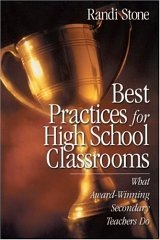 |
Best Practices for High School Classrooms: What Award-Winning
Secondary Teachers Do
Author: Stone, Randi
ISBN:
0-7619-7730-9
LCCN: 2001002166
Dewey: 373.1102
21
Number:
|
Category:
Educational resources & technology
User Rating: 5.0
Stars
Pages: 240
Paperback Corwin Press
Review "For those seeking practical activities that have been tested in
actual high school classrooms, Stone�s book is just what the teacher ordered.
Written in conversational style by award-winning teachers, this book does what
the Internet and discipline-specific teachers� organizations fail to do: it
consolidates exemplary teaching practices on diverse topics from various
academic fields into one easy-to-read resource." (CHOICE, June 2002 CHOICE, June
2002 ) "This book will be very helpful to new teachers and may motivate
experienced teachers to expand their craft. It would be a useful addition to any
high school professional collection, as it offers practical, down-to-earth
advice, while highlighting innovative and exciting teaching methods. The state
standards correlation sections are particularly beneficial." (Letitia Abram )
"This book is a priceless tool not only for teachers, but also for mentors and
administrators who responsibilities are to provide professional growth." (Danny
McPherson, Principal ) Review "For those seeking practical activities that have
been tested in actual high school classrooms, Stone's book is just what the
teacher ordered. Written in conversational style by "award-winning teachers"
this book does what the Internet and discipline-specific teachers' organizations
fail to do: it consolidates 'exemplary teaching practices' on diverse topics
from various academic fields into one easy-to-read resource."
Belonging: Self and Social Discovery for Children of All
Ages
|
Belonging: Self and Social Discovery for Children of All
Ages
Author: Derencenzi, Jayne Pendergast, Susan
Lyon-Wright, Linda
ISBN: 0-9623822-0-5
LCCN:
Dewey:
Number:
|
Category: General
User Rating: 5.0 Stars
Pages:
265
Paperback Belonging
The Basic School: A Community for Learning
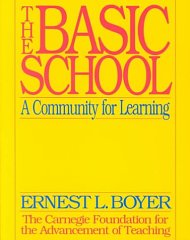 |
The Basic School: A Community for Learning
Author:
Boyer, Ernest L.
ISBN: 0-931050-48-0
LCCN:
95011506
Dewey: 372.973 20
Number:
|
Category: Sociology,
Social Studies
User Rating: 5.0 Stars
Pages: 288
Paperback Jossey-Bass
Includes bibliographical references (p. 209-246) and index.
Awakening Genius in the Classroom
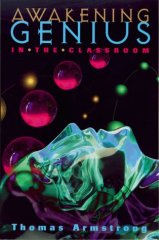 |
Awakening Genius in the Classroom
Author: Armstrong,
Thomas
ISBN: 0-87120-302-2
LCCN:
98019666
Dewey: 370.15/23 21
Number:
|
Category: Teaching skills
& techniques
User Rating: 4.0 Stars
Pages: 81
Paperback Association for Supervision & Curriculum Deve
Book Description "Every student is a genius," declares author Thomas
Armstrong, and an educator's most important job is to discover and nurture the
"genius qualities" that all students were born with but that may no longer be
obvious. Urging readers to look beyond traditional understandings of what
constitutes genius, Armstrong describes 12 such qualities: curiosity,
playfulness, imagination, creativity, wonder, wisdom, inventiveness, vitality,
sensitivity, flexibility, humor, and joy. He cites research in various fields
that supports this broader understanding of genius and explains how influences
in the home, the popular media, and the school itself "shut down" the genius in
students. Combining thoughtful insights and practical information, Armstrong
offers guiding principles to help educators awaken genius in the
classroom--beginning with awakening the genius in themselves. Readers will find
dozens of suggested activities and helpful resources to provide "genius
experiences" and create a "genial climate" in the classroom. In addition,
suggestions for further study at the end of each section provide starting points
for personal and professional reflection and growth. As it celebrates the
potential brainpower waiting to be unlocked in classrooms everywhere, Awakening
Genius in the Classroom inspires educators to look at their students from a
different perspective and to reinvigorate their teaching with a new sense of
excitement and possibility. The result, Armstrong concludes, could extend far
beyond the classroom and transform not only our schools, but the entire world.
Authentic Assessment: A Handbook for Educators
 |
Authentic Assessment: A Handbook for Educators
Author:
Hart, Diane
ISBN: 0-201-81864-7
LCCN:
93215508
Dewey: 371.2/6 20
Number:
|
Category: Nonfiction :
Education : Education Theory : Assessment
User Rating: 4.0
Stars
Pages: 600
Paperback Dale Seymour Pubn
Book Description An innovative guidebook that takes you beyond the usual
assessment buzzwords to an understanding of why educators are searching for
alternatives to standard assessment procedures.
Assessing Student Outcomes: Performance Assessment Using the Dimensions of
Learning Model
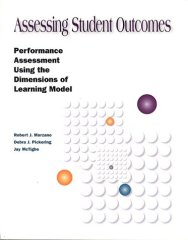 |
Assessing Student Outcomes: Performance Assessment Using the
Dimensions of Learning Model
Author: Marzano, Robert J.
Pickering, Debra McTighe, Jay McTighe, Jay Pickering, Debra
ISBN: 0-87120-225-5
LCCN:
Dewey:
Number:
|
Category:
Evaluation
User Rating: 3.0 Stars
Pages: 138
Paperback Association for Supervision & Curriculum Deve
Book Description The authors provide a brief introduction to the Dimensions
of Learning instructional model and then explain how it relates to lifelong
learning standards and the content standards developed for mathematics, science,
and other subjects. They include numerous examples of performance tasks that
help students meet the standards by requiring them to actively construct
knowledge for themselves. Teachers will especially appreciate the book's many
rubrics, which are four-point scales that teachers can use not only to assess
student performance on various tasks related to the five dimensions of learning,
but also to provide descriptive feedback that can help students improve their
performance. The book is printed in an 8" x 10" format so readers can easily
photocopy the rubrics and blank assessment forms in Part Two of the book.
Assessing and Reporting on Habits of Mind
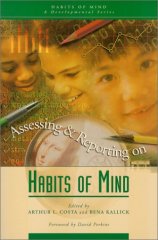 |
Assessing and Reporting on Habits of Mind
Author:
Costa, Arthur L. (Editor) Kallick, Bena (Editor)
ISBN:
0-87120-370-7
LCCN: 00010210
Dewey: 370.15/2
21
Number:
|
Category:
Educational Psychology
User Rating: 4.0 Stars
Pages:
135
Paperback Association for Supervision & Curriculum Deve
Internet Book Watch Assessing And Reporting On Habits Of Mind describes
children's behaviors that require specialized forms of assessment. Educators
Arthur Costa and Bena Kallick collaborate in showing how to assess and report
student progress in using the habits of mind. They reveal what teachers should
report; how the information should be reported; and who needs to know. Many
practical, classroom-tested assessment tools and approaches are available to
address these questions. Costa and Kallick persuasively maintain that a critical
attribute of intelligence is not only having information, but also knowing how
to act on it. Assessing And Reporting On Habits Of Mind is highly recommended
reading for students in teaching education programs as well as the practicing
classroom instructor, preschool through high school.
Asking the Right Questions: Tools and Techniques for
Teamwork
 |
Asking the Right Questions: Tools and Techniques for
Teamwork
Author: Holcomb, Edie L.
ISBN:
0-8039-6358-0
LCCN: 95043337
Dewey: 371.3/95
20
Number:
|
Category:
Management & management techniques
User Rating: 5.0
Stars
Pages: 144
Paperback Corwin Press
Product Description "Edie Holcomb has extensive experience in the change
process--what she teaches actually works." Deb Larson and Tom Mooney, Members
The School District of McFarland's K-12 Improvement Committee McFarland,
Wisconsin Describes the essential aspects of school change in simple,
straightforward language. Provides common starting ground for educators who have
similar goals but different skills. Includes real-world examples along with an
annotated bibliography for locating research-based references. Holcomb gives you
the information you need to ask and answer the hard questions * What do we want
from school change? * How does our school compare with what we want? * Where
should we start? * How do we measure our progress? * How can we stay focused and
not let our efforts become diluted? Helps you answer these questions:* Where are
we now?* Where do we want to go?* How will we get there?* How will we know we
are "getting there"?* How can we sustain the focus and momentum we're building?
Holcomb gives you group processes that really work and lists tips for
facilitators and team leaders. A matrix helps you review available skills and
determine what additional skills and training your team may need. This compact,
"how-to" guide contains anecdotal examples from actual schools to help you
through the tough spots and stay focused as you lead your staff toward lasting
change. If you're looking to build a team for school-based change, this book is
for you. It has the tools and practical, down-to-earth advice you need to begin
the complex process of change in your school or district. About the Author Edie
L. Holcomb is executive director of curriculum and instructional services for
Kenosha Unified School District No. 1 in Kenosha, Wisconsin. She has experienced
the challenges of improving student achievement from many perspectives: From
classroom teacher to university professor From gifted education coordinator to
mainstream teacher of children with multiple disabilities From school- and
district-level administration to national and international consulting From
small rural districts to the challenges of urban education She is highly
regarded for her ability to link research and practice on issues related to
instructional leadership and school and district change�including
standards-based curriculum, instruction, assessment, supervision, and
accountability. She has taught at all grade levels, served as a building
principal and central office administrator, and assisted districts as an
external facilitator for accreditation and implementation of school reform
designs. As associate director of the National Center for Effective Schools, she
developed a training program for site-based teams and provided technical support
for implementation of school improvement efforts throughout the United States
and in Canada, Guam, St. Lucia, and Hong Kong. She developed a comprehensive
standards-based learning system for the staff and 47,000 students of the
Seattle, Washington, city district and has supervised K�12 clusters of schools
and evaluated principals. Her work received the Excellence in Staff Development
Award from the Iowa Association of Supervision and Curriculum Development in
1988. In 1990, her study of the needs of beginning principals was recognized by
the American Association of School Administrators with the Paul F. Salmon Award
for Outstanding Education Leadership Research. She served as an elected
member-at-large on the Leadership Council for ASCD International, played an
active role in Washington State�s School Improvement Assistance Program, and
contributed to development of the new School System Improvement Resource Guide.
Holcomb is the author of four previous books and numerous articles and reviews.
Arts With the Brain in Mind
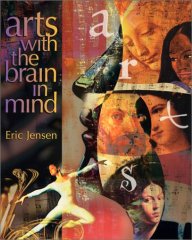 |
Arts With the Brain in Mind
Author: Jensen, Eric
ISBN: 0-87120-514-9
LCCN: 2001000735
Dewey:
700/.71/273 21
Number:
|
Category: Study & learning skills
User Rating:
4.0 Stars
Pages: 139
Paperback Association for Supervision & Curriculum Deve
Book Description How do the arts stack up as a major discipline? What is
their effect on the brain, learning, and human development? How might schools
best implement and assess an arts program?? Eric Jensen answers these questions
C and more C in this book. To push for higher standards of learning, many
policymakers are eliminating arts programs. To Jensen, that's a mistake. This
book presents the definitive case, based on what we know about the brain and
learning, for making arts a core part of the basic curriculum and thoughtfully
integrating them into every subject. Separate chapters address musical, visual,
and kinesthetic arts in ways that reveal their influence on learning. What are
the effects of a fully implemented arts program? The evidence points to the
following: $ Fewer dropouts $ Higher attendance $ Better team players $ An
increased love of learning $ Greater student dignity $ Enhanced creativity $ A
more prepared citizen for the workplace of tomorrow $ Greater cultural awareness
as a bonus To Jensen, it's not a matter of choosing, say, the musical arts over
the kinesthetic. Rather, ask what kind of art makes sense for what purposes. How
much time per day? What kind of music? Should the arts be required? How do we
assess arts programs? In answering these real-world questions, Jensen provides
dozens of practical, detailed suggestions for incorporating the arts into every
classroom. Download Description "How do the arts stack up as a major discipline?
What is their effect on the brain, learning, and human development? How might
schools best implement and assess an arts program?" Eric Jensen answers these
questions--and more--in this book. To push for higher standards of learning,
many policymakers are eliminating arts programs. To Jensen, that's a mistake.
This book presents the definitive case, based on what we know about the brain
and learning, for making arts a core part of the basic curriculum and
thoughtfully integrating them into every subject. Separate chapters address
musical, visual, and kinesthetic arts in ways that reveal their influence on
learning. What are the effects of a fully implemented arts program? The evidence
points to the following: * Fewer dropouts * Higher attendance * Better team
players * An increased love of learning * Greater student dignity * Enhanced
creativity * A more prepared citizen for the workplace of tomorrow * Greater
cultural awareness as a bonus To Jensen, it's not a matter of choosing, say, the
musical arts over the kinesthetic. Rather, ask what kind of art makes sense for
what purposes. How much time per day? At what ages? What kind of music? What
kind of movement? Should the arts be required? How do we assess arts programs?
In answering these real-world questions, Jensen provides dozens of practical,
detailed suggestions for incorporating the arts into every classroom.
Amazing Grace: Lives of Children and the Conscience of a Nation,
The
 |
Amazing Grace: Lives of Children and the Conscience of a Nation,
The
Author: Kozol, Jonathan
ISBN:
0-06-097697-7
LCCN: 96016817
Dewey: 362.7/09747/1
20
Number:
|
Category:
Social Science
User Rating: 4.0 Stars
Pages: 304
Paperback Harper Perennial
From Publishers Weekly Kozol (Savage Inequalities) began visiting New York's
South Bronx in 1993, focusing on Mott Haven, a poor neighborhood that is two
thirds Hispanic, one third black. This disquieting report graphically portrays a
world where babies are born to drug-using mothers with AIDS, where children are
frequently murdered, jobs are scarce and a large proportion of the men are
either in prison or on crack cocaine or heroin. Kozol interviewed ministers,
teachers, drug pushers, children who have not yet given up hope. His powerfully
understated report takes us inside rat-infested homes that are freezing in
winter, overcrowded schools, dysfunctional clinics, soup kitchens. Rejecting
what he calls the punitive, blame-the-poor ideology that has swept the nation,
Kozol points to systemic discrimination, hopelessness, limited economic
opportunities and New York City Mayor Rudolph Giuliani's cutbacks in social
services as causes of this crisis. While his narrative offers no specific
solutions, it forcefully drives home his conviction: a civilized nation cannot
allow this situation to continue. Author tour. Copyright 1995 Reed Business
Information, Inc. --This text refers to an out of print or unavailable edition
of this title. From Library Journal Alicea and Kozol paint a vivid portrait of
life in one of America's most impoverished neighborhoods, New York City's South
Bronx. While telling similar stories, each narrative has its own unique flavor
and characteristics that reveal the crushing nature of poverty in America and
recount the lives of those who rise above it. Kozol (Savage Inequalities, LJ
9/15/91) describes a neighborhood ravaged by drugs, violence, hunger, AIDS, and
antipathy but also one where children defy all the stereotypes. In the South
Bronx, where the median income is $7600 a year and everything breaks down, Kozol
reveals that the one thing that has remained resilient is the children. One of
the resident children is 15-year-old Alicea, who saw his mother and sister
succumb to AIDS, a father incarcerated in prison, and friends entrapped by drugs
or violence. Like that of many children, his story is a life of options or
despair. The path they pursue is dependent on government leadership. Both books
should be required reading for policymakers and those concerned with the plight
of the American poor.?Michael A. Lutes, Univ. of Notre Dame Lib., Ind. Copyright
1995 Reed Business Information, Inc. --This text refers to an out of print or
unavailable edition of this title.
All I Really Need to Know I Learned in Kindergarten: Uncommon Thoughts on
Common Things
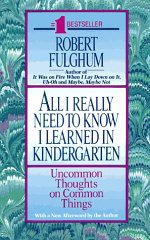 |
All I Really Need to Know I Learned in Kindergarten: Uncommon
Thoughts on Common Things
Author: Fulghum, Robert
ISBN: 0-449-90857-7
LCCN: 93090035
Dewey:
128 20
Number:
|
Category: Inspirational - General
User Rating: 4.0
Stars
Pages: 224
Paperback Ballantine Books
From Publishers Weekly Of these "random jottings," PW said, "Fulghum does not
express uncommon thoughts here: his thoughts are those we all wish were true."
The book's tone is set by the title piece in which the author sets out his banal
credos, ranging from "share everything" to "hold hands and stick together."
Copyright 1989 Reed Business Information, Inc. --This text refers to an out of
print or unavailable edition of this title. From Library Journal Unitarian
minister Fulghum has become something of a celebrity since a talk he gave at a
primary school graduation ("Share everything. Play fair. . . . LOOK.") generated
such interest that it ultimately found its way into "Dear Abby." Here is more of
his philosophyalways go with dreams, imagination, hope, laughter, and
loveaccompanied by random musings on dandelions, medicine cabinets, and the
vices of excessive tidiness, which are quirky and often thought-provoking.
Undergirded by his love for family and (loosely understood) for God, this makes
refreshing reading. EC Copyright 1988 Reed Business Information, Inc. --This
text refers to an out of print or unavailable edition of this title.
ADD/ADHD Alternatives in the Classroom
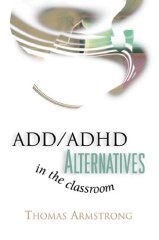 |
ADD/ADHD Alternatives in the Classroom
Author:
Armstrong, Thomas
ISBN: 0-87120-359-6
LCCN:
99006861
Dewey: 371.93 21
Number:
|
Category: Special
Education - Learning Disabled
User Rating: 5.0 Stars
Pages:
126
Paperback Association for Supervision & Curriculum Deve
Book Description What does it mean to a kid to be labeled attention-deficit
disordered (ADD)? Or to have "hyperactive" added to the label (ADHD)? What can
teachers do to boost the success of students with attention and behavioral
difficulties? Are we relying too much on medication for these kids and not
enough on new perspectives on learning, child development, the child's
socioeconomic and cultural background, biological and psychological research,
and the learner's emotional and social needs? Armstrong urges educators and
parents to look for the positive characteristics in learners who may carry the
ADD/ADHD label. Are they bursting with energy? Are they intensely creative? Do
they enjoy hands-on learning? Are they natural leaders? Are they unusually
introspective and reflective? We need to look beyond a "deficit" approach and
embrace a more holistic view of learners that includes teaching to their
multiple intelligences, learning styles, and other brain-friendly approaches.
For example, here are some classroom activities for kids who "can't sit still":
- Learning spelling words by having kids jump up out of their seats on the
vowels and sit down on the consonants. - Mastering the multiplication tables by
forming a conga line, moving around the classroom counting from 1 to 30 out
loud, and on every multiple of 3 shaking their hips and legs. - Showing patterns
of molecular bonding in chemistry class through a "swing your atom" square
dance. Thomas Armstrong, an educator and psychologist from Sonoma County,
California, has more than 26 years of teaching experience, from the primary
through the doctoral level. He is the author of two other ASCD books, "Multiple
Intelligences in the Classroom" and "Awakening Genius in the Classroom."
Activating & Engaging Habits of Mind
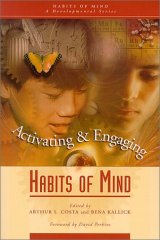 |
Activating & Engaging Habits of Mind
Author:
Perkins, David (Foreword) Costa, Arthur L. (Editor) Kallick, Bena
(Editor)
ISBN: 0-87120-369-3
LCCN:
00009346
Dewey: 155.4/13 21
Number:
|
Category: Educational
Psychology
User Rating: 4.0 Stars
Pages: 167
Paperback Association for Supervision & Curriculum Deve
"ASCD product no. 100033"--T.p. verso. Includes bibliographical references
and index.
Achievement Testing in the Early Grades: The Games Grown-Ups
Play
 |
Achievement Testing in the Early Grades: The Games Grown-Ups
Play
Author: Kamii, Constance (Editor)
ISBN:
0-935989-32-3
LCCN: 89064092
Dewey: 372.12/64
20
Number:
|
Category:
Elementary
User Rating: 3.0 Stars
Pages: 182
Paperback National Association for the Education of You
"A 1989-1990 comprehensive membership benefit." Includes bibliographical
references (p. 178-181).
The 7 Habits of Highly Effective People
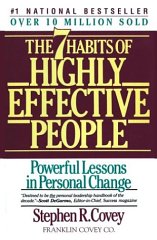 |
The 7 Habits of Highly Effective People
Author:
Covey, Stephen R.
ISBN: 0-671-70863-5
LCCN:
00500030
Dewey:
Number:
|
Category: Advice on
careers & achieving success
User Rating: 4.5 Stars
Pages:
358
Paperback Free Press
Amazon.com The 7 Habits of Highly Effective People: Powerful Lessons in
Personal Change was a groundbreaker when it was first published in 1990, and it
continues to be a business bestseller with more than 10 million copies sold.
Stephen Covey, an internationally respected leadership authority, realizes that
true success encompasses a balance of personal and professional effectiveness,
so this book is a manual for performing better in both arenas. His anecdotes are
as frequently from family situations as from business challenges. Before you can
adopt the seven habits, you'll need to accomplish what Covey calls a "paradigm
shift"--a change in perception and interpretation of how the world works. Covey
takes you through this change, which affects how you perceive and act regarding
productivity, time management, positive thinking, developing your "proactive
muscles" (acting with initiative rather than reacting), and much more. This
isn't a quick-tips-start-tomorrow kind of book. The concepts are sometimes
intricate, and you'll want to study this book, not skim it. When you finish,
you'll probably have Post-it notes or hand-written annotations in every chapter,
and you'll feel like you've taken a powerful seminar by Covey. --Joan Price
Amazon.com Audiobook Review Anyone who thinks the audiocassette adaptation of
Stephen Covey's bestseller, The 7 Habits of Highly Effective People, is a
shortcut to reading the book has another thing coming. As a preview, the
cassette is worth every one of its 90 minutes; as a substitute for the original,
it will only leave you wishing for the rest. There's a reason 7 Habits has sold
more than 5 million copies and been translated into 32 languages. Serious work
has obviously gone into it, and serious change can likely come out of it--but
only with constant discipline and steadfast commitment. As the densely packed
tape makes immediately clear, this is no quick fix for what's ailing us in our
personal and professional lives. The tape opens to the silky-smooth, overtrained
voice of the female narrator, who's responsible for tying together audio clips
from actual Covey seminars. Leaving aside the occasional attempts at promoting
Covey and his institute, her script does a first-rate job of making sense of
Covey's own intense, analogy-rich style of explaining his habits. There's
nothing simple about his approach to becoming an effective person. The first
three habits alone--which have to do with personal responsibility, leadership,
and self-management--could take years to master. Yet the last four are
unattainable, the narrator insists, if you can't acquire the personal
security--the "inner core," says Covey--that presumably comes from a mastery of
the foundation. Throughout our lessons, Covey's presence is both learned and
thoroughly appealing. He drops references to the likes of Socrates, T.S. Eliot,
and Robert Frost with the aplomb of an English professor. And his knack for
mixing everyday stories with abstract concepts manages to clarify difficult
issues while respecting our intelligence. You could argue that the cassette is
nothing more than a clever marketing tool for selling another few million copies
of the book. But, even at that, it's worth the investment in time and
concentration: in the end, we're moved to learn more about integrating all seven
habits in our struggle to become better and, yes, more effective people.
(Running time: 1.5 hours, one cassette) --Ann Senechal --This text refers to the
Audio Cassette edition.
The 5 Step Way to Raise Test Scores
 |
The 5 Step Way to Raise Test Scores
Author: East, Pam
C.
ISBN: 1-884548-81-4
LCCN:
Dewey:
Number:
|
Category:
User Rating: 3.5 Stars
Pages: 72
Paperback Crystal Springs Books
Product Description Many teachers look at standardized tests as something to
be dreaded. Author, Pam East looks at standardized-test scores and sees a tool
to bring students learning to new heights.
44 Routines that Make A Difference : Strategies for the Effective
Classroom
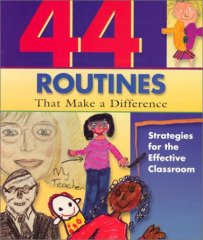 |
44 Routines that Make A Difference : Strategies for the Effective
Classroom
Author: Institute, School Renaissance Sebok,
George
ISBN: 1-893751-61-9
LCCN:
2001271026
Dewey: 371.102 21
Number:
|
Category: Teaching
Methods & Materials - General
User Rating: 5.0 Stars
Pages:
65
Paperback School Renaissance Institute
Carolyn Stults, South Clinton Elementary School, Clinton, TN "I loved this
book! What a quick, easy way to be reminded of things I'd forgotten..." Debra
McCarty Julka, Sauk Prairie High School, Prairie Du Sac, WI "With chalk in one
hand and 44 Routines in the other, every teacher will have the keys to classroom
success."
35 Rubrics & Checklists to Assess Reading and
Writing
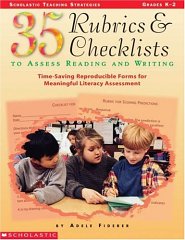 |
35 Rubrics & Checklists to Assess Reading and
Writing
Author: Fiderer, Adele
ISBN:
0-590-13102-8
LCCN:
Dewey:
Number:
|
Category: Science
fiction
User Rating: 3.5 Stars
Pages: 80
Paperback Scholastic Teaching Resources
Product Description Documenting students' work in reading, writing, and
integrated projects is quick, clear, and easy with these 35 classroom-tested
rubrics. Drawing on her extensive experience as a teacher, the author shares
step-by-step directions for using them. Share them with students so they know
the qualities of a good performance, share them with parents to give them a
detailed picture of their children's progress. For use with Grades K-2.
21st Century Mentor's Handbook
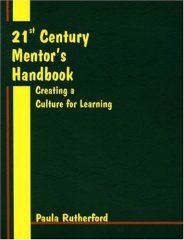 |
21st Century Mentor's Handbook
Author: Rutherford,
Paula
ISBN: 0-9663336-6-7
LCCN:
2005900289
Dewey: 371.102 22
Number:
|
Category:
Education
User Rating: 5.0 Stars
Pages: 378
Paperback Just ASK Publications
Charlotte Jackson, Principal Finally a resource that is practical, timely and
on target for every current educational topic! Book Description This mentor's
handbook, field tested by hundreds of mentors, provides a multitude of resources
to help mentors promote the success and professional growth of new teachers.
Resources included are: + New teacher tools including needs assessments,
self-assessments, and goal setting and reflection formats + Tools for peer
observation and data-driven discussions + Mentoring calendar + Mentor responses
to challenges and concerns of new teachers +Cross-references the highly
acclaimed new teacher resource Why Didn't I Learn This in College? CD ROM of
tools
"I Won't Learn from You": And Other Thoughts on Creative
Maladjustment
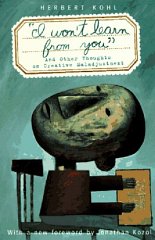 |
"I Won't Learn from You": And Other Thoughts on Creative
Maladjustment
Author: Kohl, Herbert R.
ISBN:
1-56584-095-X
LCCN: 93083618
Dewey: 371.3
20
Number:
|
Category:
Educational Psychology
User Rating: 4.5 Stars
Pages:
153
Hardcover New Press
From Publishers Weekly Despite the social and economic despair that pervades
many U.S. public schools, meaningful learning and teaching are nevertheless
possible, declares famed educator Kohl. To overcome the "massive rejection of
schooling by students from poor and oppressed communities," Kohl ( 36 Chil dren
), in these five inspirational, optimistic essays, outlines teaching strategies
designed to unlock students' energy, intelligence and drive by encouraging them
to envision ways to improve their world. He believes that both teachers and
students should cultivate "creative maladjustment," channeling personal
discontent into moral or political action. Kohl defends multiculturalist
curricula as central to the struggle for fairness. Turning to higher education,
he argues that issues of academic freedom and "political correctness" are used
by neoconservatives to mask their desire to control ideas in the university and
to push out ethnic and women's studies. Copyright 1994 Reed Business
Information, Inc. From Kirkus Reviews The five essays in this book are powerful
reminders that currently popular ideas of school choice may be only another
trendy veneer disguising the deeply rooted problems of public education. Teacher
Kohl (From Archetype to Zeitgeist, 1992, etc.) is an ardent spokesman on behalf
of students, the people most neglected in debates about failures in the
classrooms. The title essay explores the provocative idea that ``not-learning''
is a conscious choice made by children who observe, sometimes very early, that
the school system is trying to impose on them values and behavior that are
foreign and sometimes repugnant to them. Diagnosed as learning- disabled,
stupid, or disciplinary problems, children who appear not to be able to learn to
read or do math may simply have opted out of the system, choosing instead to put
their intelligence and creativity to work outside school. In ``The Tattooed
Man,'' he asserts that, before anything else can be accomplished, teachers must
challenge the hopelessness felt by students. The ``norming of excellence'' and
political correctness are the subjects of two other essays, accompanied by a
devastating critique of E.D. Hirsch, Jr.'s Cultural Literacy and Core Knowledge
series. Kohl attacks Hirsch's material as not only racist and sexist, but
``pernicious, stupid, and dangerous.'' Martin Luther King, Jr.'s call to be
``maladjusted'' to injustice and inequity is the theme of the last essay.
``Creative maladjustment'' consists of ``learning to survive with minimal moral
and personal compromise in a thoroughly compromised world,'' says Kohl. In such
a world, he argues, the failure of schools and teachers is often pinned on
children--by diagnosing them with Attention Deficit Disorder, for example. He
challenges teachers to take action by, for instance, refusing to turn such
children over to special education classes. Some anecdotes and examples are
repeated from earlier works, but this is must reading for Kohl fanciers and
anyone looking for the humanity buried in the long debate about why Johnny can't
read. -- Copyright ©1994, Kirkus Associates, LP. All rights reserved.
The "Having of Wonderful Ideas" and Other Essays on Teaching and
Learning
|
The "Having of Wonderful Ideas" and Other Essays on Teaching and
Learning
Author: Duckworth, Eleanor
ISBN:
0-8077-2876-4
LCCN: 87018921
Dewey: 371.1/02
19
Number:
|
Category:
Philosophy of education
User Rating: 3.5 Stars
Pages:
168
Paperback Teachers College Pr
Bibliography: p. 141-145. Includes index. The having of wonderful ideas --
The language & thought of Piaget, & some comments on learning to spell
-- Either we're too early & they can't learn it, or we're too late &
they know it already -- A child's-eye view of knowing -- The virtues of not
knowing -- Learning with breadth & depth -- Understanding children's
understanding -- Structures, continuity, & other people's minds -- Making
sure that everybody gets home safely -- Teaching as research.